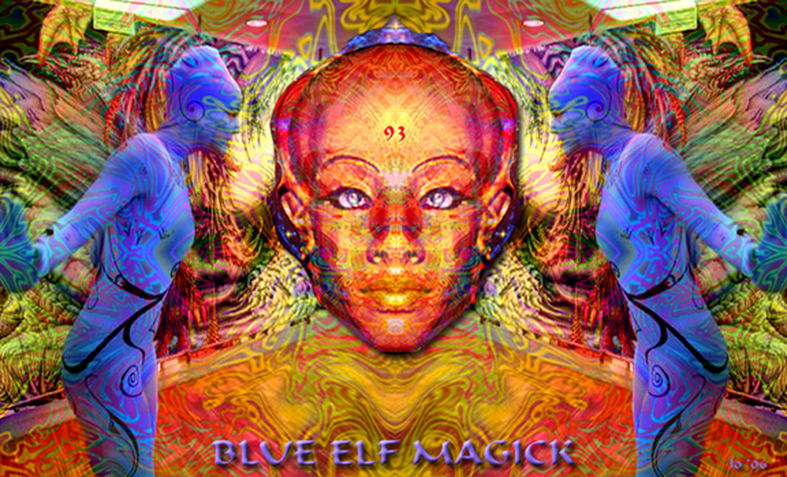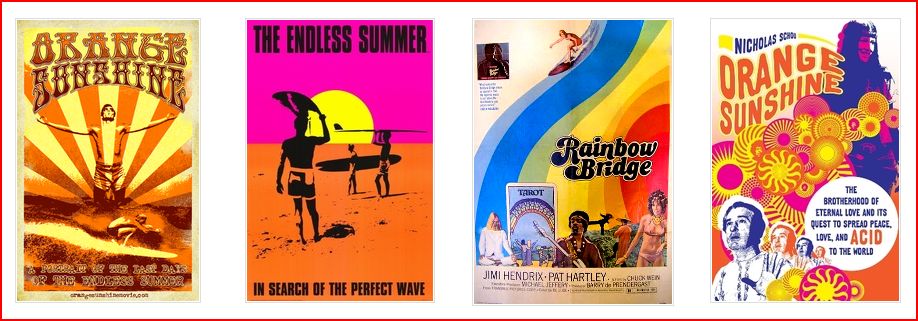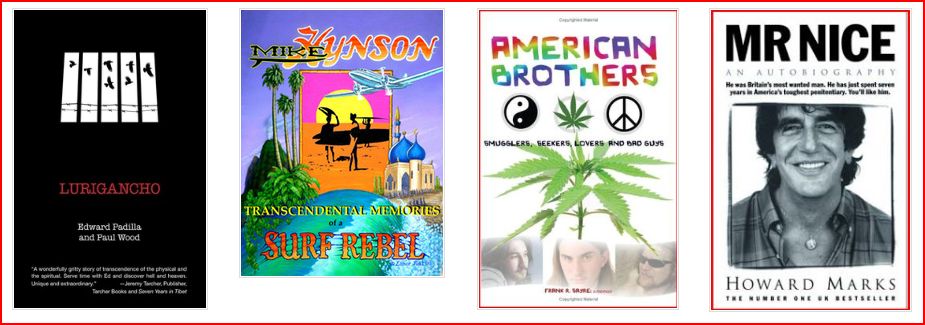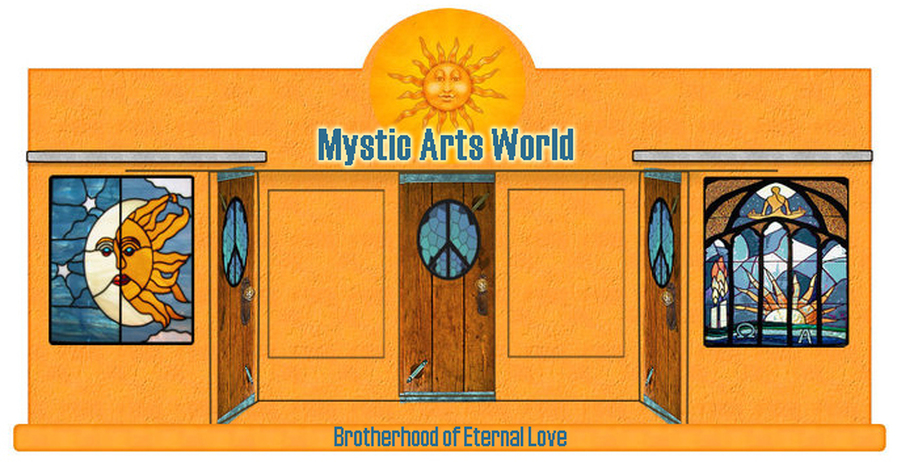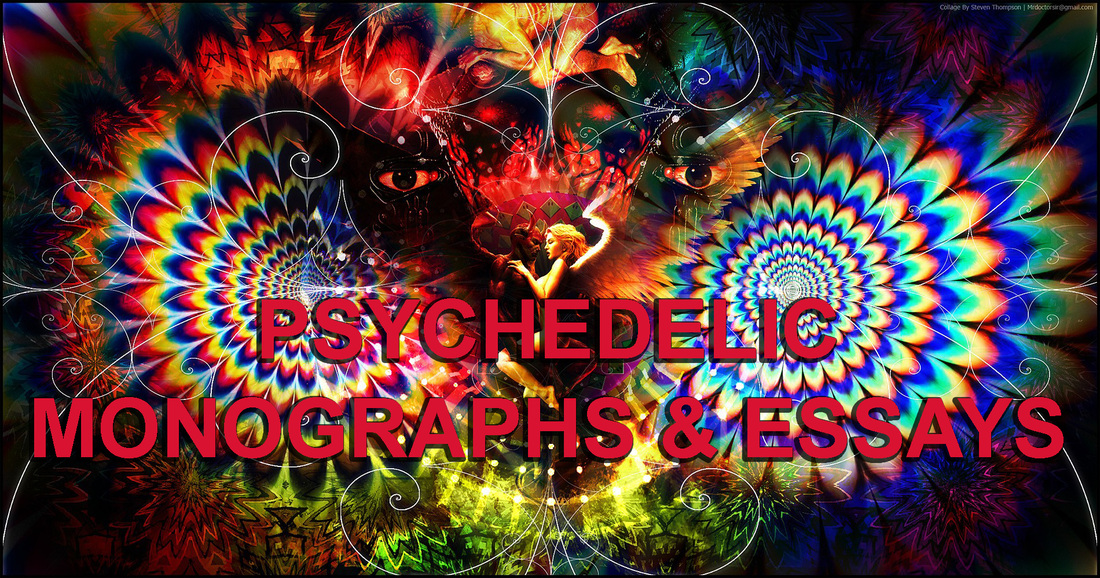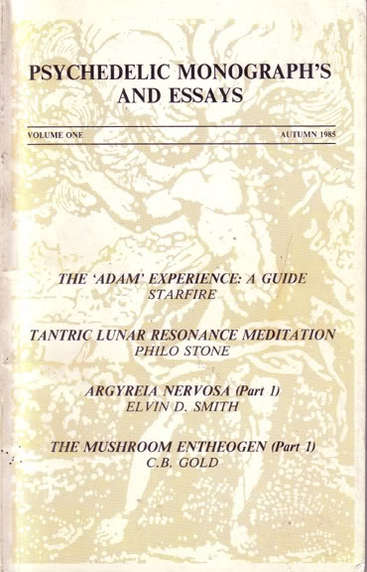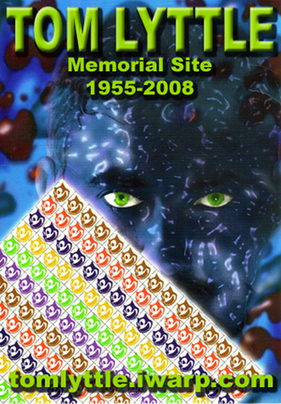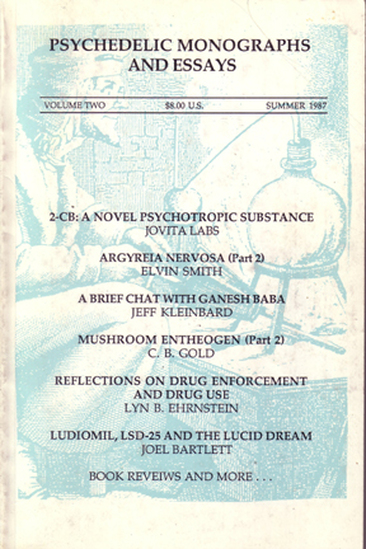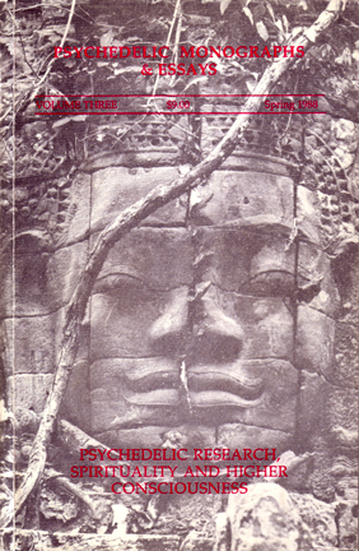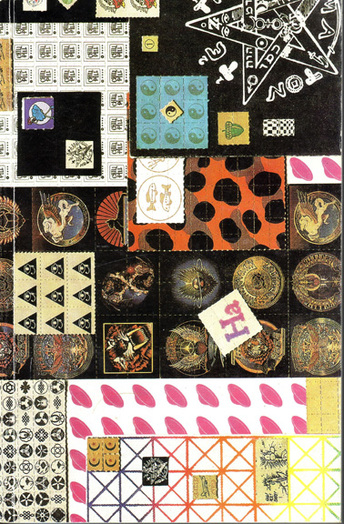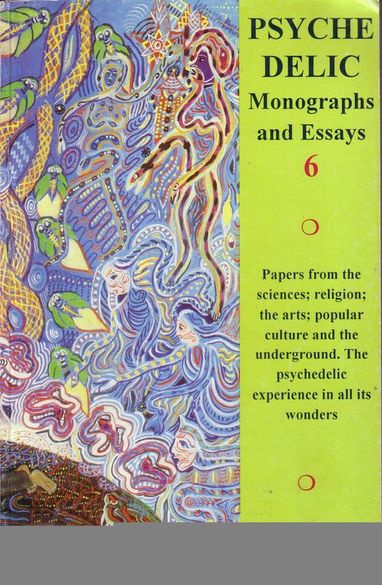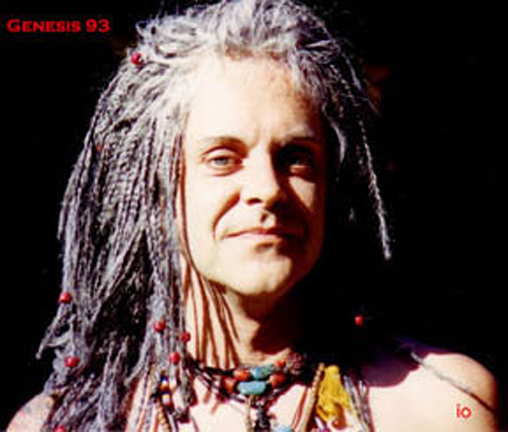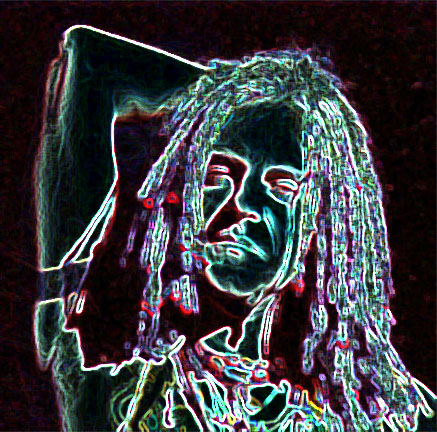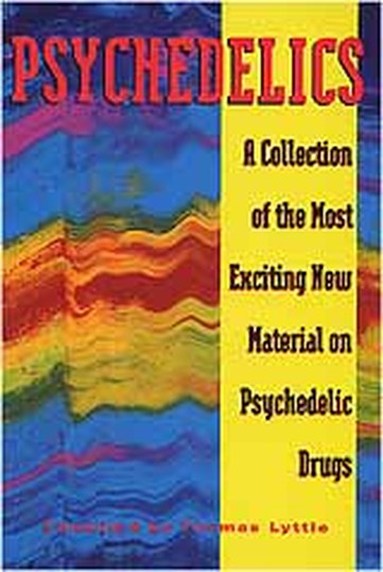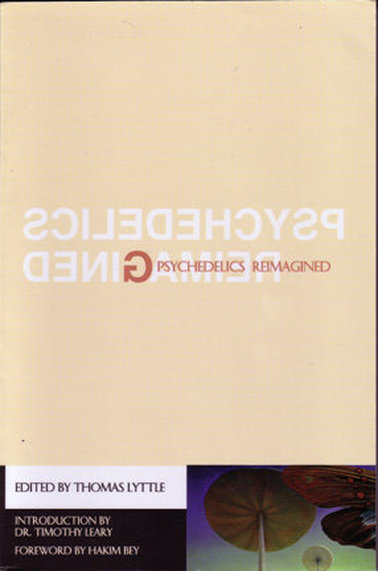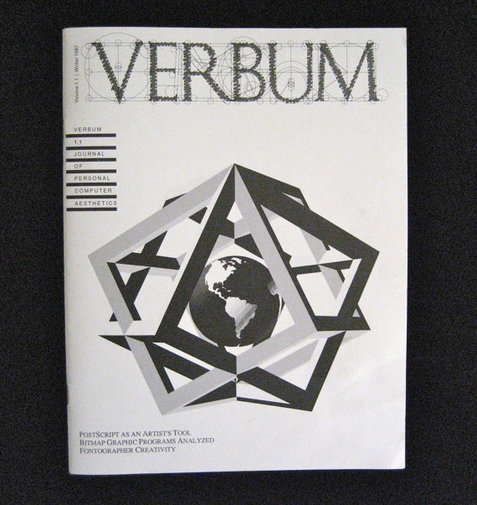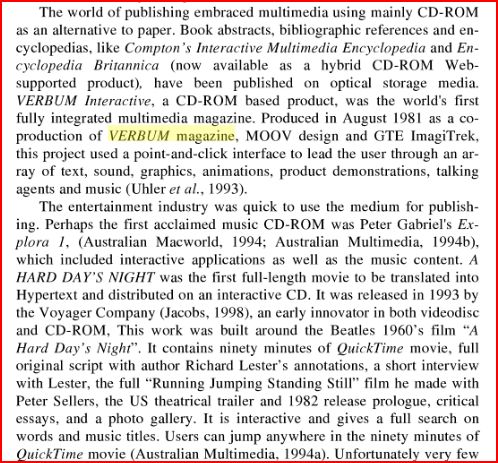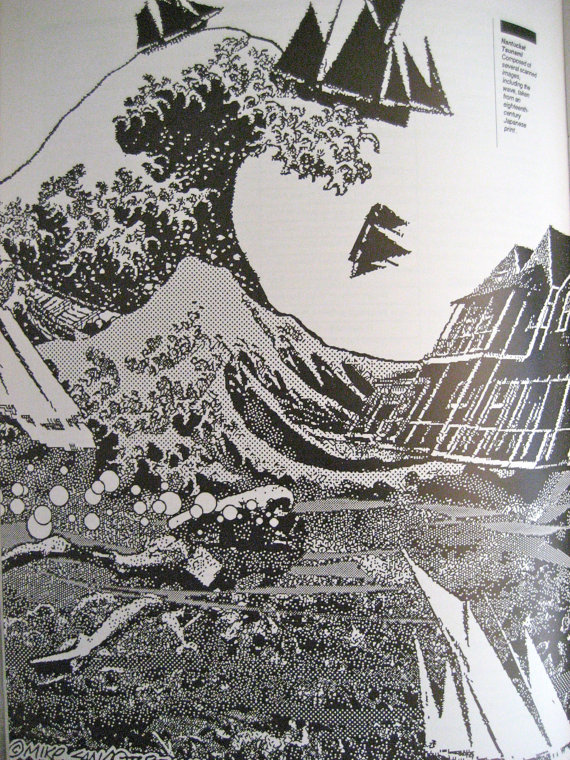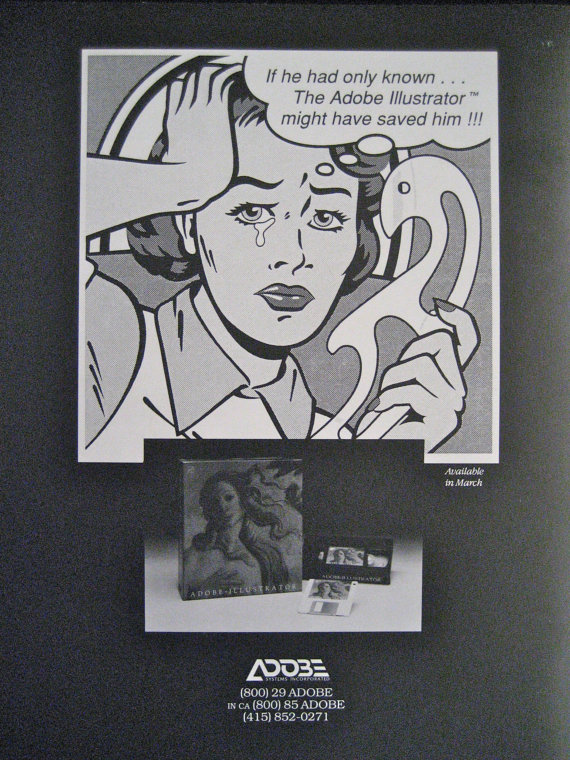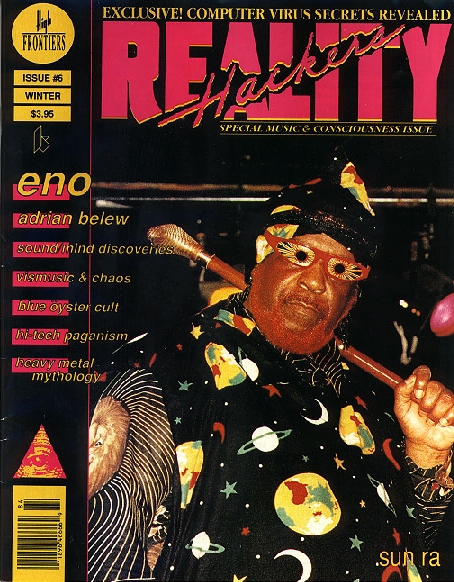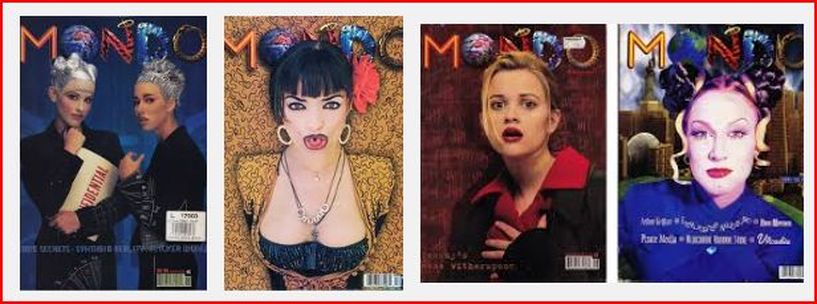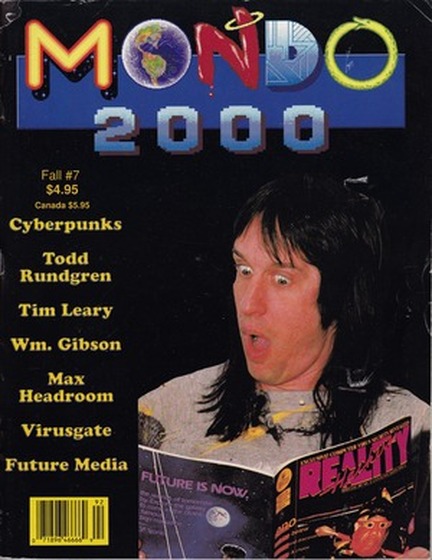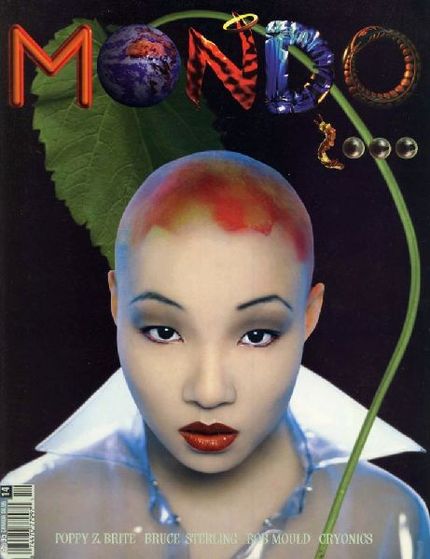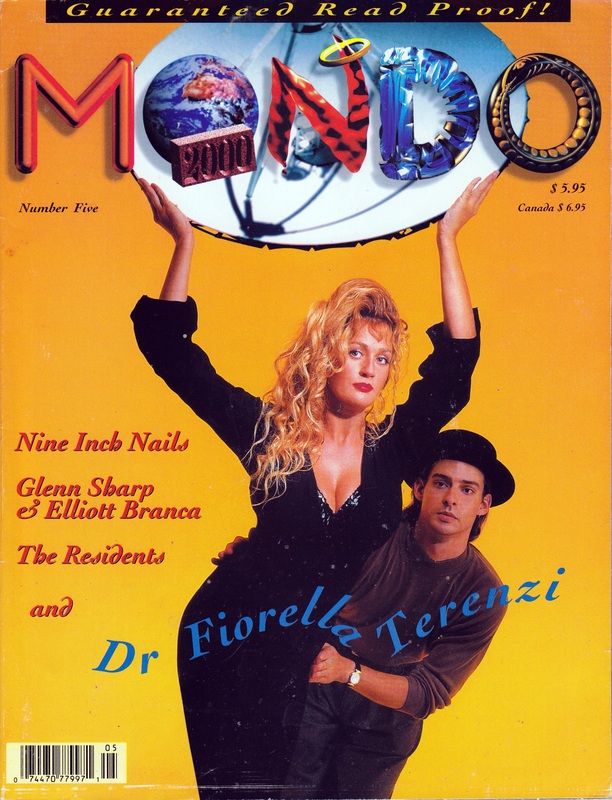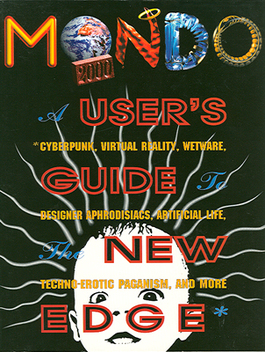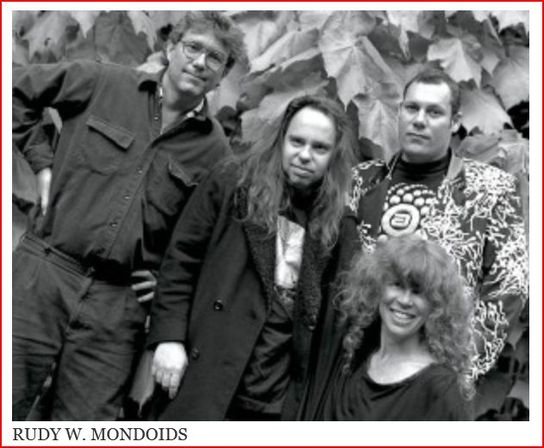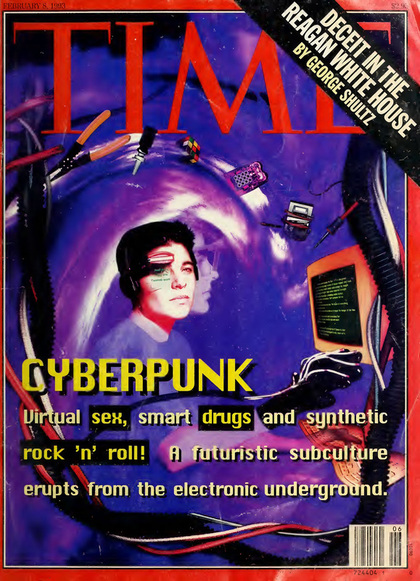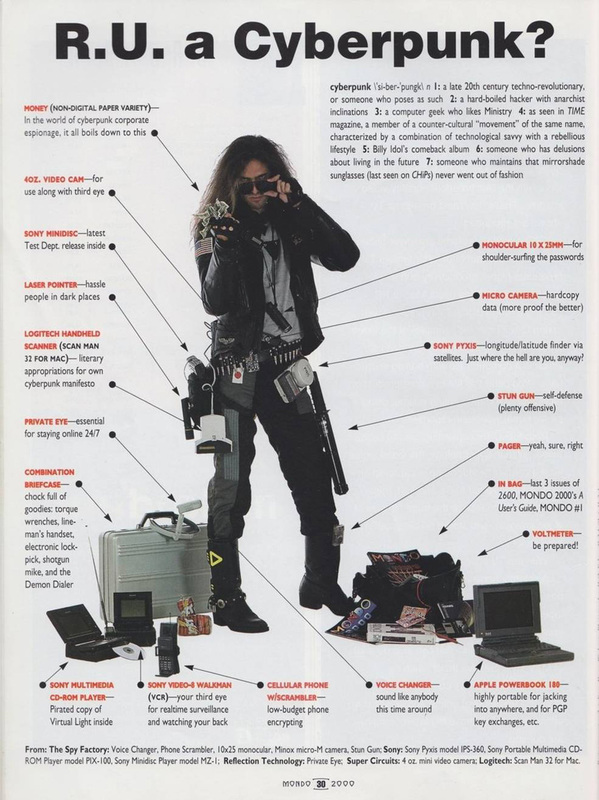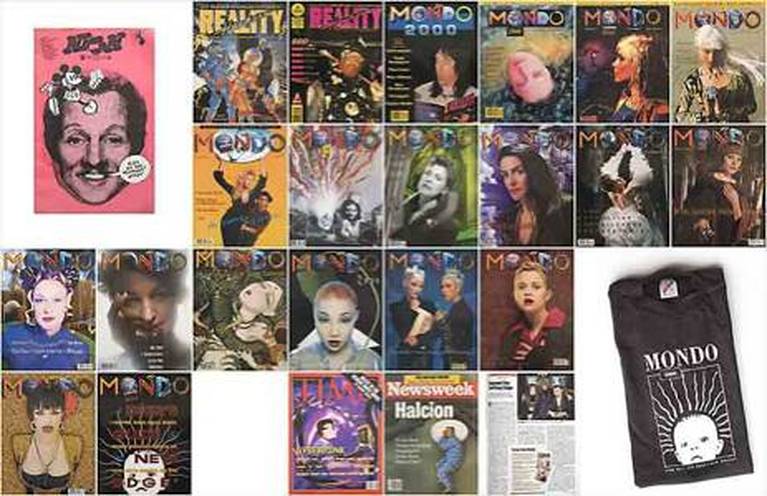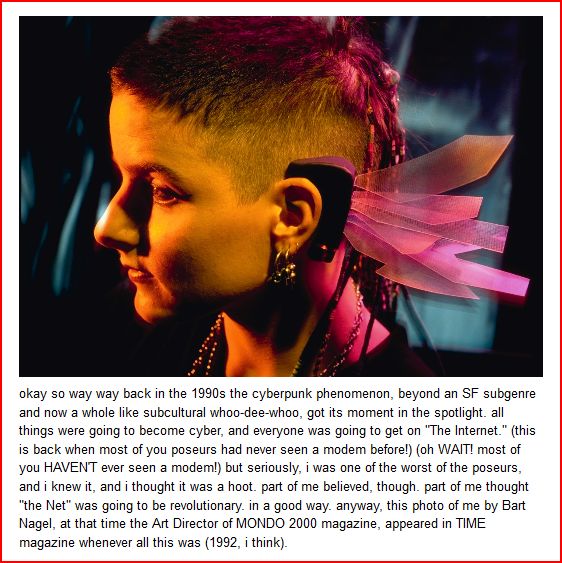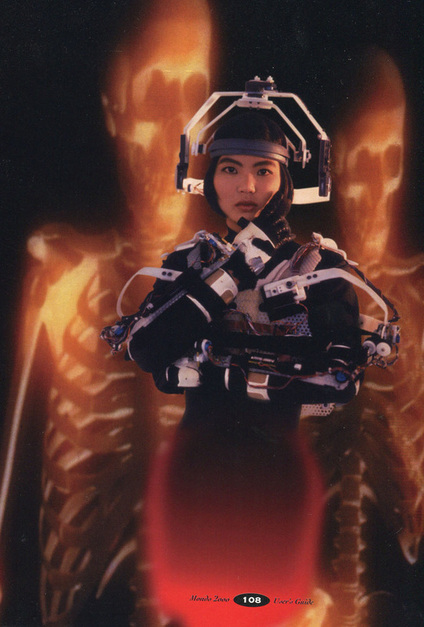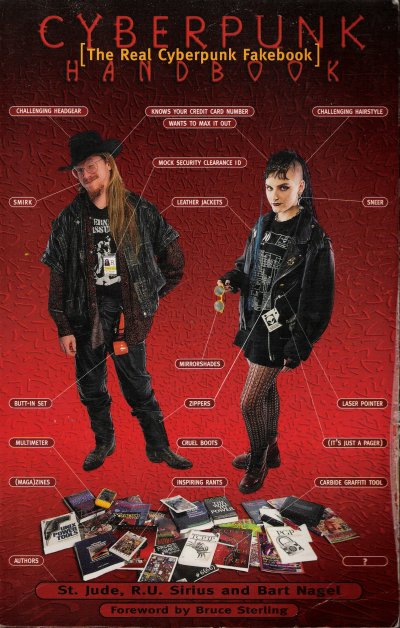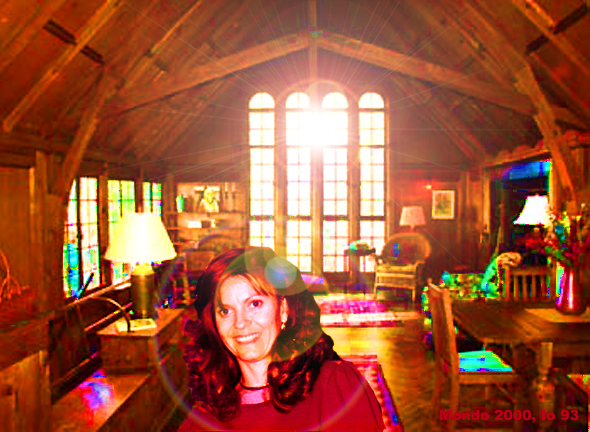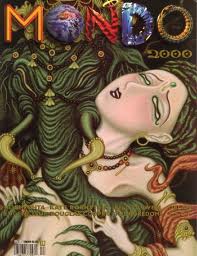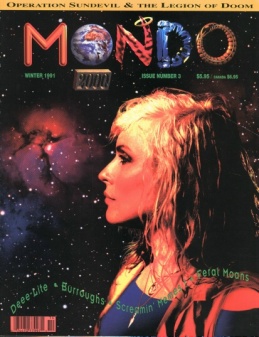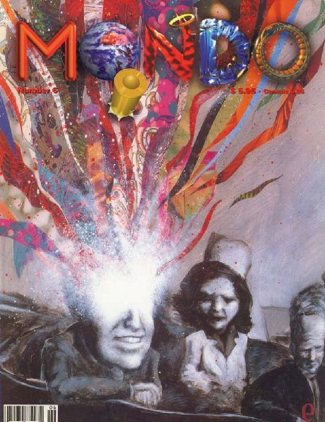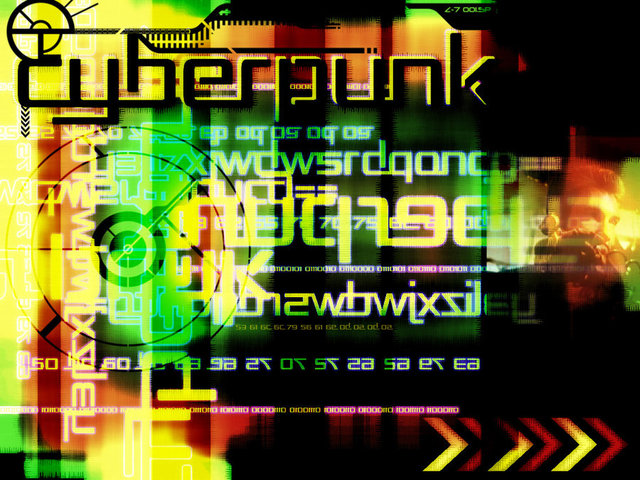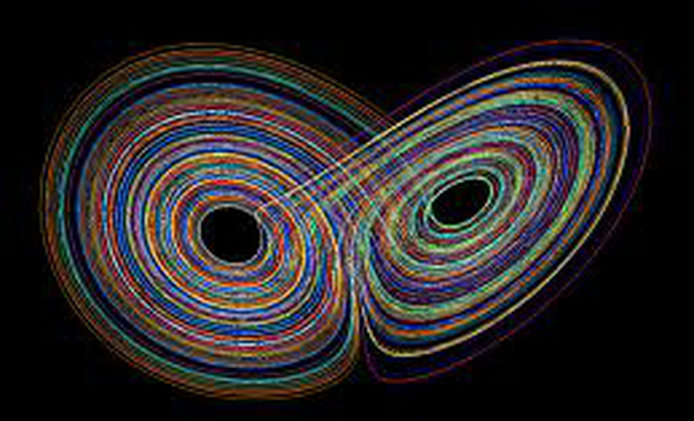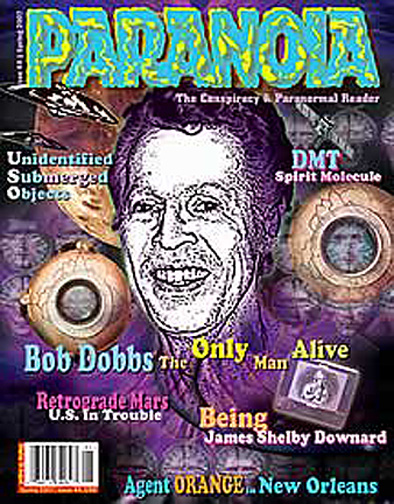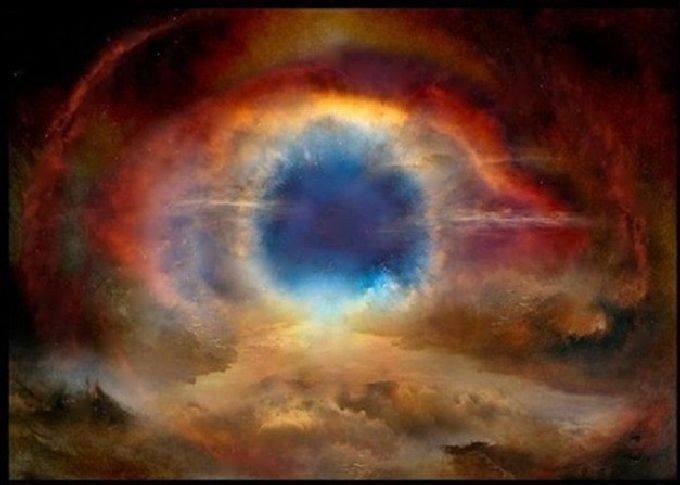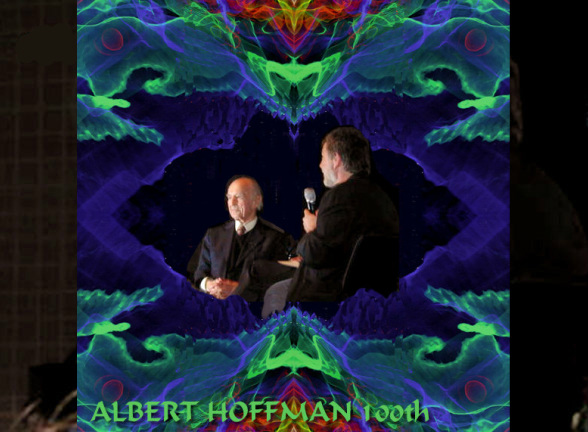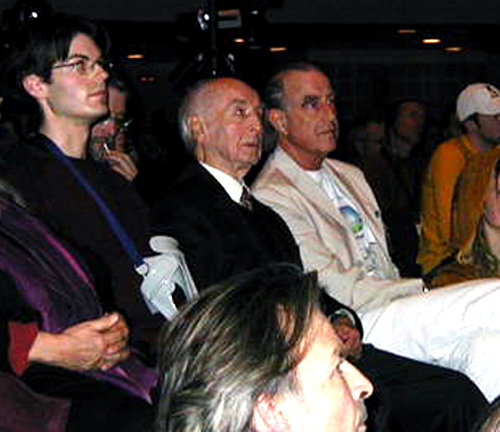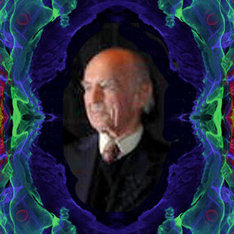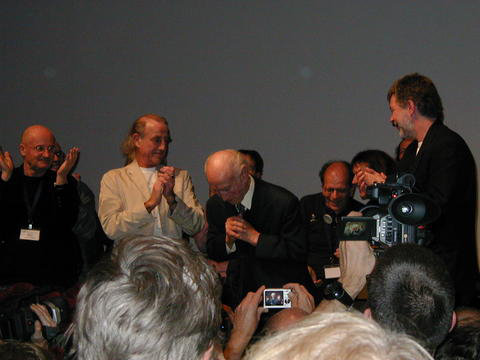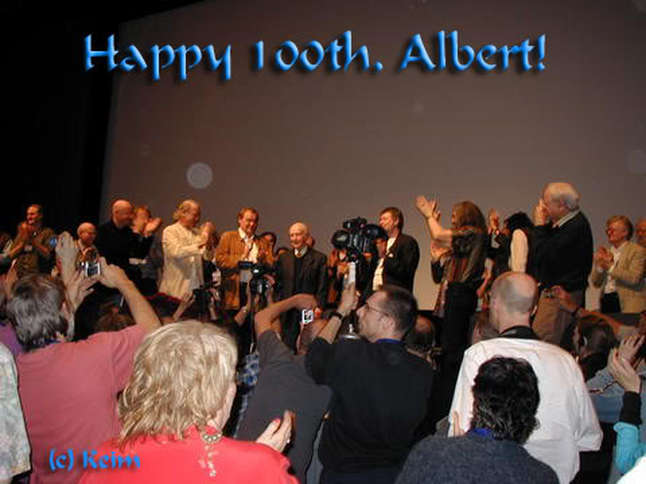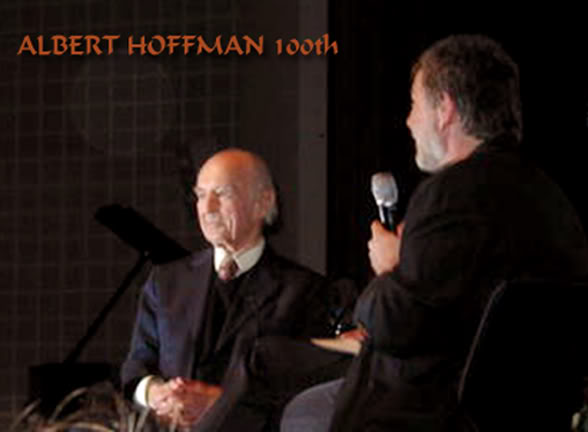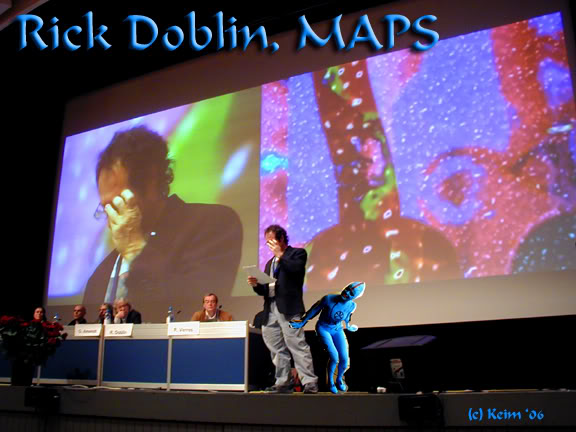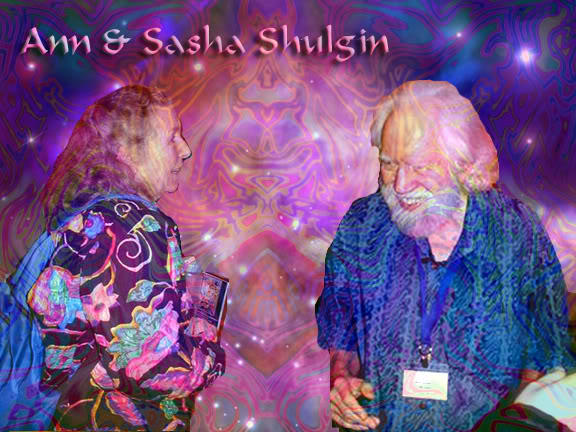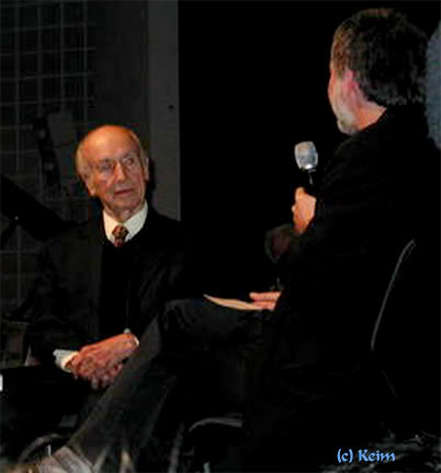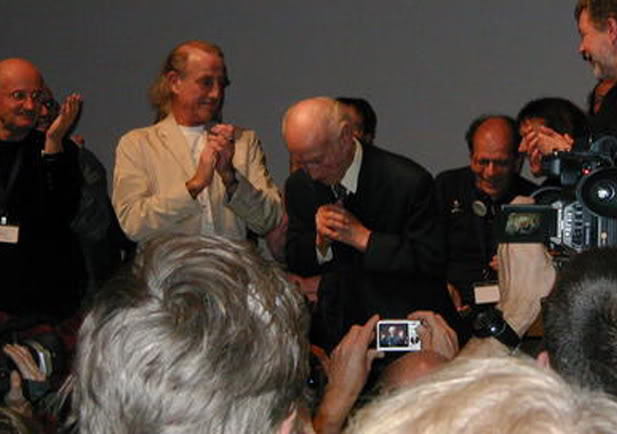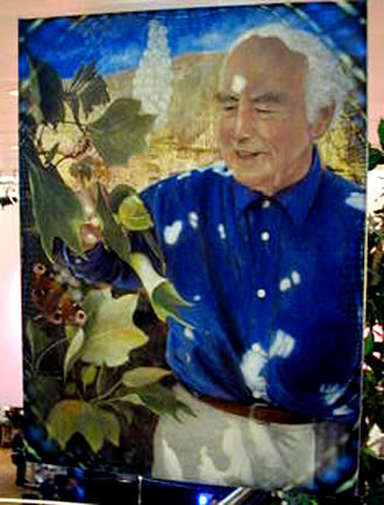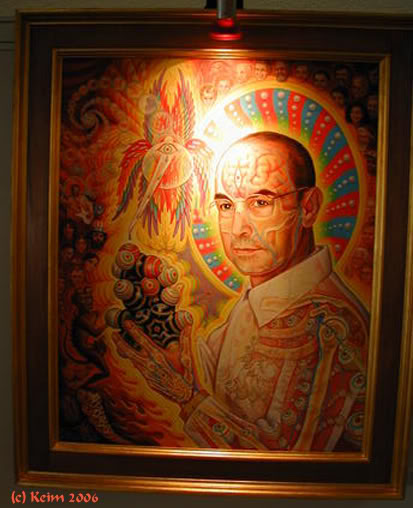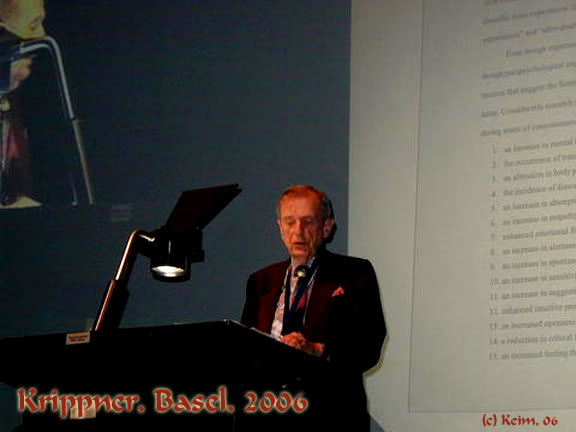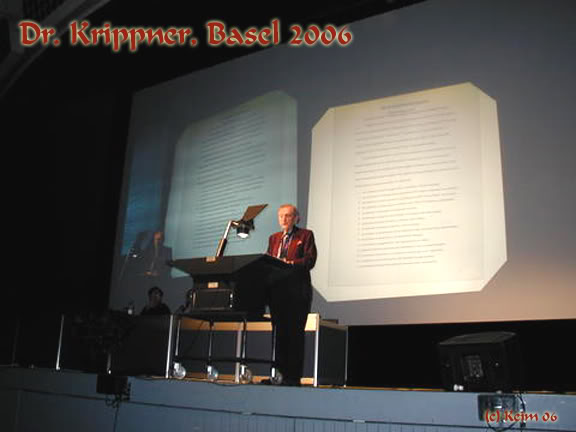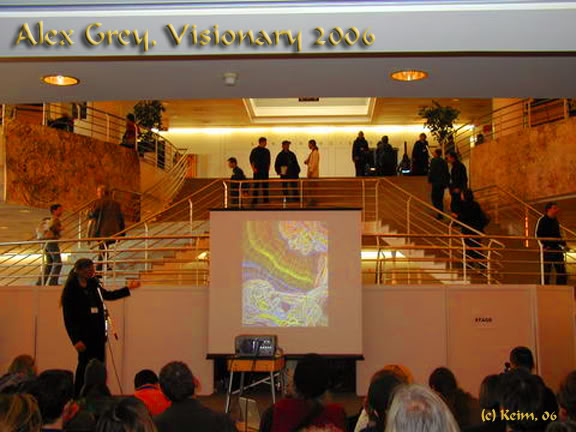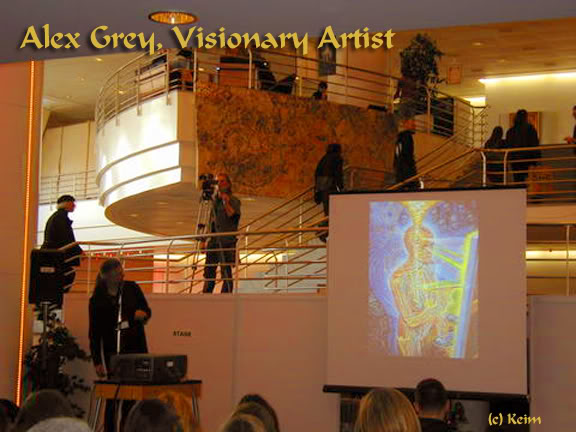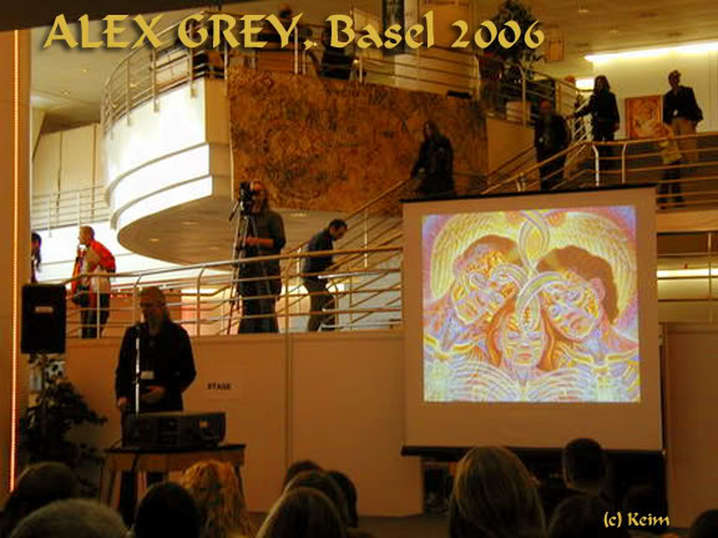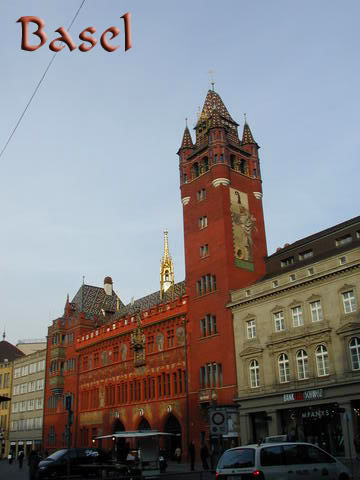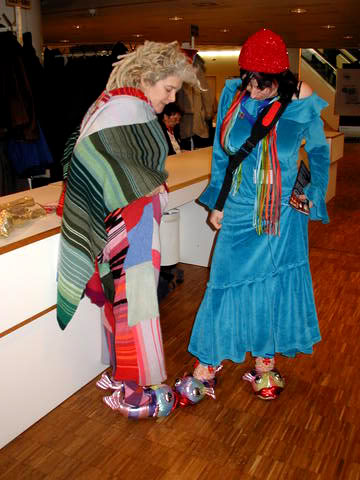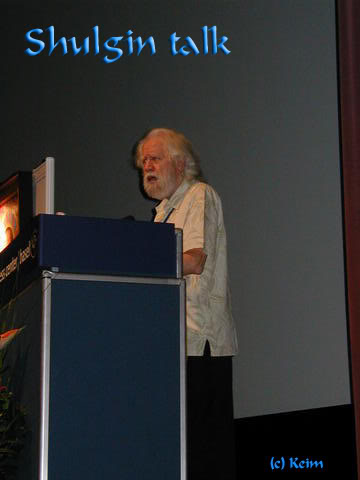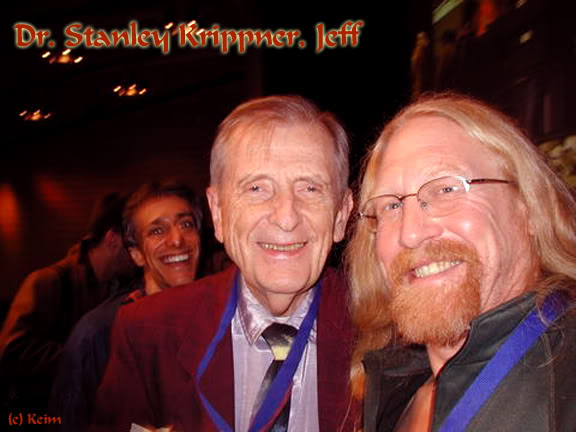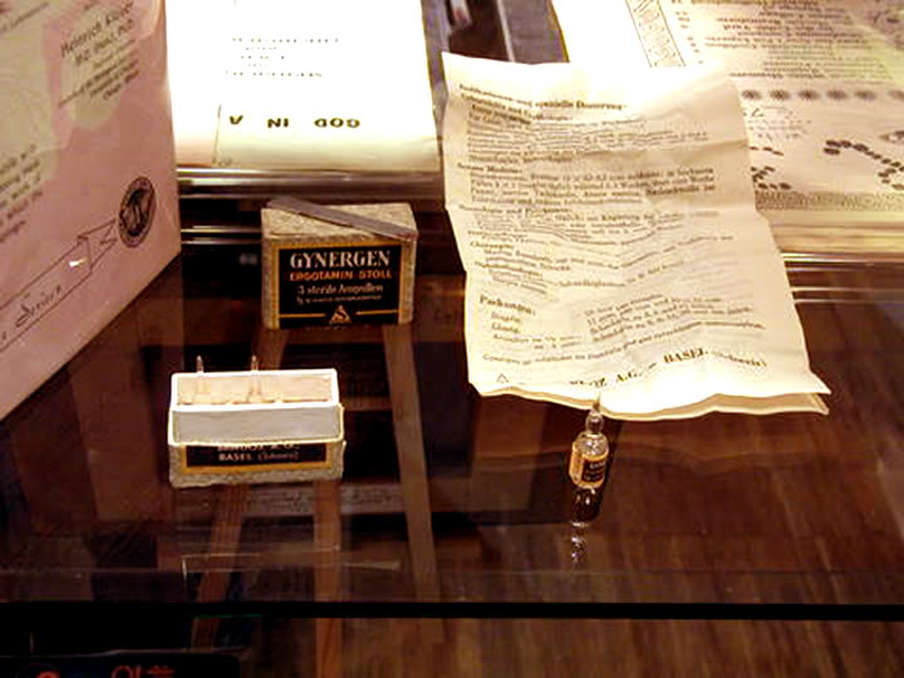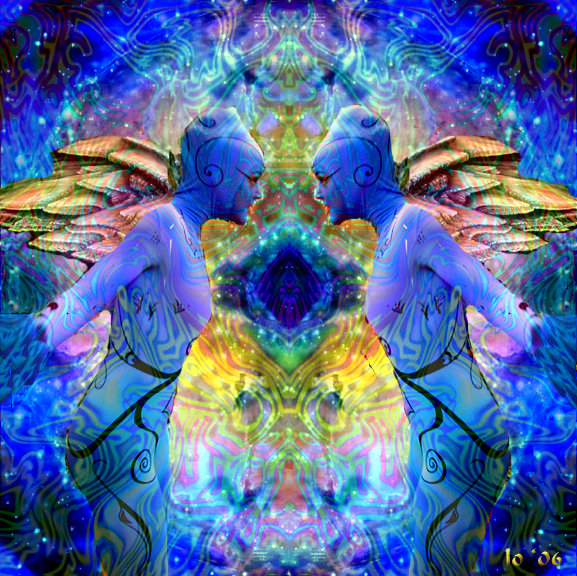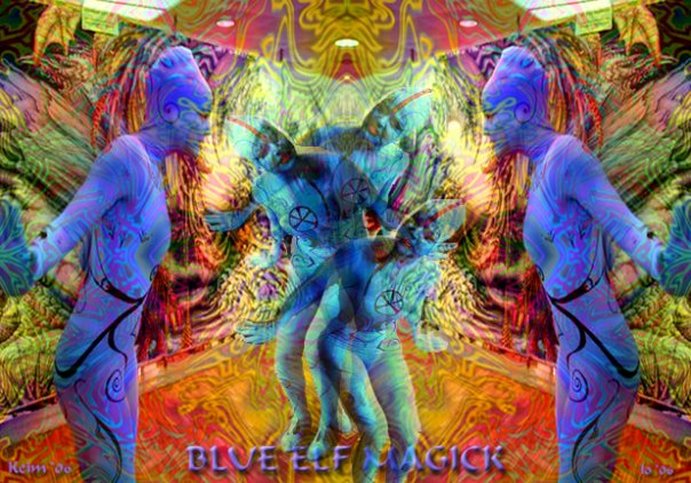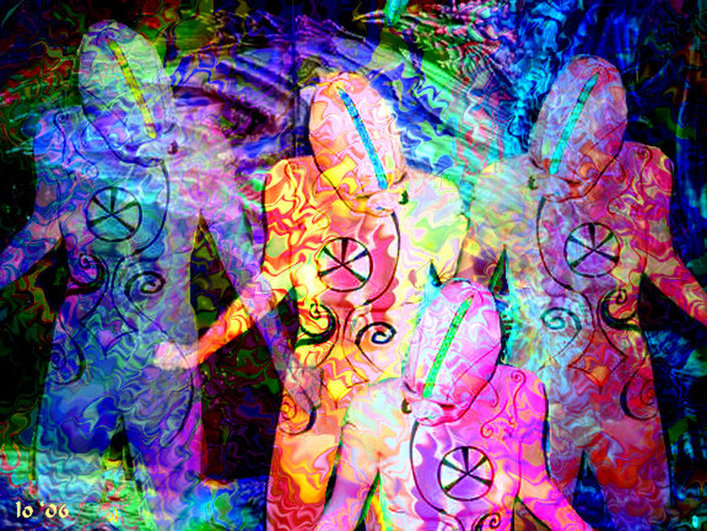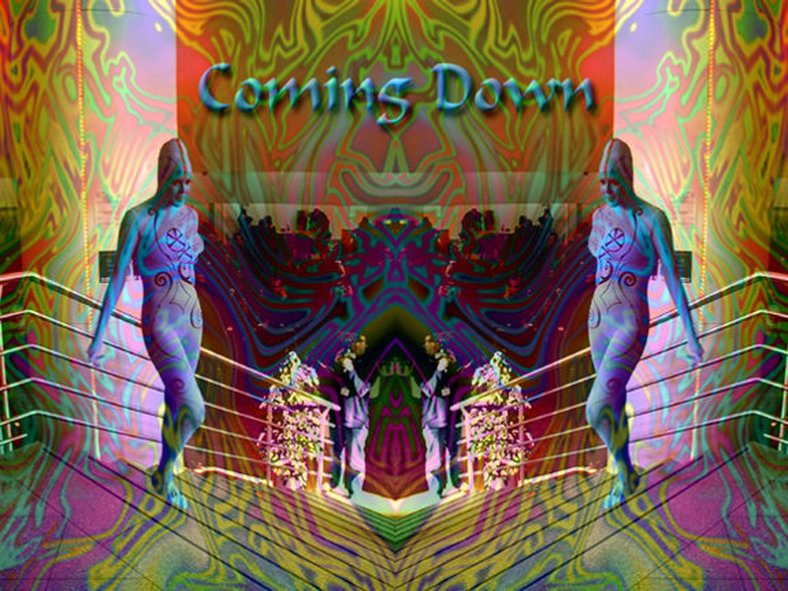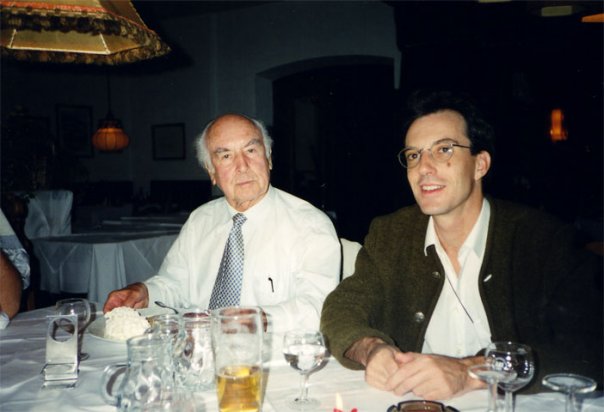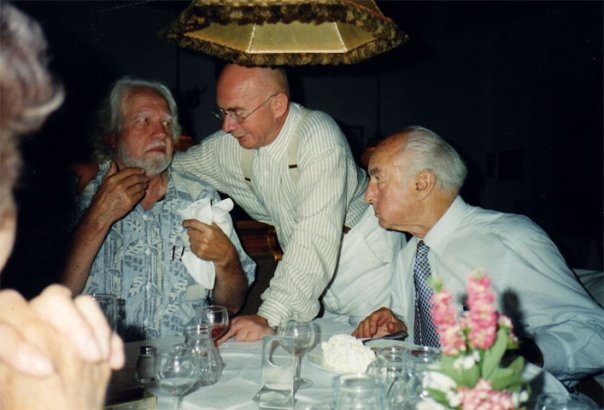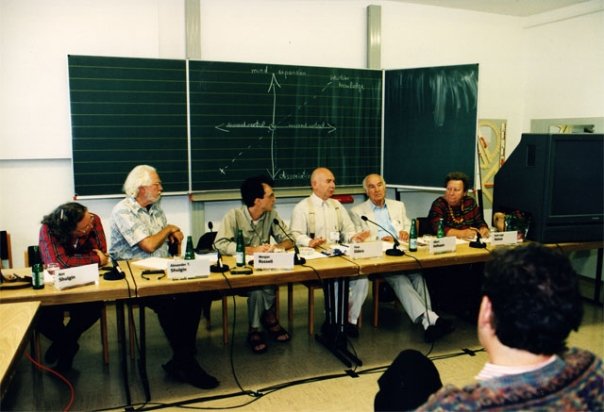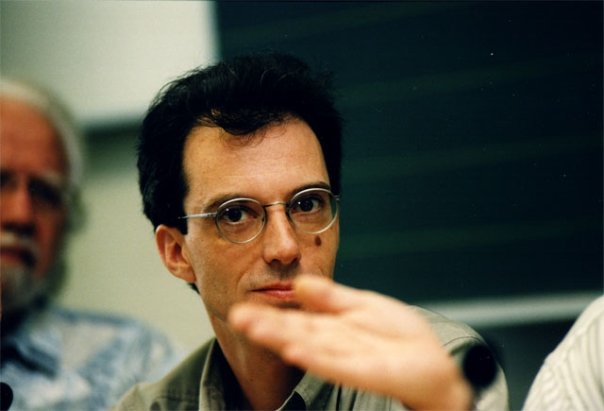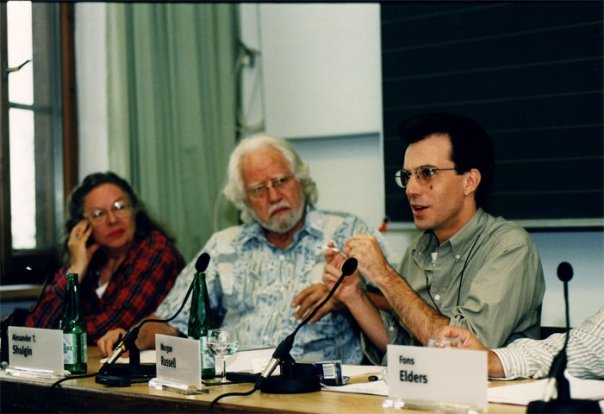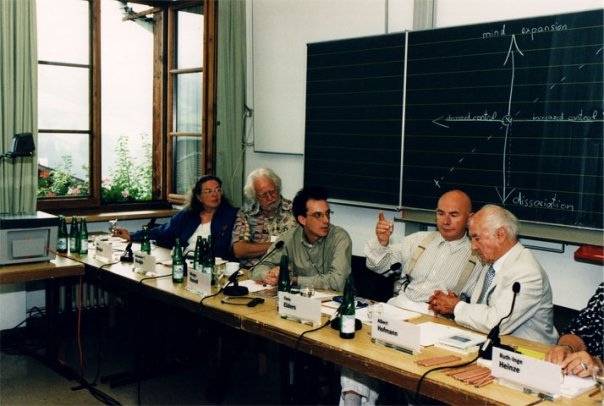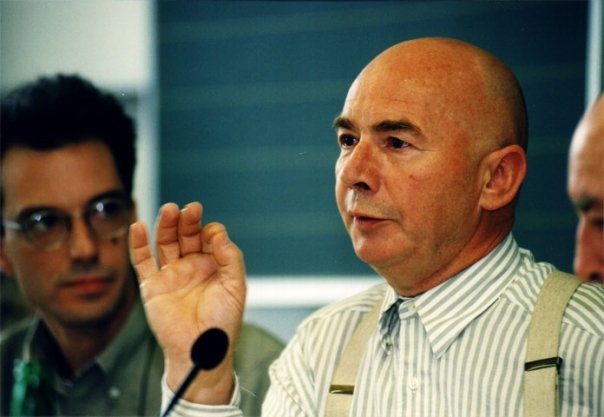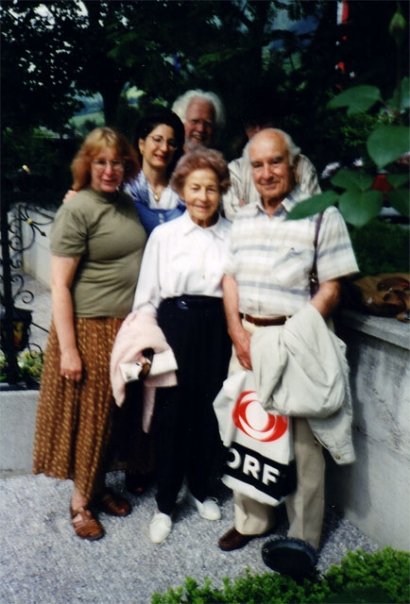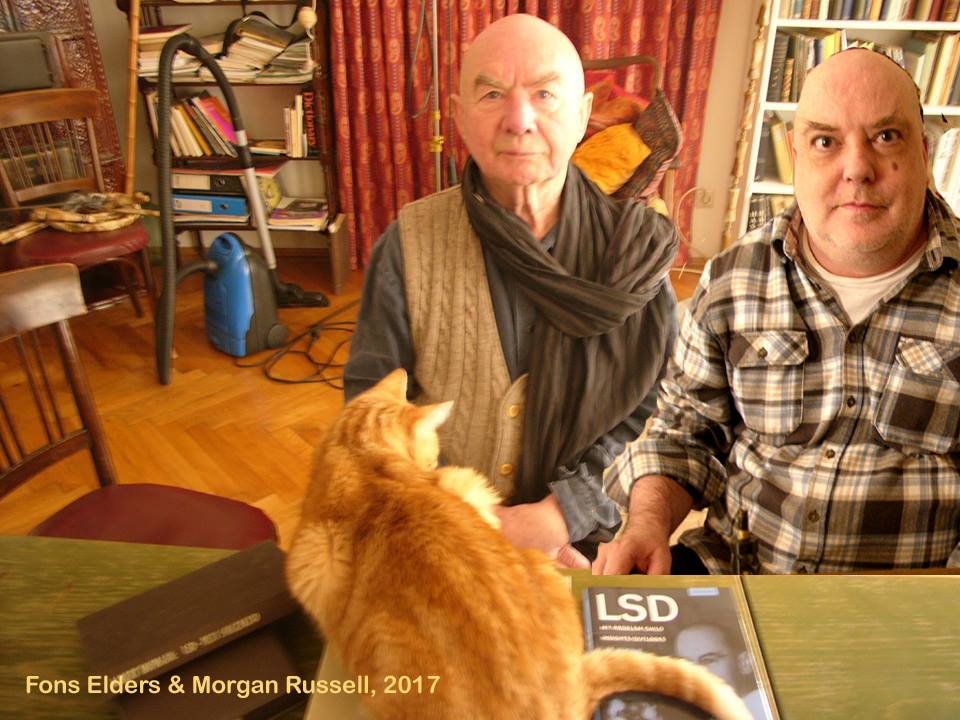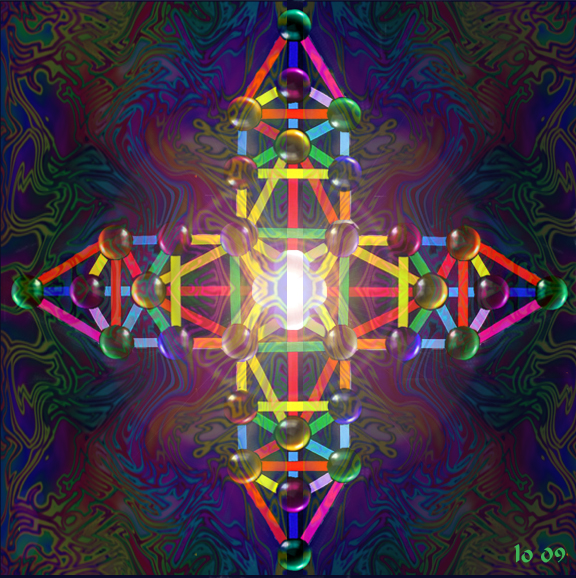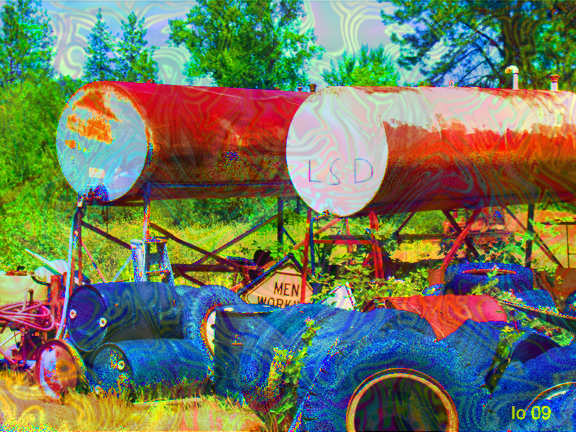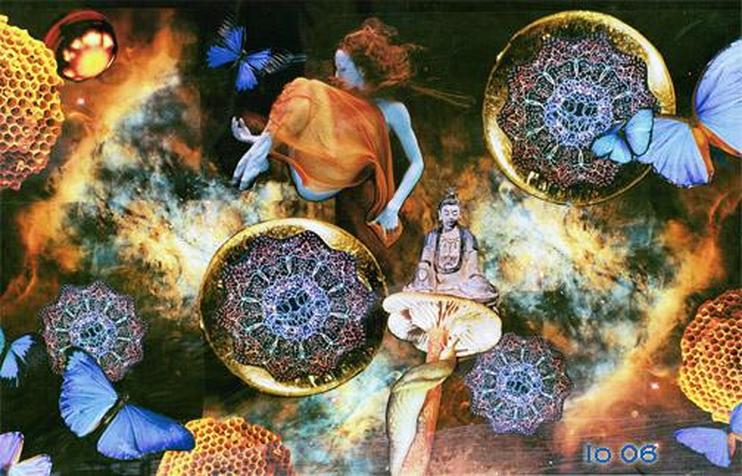THE WIZARDS OF AHS
Subculture Shenanigans
Curating the Psychedelic Cognoscenti: 1966 - 2014
Psychedelic & Neo-Psychedelic Scenes & Zines
by Iona Miller & Morgan Russell, (c)2013
With an aging boomer generation in its golden years, the curation of the history of the psychedelic revolution and ensuing scenes takes on a poignant urgency. The Underground was the matrix of numerous scenes and revivals that are still highly influential in society today, though their magic moments have come and gone. While each of the psychedelic luminaries and cyber-pioneers have their own press, an overview of some of their former and current activities highlights the arc of these rainbow warriors from many walks of life. No one has written a comprehensive overview that links the agendas of various geographically separated groups into a coherent integral overview, spanning the interactions of West Coast, East Coast, Europe, Hyperspace, and the Virtuality.
From "Dodge City" to "Quail House", from "Silicon-Alley" to Miami Beach, and Beyond
Video forthcoming
From "Dodge City" to "Quail House", from "Silicon-Alley" to Miami Beach, and Beyond
Video forthcoming
1/26/06
ANIMATION OF IO ART: DO THE OZ
click here:
http://www.sign69.com/medialounge/space721.html
“Blue Elf Magick”: Hyperdelic animation of digital fine art and pix from Albert Hoffman 100th B-day party, Basel, Switzerland. Io collabo with electronic artist Philip Wood, France.
Flash Animations, Random Generator.
Music: Plastic Ono Band, “Do the Oz”.
ANIMATION OF IO ART: DO THE OZ
click here:
http://www.sign69.com/medialounge/space721.html
“Blue Elf Magick”: Hyperdelic animation of digital fine art and pix from Albert Hoffman 100th B-day party, Basel, Switzerland. Io collabo with electronic artist Philip Wood, France.
Flash Animations, Random Generator.
Music: Plastic Ono Band, “Do the Oz”.
Hunter Thompson wrote, "History is hard to know, because of all the hired bullshit, but even without being sure of 'history' it seems entirely reasonable to think that every now and then the energy of a whole generation comes to a head in a long fine flash, for reasons that nobody really understands at the time—and which never explain, in retrospect, what actually happened."
This they tell, and whether it happened so or not I do not know;
but if you think about it, you can see that it is true. --Black Elk
This they tell, and whether it happened so or not I do not know;
but if you think about it, you can see that it is true. --Black Elk
DFA by Iona Miller
co·gno·scen·tiˌkänyōˈSHentē,ˌkägnə-/nounplural noun: cognoscenti
1. people who are considered to be especially well informed about a particular subject.
A person with superior, usually specialized knowledge or highly refined taste; a connoisseur.
"Serenely let us move to distant places
And let no sentiments of home detain us
The Cosmic Spirit seeks not to restrain us
But lifts us stage by stage to wider spaces."
--Hesse, The Glass Bead Game
1. people who are considered to be especially well informed about a particular subject.
A person with superior, usually specialized knowledge or highly refined taste; a connoisseur.
"Serenely let us move to distant places
And let no sentiments of home detain us
The Cosmic Spirit seeks not to restrain us
But lifts us stage by stage to wider spaces."
--Hesse, The Glass Bead Game
Supersonic Hyperdelic
We're All Stars Now in the Dope Show
BEL > PM&E > HF/RH/Mondo 2000 > NonLinearCircle > Forum Alpbach
The Harmonic Convergence of
Psychedelics, Culture, Science & Technology
Embodied & Disembodied Identities
The Harmonic Convergence of
Psychedelics, Culture, Science & Technology
Embodied & Disembodied Identities
Brotherhood of Eternal Love
Peace, Love & Harmony with Nature
(Dodge City, Laguna Beach, Haight Ashbury, Maui, Global Network)
http://belhistory.weebly.com/index.html
1966-1972: From its founding in 1966, the BROTHERHOOD OF ETERNAL LOVE (BEL) has been pioneering and shaping society. They fueled the zeitgeist with synchronicity and the seeds of change. Jung said that “Synchronicity reveals the meaningful connections between the subjective and objective world.”
The story of the Brotherhood is more concerned with psychic forces -- archetypal, philosophical, and cosmic -- than it is with the historical and emotional lives of the characters that weave in and out of it. They did, however, embody a Holy Moment, a slice of space-time that superseded reality. They had the Gaze of those who pierced through the illusions of ordinary life to marvel at the deep archetypal forces that shape reality.
The Brotherhood became agents of mass transformation. But, "seeing everything" either leads into enlightenment or the deeper darkness of disillusionment. At some point, the vision becomes obsession and turns cloudy. The irrational depths of the soul are undeniable. The ever-burning energy of human instinct transmutes into creative power. The feedback of 20/20 hindsight shows that in the worship of their own creation, perhaps they misunderstood the symbol for the thing. Even when we see Reality, we may be unable to help the situation. The meaning lies not in abstract spirituality but in the [re]sacralization of earthly life, not the nightmares of history.
As mercurial tricksters and shamanic sorcerers, they helped expose society's entrenched hypocrisy through a rejection of obsolete values -- the consensual trance of traditional morality. In tearing the veil from the 3rd eye of millions, they revealed the psychedelic heart of creativity that transcends language and conceptualization.
But the mystic eye and the evil eye are the same organ - bent on different ends. The power to imagine still shapes the future. That visionary power is what makes us human. The Brotherhood story is bigger than than they are -- than the narratives of each individual life. It galvanized a movement. Today's Brothers are glad to have survived their adventures, whether it was real or only a dream lived aloud. Sometimes even a whole lifetime cannot reveal the whole truth. Their secrets remained concealed because they are experiential -- initiatory.
Joseph Campbell said, "What we call monsters can be experienced as sublime. They represent powers too vast for the normal forms of life to contain them. . .Meanwhile, you’re climbing, until suddenly you break past a screen and an expanse of horizon opens out, and somehow, with this diminishment of your own ego, your consciousness expands to an experience of the sublime."
Griggs and his buddies migrated from Anaheim, California to bucolic Modjeska Canyon, where they formed a pastoral church centered around hallucinogens. With entrepreneurial spirit, they developed an illicit drug business. Needing a low-key hideout in Laguna Beach, they moved to Woodland Drive, an out-of-the-way collection of cheap-rental cottages and shacks. Later, it was called "Dodge City". Then they opened an art gallery and head shop called Mystic Arts World on South Coast Highway.
This is one epic Dope Opera, full of psychedelic surfers entangled in lots of magic seaweed. Timothy Leary was their resident Godfather for two years of intense, unstructured brainstorming, both in Laguna and at the Idyllwild ranch. BEL romanticized the American Outlaw and themselves -- as brash streetwise outsiders, righteous guerrilla dealers, and freedom fighters, but not criminals. They made those 60s albums and concerts sound even better. The counterculture burst into technicolor bloom, reflecting deep mysteries in new hues -- especially orange sunshine.
Branding Bravado
Everybody and their brother seems to think they were associated, but the original BEL crew was actually quite small with roots in Junior High and High School in Anaheim. They were never a "motorcycle gang", despite that characterization. They were destined to become a legend in their own time, by selling celestial dreams and oceanic communion. The story of the Brotherhood of Eternal Love is a paradox of the '60s Southern California counterculture and an electrified metaphor describing the rise and fall of the entire phenomenon.
The saga of the Brotherhood of Eternal Love is a bizarre mélange of evangelical, starry-eyed hippie dealers, mystic alchemists, and fast-money bankers. Federal investigators described them as a "hippie Mafia" of approximately seven hundred fifty people that allegedly grossed $200,000,000. But the Brotherhood's secret
network of smugglers lived by a code different from that associated with organized crime. They were fired with idealism, committed to changing the world by disseminating large quantities of psychedelics. At least that's how it was at the beginning …. (Acid Dreams)
There's no soft-pedaling it -- the Brothers were drug distributors and smugglers who seized the magic moment of great instability and decay and provided a dynamic and very personal rebirth experience. In an era that deeply questioned the nature of reality, their history reads like a movie treatment, complete with hair-raising scenes of international smuggling in Afghanistan, near-arrests and miraculous escapes, surfing on acid, psychic visions, UFOs, agonies, ecstasies, and, of course, Leary with his bizarre escapades. Other like-minded groups formed, but the Brotherhood had a starring role with ambitious participation, amplified by Leary's financial and alchemical connections, patronage and payoffs.
BEL became a daring group of enormously successful underground drug manufacturers and dealers in LSD, pot, and hashish in the late ’60s to early ’70s. But the fact is that the brilliant glimpse of a living cosmos did pour through for a while, and it resulted in an unprecedented vision of a different world. One could debate forever the question of how much of what the drug did for us was contingent on the peculiar conditions of that time. The opening, however, was real. History can be funny that way.
Tuned in to the mystic arts yet aggressively pragmatic, the BEL believed they could transform the world by getting enough acid out on the underground market. They had already hit the JackPot with their grassroots network. Always seeking a utopian escape, some of BEL's members fled to Maui -- their 'Rainbow Island' -- where these transplanted pot smugglers turned to big-wave surfing, created Maui Waui, and appeared in their film Rainbow Bridge with Jimi Hendrix. A few returned to Santa Cruz and widely-dispersed Brotherhood properties within a short time.
Best Friends & Worst Enemies
The tightly-knit community went from zeros to heroes to the FBI's Most Wanted. The Brotherhood alchemists turned ergot mold into the gold of Orange Sunshine. Those who weren't caught individually or in the Operation BEL sweep went into hiding underground or abroad. The Brothers who had been best friends could also be worst enemies. Some brothers maintained the code of silence when faced with incarceration and even betrayal.
Tim Scully first met William "Billy" Mellon Hitchcock, grandson of William Larimer Mellon and great-great-grandson of Thomas Mellon, through Owsley in April 1967. They became friends and Billy loaned Scully $12,000 for the second Denver lab in 1968. The product from the lab was distributed by the Brotherhood of Eternal Love. Like Nick Sand, Scully was connected with the Brotherhood via Billy Hitchcock and Tim Leary.
In December 1968 Nick Sand (through an intermediary) purchased a farmhouse in Windsor, California where he and Tim Scully set up a large LSD lab. Tim Scully and Nick Sand (another psychedelic chemist) produced over 3.6 million tablets (300 micrograms each) of LSD they dubbed "Orange Sunshine" by the summer of 1969. In May 1969 Tim Scully was arrested in California for the 1968 Denver lab. The search was eventually ruled illegal, but Scully decided to retire from clandestine chemistry and pursue electronic design instead.
In 1972 the BEL alchemist, Nick Sand was prosecuted along with several members of the Brotherhood for the manufacturing of LSD. They had been the focus of a lengthy investigation by federal narcotics agents in the early 1970s. In early 1973 Billy Hitchcock was threatened with 24 years in prison for tax evasion if he didn't help the government convict the prime movers of the LSD cartel.
Billy provided evidence and testified against Tim Scully and Nick Sand and they were both indicted in April 1973. In 1976 Sand was found guilty partially due to the testimony of Billy Hitchcock and other "snitches" and was sentenced to 15 years in a federal penitentiary. Released on bail, he went underground in 1976 and remained a fugitive from federal agents for two decades.
One Drug Ring to Bind Them All
Core BEL brother, Glen Lynd turned state's evidence, revealing the entire BEL enterprise to the Feds for immunity from prosecution after Operation BEL. Patron Billy Hitchcock and even Leary turned snitch for a softer landing. In a stark reality check, middle-man Ronald Stark snitched for immunity on tax evasion and money laundering linked to Operation Julie in Britain. Some bad deals went down among the brothers themselves. The center could not hold.
One one level this is a true crime story: the evolution of a hippie drug smuggling operation and the cops who eventually took it down. But it's also a larger than life story about people who used highly illegal and unconventional ways to, in their point of view, bring peace on earth. Though many have tried, you cannot demystify the story of the Brotherhood, whose saga continues as a Peace Organization.
Silent Swagger
Some brothers don't wish to speak about any of it; others do. Some things are better left unsaid and "that was then and this is now". Some brothers still carry serious resentments and old gripes. In this dog eat dogma group, every dog has its day, every Brother has his say. Like blind men examining an elephant, many books, articles and videos describe different aspects of the Brotherhood, each with its own emphasis and spin. But all get mixed reviews for accuracy, even though they tried to interview other players who remain anonymous or silent.
We all tend to distill our experiences down into narratives we repeat almost verbatim. The best accounts are those by the brothers themselves, as reporters tell facts but fail to capture much of the flavor and fervor of the times. Despite its drug history, BEL remains what it essentially always was -- an activist spiritual organization, not just a pipedream, nebulous organization, or notorious legend. Eventually the Cold War nexus of institutions and ideas collapsed under their own weight. The process continues.
BEL survivors include Veterans, Ministers, Addiction Counselors, Healers, Artists, and Lamas. The core is still more interested in spirituality and helping fellow travelers on their life journey than in chasing the dollar, the Life-Spirit-Drug. If ministry is about touching peoples' lives, the BEL reached inside and rototilled their brains.
This is their story, and it is still unfolding, so check back as our archive grows. This connection has not been fully explored yet. Today's BEL is a social activist peace organization supporting veterans, health, and organic food choices for children, musical and community events. It's a conspirituality. The Brotherhood is still pushing Peace & Love and riding that cultural wave. Join the Revival. Show Us Your Peace Sign.
Peace, Love & Harmony with Nature
(Dodge City, Laguna Beach, Haight Ashbury, Maui, Global Network)
http://belhistory.weebly.com/index.html
1966-1972: From its founding in 1966, the BROTHERHOOD OF ETERNAL LOVE (BEL) has been pioneering and shaping society. They fueled the zeitgeist with synchronicity and the seeds of change. Jung said that “Synchronicity reveals the meaningful connections between the subjective and objective world.”
The story of the Brotherhood is more concerned with psychic forces -- archetypal, philosophical, and cosmic -- than it is with the historical and emotional lives of the characters that weave in and out of it. They did, however, embody a Holy Moment, a slice of space-time that superseded reality. They had the Gaze of those who pierced through the illusions of ordinary life to marvel at the deep archetypal forces that shape reality.
The Brotherhood became agents of mass transformation. But, "seeing everything" either leads into enlightenment or the deeper darkness of disillusionment. At some point, the vision becomes obsession and turns cloudy. The irrational depths of the soul are undeniable. The ever-burning energy of human instinct transmutes into creative power. The feedback of 20/20 hindsight shows that in the worship of their own creation, perhaps they misunderstood the symbol for the thing. Even when we see Reality, we may be unable to help the situation. The meaning lies not in abstract spirituality but in the [re]sacralization of earthly life, not the nightmares of history.
As mercurial tricksters and shamanic sorcerers, they helped expose society's entrenched hypocrisy through a rejection of obsolete values -- the consensual trance of traditional morality. In tearing the veil from the 3rd eye of millions, they revealed the psychedelic heart of creativity that transcends language and conceptualization.
But the mystic eye and the evil eye are the same organ - bent on different ends. The power to imagine still shapes the future. That visionary power is what makes us human. The Brotherhood story is bigger than than they are -- than the narratives of each individual life. It galvanized a movement. Today's Brothers are glad to have survived their adventures, whether it was real or only a dream lived aloud. Sometimes even a whole lifetime cannot reveal the whole truth. Their secrets remained concealed because they are experiential -- initiatory.
Joseph Campbell said, "What we call monsters can be experienced as sublime. They represent powers too vast for the normal forms of life to contain them. . .Meanwhile, you’re climbing, until suddenly you break past a screen and an expanse of horizon opens out, and somehow, with this diminishment of your own ego, your consciousness expands to an experience of the sublime."
Griggs and his buddies migrated from Anaheim, California to bucolic Modjeska Canyon, where they formed a pastoral church centered around hallucinogens. With entrepreneurial spirit, they developed an illicit drug business. Needing a low-key hideout in Laguna Beach, they moved to Woodland Drive, an out-of-the-way collection of cheap-rental cottages and shacks. Later, it was called "Dodge City". Then they opened an art gallery and head shop called Mystic Arts World on South Coast Highway.
This is one epic Dope Opera, full of psychedelic surfers entangled in lots of magic seaweed. Timothy Leary was their resident Godfather for two years of intense, unstructured brainstorming, both in Laguna and at the Idyllwild ranch. BEL romanticized the American Outlaw and themselves -- as brash streetwise outsiders, righteous guerrilla dealers, and freedom fighters, but not criminals. They made those 60s albums and concerts sound even better. The counterculture burst into technicolor bloom, reflecting deep mysteries in new hues -- especially orange sunshine.
Branding Bravado
Everybody and their brother seems to think they were associated, but the original BEL crew was actually quite small with roots in Junior High and High School in Anaheim. They were never a "motorcycle gang", despite that characterization. They were destined to become a legend in their own time, by selling celestial dreams and oceanic communion. The story of the Brotherhood of Eternal Love is a paradox of the '60s Southern California counterculture and an electrified metaphor describing the rise and fall of the entire phenomenon.
The saga of the Brotherhood of Eternal Love is a bizarre mélange of evangelical, starry-eyed hippie dealers, mystic alchemists, and fast-money bankers. Federal investigators described them as a "hippie Mafia" of approximately seven hundred fifty people that allegedly grossed $200,000,000. But the Brotherhood's secret
network of smugglers lived by a code different from that associated with organized crime. They were fired with idealism, committed to changing the world by disseminating large quantities of psychedelics. At least that's how it was at the beginning …. (Acid Dreams)
There's no soft-pedaling it -- the Brothers were drug distributors and smugglers who seized the magic moment of great instability and decay and provided a dynamic and very personal rebirth experience. In an era that deeply questioned the nature of reality, their history reads like a movie treatment, complete with hair-raising scenes of international smuggling in Afghanistan, near-arrests and miraculous escapes, surfing on acid, psychic visions, UFOs, agonies, ecstasies, and, of course, Leary with his bizarre escapades. Other like-minded groups formed, but the Brotherhood had a starring role with ambitious participation, amplified by Leary's financial and alchemical connections, patronage and payoffs.
BEL became a daring group of enormously successful underground drug manufacturers and dealers in LSD, pot, and hashish in the late ’60s to early ’70s. But the fact is that the brilliant glimpse of a living cosmos did pour through for a while, and it resulted in an unprecedented vision of a different world. One could debate forever the question of how much of what the drug did for us was contingent on the peculiar conditions of that time. The opening, however, was real. History can be funny that way.
Tuned in to the mystic arts yet aggressively pragmatic, the BEL believed they could transform the world by getting enough acid out on the underground market. They had already hit the JackPot with their grassroots network. Always seeking a utopian escape, some of BEL's members fled to Maui -- their 'Rainbow Island' -- where these transplanted pot smugglers turned to big-wave surfing, created Maui Waui, and appeared in their film Rainbow Bridge with Jimi Hendrix. A few returned to Santa Cruz and widely-dispersed Brotherhood properties within a short time.
Best Friends & Worst Enemies
The tightly-knit community went from zeros to heroes to the FBI's Most Wanted. The Brotherhood alchemists turned ergot mold into the gold of Orange Sunshine. Those who weren't caught individually or in the Operation BEL sweep went into hiding underground or abroad. The Brothers who had been best friends could also be worst enemies. Some brothers maintained the code of silence when faced with incarceration and even betrayal.
Tim Scully first met William "Billy" Mellon Hitchcock, grandson of William Larimer Mellon and great-great-grandson of Thomas Mellon, through Owsley in April 1967. They became friends and Billy loaned Scully $12,000 for the second Denver lab in 1968. The product from the lab was distributed by the Brotherhood of Eternal Love. Like Nick Sand, Scully was connected with the Brotherhood via Billy Hitchcock and Tim Leary.
In December 1968 Nick Sand (through an intermediary) purchased a farmhouse in Windsor, California where he and Tim Scully set up a large LSD lab. Tim Scully and Nick Sand (another psychedelic chemist) produced over 3.6 million tablets (300 micrograms each) of LSD they dubbed "Orange Sunshine" by the summer of 1969. In May 1969 Tim Scully was arrested in California for the 1968 Denver lab. The search was eventually ruled illegal, but Scully decided to retire from clandestine chemistry and pursue electronic design instead.
In 1972 the BEL alchemist, Nick Sand was prosecuted along with several members of the Brotherhood for the manufacturing of LSD. They had been the focus of a lengthy investigation by federal narcotics agents in the early 1970s. In early 1973 Billy Hitchcock was threatened with 24 years in prison for tax evasion if he didn't help the government convict the prime movers of the LSD cartel.
Billy provided evidence and testified against Tim Scully and Nick Sand and they were both indicted in April 1973. In 1976 Sand was found guilty partially due to the testimony of Billy Hitchcock and other "snitches" and was sentenced to 15 years in a federal penitentiary. Released on bail, he went underground in 1976 and remained a fugitive from federal agents for two decades.
One Drug Ring to Bind Them All
Core BEL brother, Glen Lynd turned state's evidence, revealing the entire BEL enterprise to the Feds for immunity from prosecution after Operation BEL. Patron Billy Hitchcock and even Leary turned snitch for a softer landing. In a stark reality check, middle-man Ronald Stark snitched for immunity on tax evasion and money laundering linked to Operation Julie in Britain. Some bad deals went down among the brothers themselves. The center could not hold.
One one level this is a true crime story: the evolution of a hippie drug smuggling operation and the cops who eventually took it down. But it's also a larger than life story about people who used highly illegal and unconventional ways to, in their point of view, bring peace on earth. Though many have tried, you cannot demystify the story of the Brotherhood, whose saga continues as a Peace Organization.
Silent Swagger
Some brothers don't wish to speak about any of it; others do. Some things are better left unsaid and "that was then and this is now". Some brothers still carry serious resentments and old gripes. In this dog eat dogma group, every dog has its day, every Brother has his say. Like blind men examining an elephant, many books, articles and videos describe different aspects of the Brotherhood, each with its own emphasis and spin. But all get mixed reviews for accuracy, even though they tried to interview other players who remain anonymous or silent.
We all tend to distill our experiences down into narratives we repeat almost verbatim. The best accounts are those by the brothers themselves, as reporters tell facts but fail to capture much of the flavor and fervor of the times. Despite its drug history, BEL remains what it essentially always was -- an activist spiritual organization, not just a pipedream, nebulous organization, or notorious legend. Eventually the Cold War nexus of institutions and ideas collapsed under their own weight. The process continues.
BEL survivors include Veterans, Ministers, Addiction Counselors, Healers, Artists, and Lamas. The core is still more interested in spirituality and helping fellow travelers on their life journey than in chasing the dollar, the Life-Spirit-Drug. If ministry is about touching peoples' lives, the BEL reached inside and rototilled their brains.
This is their story, and it is still unfolding, so check back as our archive grows. This connection has not been fully explored yet. Today's BEL is a social activist peace organization supporting veterans, health, and organic food choices for children, musical and community events. It's a conspirituality. The Brotherhood is still pushing Peace & Love and riding that cultural wave. Join the Revival. Show Us Your Peace Sign.
The dope dealer is selling you the celestial dream. He is very different from any other merchant because the commodity he is peddling is freedom and joy. In the years to come the television dramas and movies will make a big thing of the dope dealer of the sixties. He is going to be the Robin Hood, spiritual guerrilla, mysterious agent - who will take the place of the cowboy hero or the cops and robbers hero.' (Timothy Leary, 'Dope Dealers - New Robin Hood', 1967)
ORANGE CRUSH
They Lived in the Sun & Dealt in the Shade
Tim Leary was just selling ideas, not drugs. But his Brothers sure were.
Grassroots Network
Mostly, the hippies of the 1960s are remembered for their peaceful ways, for preaching 'Peace and Love'. In those days, parts of Orange County still looked like a vintage wooden fruitbox label. But, some of those visionaries foresaw the future and banded into what High Times and Rolling Stone dubbed a 'hippie mafia'. They were more pro-active than mere protesters. They launched a grassroots crusade against the mental inquisition of consumerism and conformity. Youth culture made a bigger quake than the San Andreas faultline before ultimately becoming commercialized itself into an over-the-counterculture.
The hippies were a social phenomenon which spurned materialism for their new tribal religion. But the brothers who grew up in the shadow of Disneyland still made untold millions, whether in a willing or inadvertent league with CIA and other black marketeers. Most likely they didn't realize it at the time. They were convinced this would change the world for the better.
Though BEL virtually cornered the acid market, they were never motivated by monopoly or "power". But the situation had them oscillating rapidly between everyday ego inflations and synthetic ego-death. Jung called ego-inflation a potential pitfall—amplifying the shadow of anyone practicing a “spiritual path.” They say without the prerequisite humor, honesty and humility, the danger only increases as one’s practice advances.
The identification with the collective psyche is acceptance of inflation, but now exalted into a system of great truths. Temporary ego death is an experience that is said to reveal the illusory aspect of the ego, but it can also feed an essentially bipolar cycle. Clearly, it is not the ego or self which is annihilated in ego death. Neither the ego of depth psychology nor the actual self, specifically the self-identity dissolves - only the belief boundaries we construct of past experiences and identification. From the perspective of unity, there is no such thing as dying, nor of being reborn. There is no such thing as ego death, and no such thing as enlightenment either, since you are already the unity. Transcendent experience goes beyond identifications structured by a particular self-representation.
Over the Rainbow
We now know you can't solve such problems with a pill. Spirituality is linked to the "oceanic" feeling of limitlessness. The sensation of an indissoluble bond is a deeply meaningful connection with the external world in its integral form. This feeling is an entirely subjective fact, not an article of faith. The oceanic experience is usually brief and completely unexpected. It is being at one with the entire universe, and of feeling a deep meaning and purpose to every part of existence.
This numinous experience is often accompanied by feelings of compassion and love for all beings. -- sacred participatory consciousness. But it may just be a momentary glimpse, a felt sense of what an integrated state would feel like. The universe looks very different seen from the inside out as pure consciousness apprehending itself. The holistic shift reveals that matter, energy, biology and consciousness are all inter-connected in a coherent sympathetic resonance.
If such behavior seems outrageous, remember we all grew up thinking we were under the constant threat of nuclear annihilation, or personal annihilation in the Wars -- overseas, or the drug war at home. The true war is a celebration of markets. Organic markets, carefully styled "black" by the professionals, spring up everywhere. The truer currencies emerge among people. The real dope may be the perpetuation of 'movements' -- the "you done it" genre. Everyone knew that in any scenario California was a hard target so there seemed little to lose.
Technology of the Sacred
LSD was the drug in "Sex, Drugs & Rock n Roll", the 'atom bomb of consciousness'. It was a catalyst for the personal and collective unconscious, amplifying whatever was there, positive or negative, and opening alien dimensions. Neither psychiatry nor religion has come to terms with the nature of mystic experiences. Acid had a profound creative influence despite the tie-dyed tipi-dwelling idealism.
When perception changes, what we construe to be reality changes. LSD reveals the psychoactive root of phenomenology, archetypes, symbols, and myth. It was a Eureka-experience for many. Acid became the Universal Solvent, the true Philosopher's Stone. This gift of the Mothercorn, ergot, sparked an archaic revival unequalled since the Eleusinian Mysteries. Hesiod wrote of Elysion: the island of the happy dead. We might say, 'the Grateful Dead'.
Researchers began devising maps of consciousness for the Far Off Lands. Stan Grof and Charles Tart cataloged a range of evolutionary stages recapitulated in mystical, mythological and psychobiological experiences and identifications from the species, to cellular, to quantum levels. Acid also was an antidote to watching the body count from the Vietnam war on TV with dinner every night. The brothers sprinkled their Brain Seasoning like fairy dust. It changed the consciousness and social history of America in many ways. It put the collective culture through a revolutionary type of ego death and renewal. As Jung said, modern man was in search of soul, and many found it on the heroic journey within, coupled with various technologies of visionary culture.
No Stone Unturned
BEL alchemists, (Nick Sand, Tim Scully, and Ronald Stark with Kemp) came in tow with Timothy Leary via Billy Hitchcock. They gave new meaning to the "Joy of Cooking" -- synthesizing heaven. They approached it with a certain reverence and intentionality. Acid is overwhelming. It all depends on whether that is positive or negative. When it comes to making acid, "cleanliness is next to Godliness." The purer it is, the clearer the experience. The chemists and distributors strongly believed in their mission to raise human consciousness by providing a rainbow bridge to the inner world.
The brothers had a vertically integrated system from production to delivery. It was a "new" way of thinking with deep roots in the ancient Mystery religions of psychedelic spirituality. The Revolution in consciousness meant the extraordinary became ordinary. The collective mind glimpsed its psychedelic ancient/future. The transcendental self came out to play.
Acid was more than a party drug; it changed people in profound and meaningful ways. More than recreational, it was re-creational, embodying the mystery of spiritual rebirth. Even Leary suggested that many had already ingested enough acid to learn its lessons and should move on. Many people, shown this transformation, thought to themselves, "Now, how can I do this without drugs?" The typical claim was to have 'seen God'. Jung describes the transformative effects of even the drug-free mystical experience of the instant present Presence as follows:
The God-image is the symbolic expression of a particular psychic state, or Function, which is characterized by its absolute ascendancy over the will of the subject, this inspiration that transcends conscious understanding, has its source in an accumulation of energy in the unconscious. The accumulated libido activates images lying dormant in the collective unconscious, among them the God-image, that [archetypal] . . . imprint which from the beginning of time has been the collective expression of the most overwhelmingly powerful influences exerted on the conscious mind by unconscious concentrations of libido. --Carl Jung; Psychological Types; 243-44.
God, becomes‟ by an act of conscious differentiation from the unconscious dynamis, a separation of the ego as subject from God . . . as object. . . . But when the “breakthrough” abolishes this separation by cutting the ego off from the world, and the ego becomes identical with the unconscious dynamis, God disappears as an object and dwindles into a subject which is no longer distinguishable from the ego. In other words, the ego, as a late product of differentiation, is reunited with the dynamic All-oneness. --Carl Jung; Psychological Types; 255.
Underground Swell
The brothers will say they went from Zeroes to Heroes to Zeroes with the busts, and perhaps in the end back to countercultural Heroes as their legend assumes its historical aspect. America loves a good redemption story, and some brothers remain to testify to that, rather than against one another. They thought of themselves as spiritual warriors, the 'untouchable' star-crossed Robin Hoods of acid, more of an outlaw band than criminal ring. They awoke one day in Laguna in the middle of history. But there was a riptide toward the shadowy depths that inexorably pulled them under. This is the tale of surf rebels who morphed into multi-million dollar international drug smugglers who pushed peace and love as hard as their mind-manifesting products.
Storming heaven, "High Priest" Timothy Leary declared a de facto war on ordinary consciousness. LSD opened a door to the scientific study of mystical experience. Those with the experience consider it a deeply meaningful event. Orange Sunshine became a "double agent", a shot across the bow of the establishment that provoked the longest War in American history -- on drugs. Image-wise, this War was headquartered at Nixon's nearby retreat in San Clemente. Meanwhile in Laguna Beach, heads were exploding out of conformist patterns into uncharted realms. Operation BEL and Operation Julie were launched to squash the government-manufactured counterculture, once and for all.
Yet that alternative society, or what is left of it, claimed they were idealists whose true history was guarded as carefully as any state secret. The Brotherhood supplied LSD and marijuana as a sacred mission, believing in the righteousness of their profession. They had lived outside the law from their high school days. No one can grasp what they did without understanding the rise of LSD, the growth of the psychedelic movement and the heady, optimistic, revolutionary, energized days of the 1960s. But this is not so much a story of drugs as it is of life and death, and the highs and lows of the human spirit.
The Brotherhood existed, achieving many of the legendary things claimed on its behalf. It certainly generated millions of dollars, as a loosely networked drug ring. First, they hit the "jack-Pot". It was also fired with idealism, novelty-seeking, and adventurism. The French might call it bel esprit, a clever person who uses the mind creatively.
Utopiates
The Brotherhood of Eternal Love was one part of a much greater movement fascinated by the potential of LSD to improve the quality of mankind's life. The promising psychiatric tool became a potent new weapon in the hands of generals and spymasters -- the manipulators of populations. The research, both civilian and military, was widespread. Besides the smuggling drug ring, as in Tolkein's trilogy there was "one ring to bind them all" -- the indole ring, a shared related structure in LSD, psilocybin, and neurotransmitters. Compounds that contain an indole ring are called indoles. The amino acid tryptophan is an indole derivative and the precursor of the neurotransmitter serotonin.
Many believed that through the heightened perceptions and insights it produced, LSD could radically alter the direction of the human race by creating a golden pathway to the future. Utopianism is a 'hope-iate'. The dream united diverse individuals who fueled the creation of the psychedelic movement. Drugs in the 1960s no longer meant the drugging down of society. They were seen as a means to 'enlightenment', or at least being the sorcerer's apprentice for a brief time. Distribution became a cosmic conspiracy -- conspirituality. But it caused tremendous backlash. That mystic arts spirit has triumphed and survives today in compassionate treatment and medical marijuana which has eased the suffering of millions and the newly-rekindled "psychedelic science".
They Lived in the Sun & Dealt in the Shade
Tim Leary was just selling ideas, not drugs. But his Brothers sure were.
Grassroots Network
Mostly, the hippies of the 1960s are remembered for their peaceful ways, for preaching 'Peace and Love'. In those days, parts of Orange County still looked like a vintage wooden fruitbox label. But, some of those visionaries foresaw the future and banded into what High Times and Rolling Stone dubbed a 'hippie mafia'. They were more pro-active than mere protesters. They launched a grassroots crusade against the mental inquisition of consumerism and conformity. Youth culture made a bigger quake than the San Andreas faultline before ultimately becoming commercialized itself into an over-the-counterculture.
The hippies were a social phenomenon which spurned materialism for their new tribal religion. But the brothers who grew up in the shadow of Disneyland still made untold millions, whether in a willing or inadvertent league with CIA and other black marketeers. Most likely they didn't realize it at the time. They were convinced this would change the world for the better.
Though BEL virtually cornered the acid market, they were never motivated by monopoly or "power". But the situation had them oscillating rapidly between everyday ego inflations and synthetic ego-death. Jung called ego-inflation a potential pitfall—amplifying the shadow of anyone practicing a “spiritual path.” They say without the prerequisite humor, honesty and humility, the danger only increases as one’s practice advances.
The identification with the collective psyche is acceptance of inflation, but now exalted into a system of great truths. Temporary ego death is an experience that is said to reveal the illusory aspect of the ego, but it can also feed an essentially bipolar cycle. Clearly, it is not the ego or self which is annihilated in ego death. Neither the ego of depth psychology nor the actual self, specifically the self-identity dissolves - only the belief boundaries we construct of past experiences and identification. From the perspective of unity, there is no such thing as dying, nor of being reborn. There is no such thing as ego death, and no such thing as enlightenment either, since you are already the unity. Transcendent experience goes beyond identifications structured by a particular self-representation.
Over the Rainbow
We now know you can't solve such problems with a pill. Spirituality is linked to the "oceanic" feeling of limitlessness. The sensation of an indissoluble bond is a deeply meaningful connection with the external world in its integral form. This feeling is an entirely subjective fact, not an article of faith. The oceanic experience is usually brief and completely unexpected. It is being at one with the entire universe, and of feeling a deep meaning and purpose to every part of existence.
This numinous experience is often accompanied by feelings of compassion and love for all beings. -- sacred participatory consciousness. But it may just be a momentary glimpse, a felt sense of what an integrated state would feel like. The universe looks very different seen from the inside out as pure consciousness apprehending itself. The holistic shift reveals that matter, energy, biology and consciousness are all inter-connected in a coherent sympathetic resonance.
If such behavior seems outrageous, remember we all grew up thinking we were under the constant threat of nuclear annihilation, or personal annihilation in the Wars -- overseas, or the drug war at home. The true war is a celebration of markets. Organic markets, carefully styled "black" by the professionals, spring up everywhere. The truer currencies emerge among people. The real dope may be the perpetuation of 'movements' -- the "you done it" genre. Everyone knew that in any scenario California was a hard target so there seemed little to lose.
Technology of the Sacred
LSD was the drug in "Sex, Drugs & Rock n Roll", the 'atom bomb of consciousness'. It was a catalyst for the personal and collective unconscious, amplifying whatever was there, positive or negative, and opening alien dimensions. Neither psychiatry nor religion has come to terms with the nature of mystic experiences. Acid had a profound creative influence despite the tie-dyed tipi-dwelling idealism.
When perception changes, what we construe to be reality changes. LSD reveals the psychoactive root of phenomenology, archetypes, symbols, and myth. It was a Eureka-experience for many. Acid became the Universal Solvent, the true Philosopher's Stone. This gift of the Mothercorn, ergot, sparked an archaic revival unequalled since the Eleusinian Mysteries. Hesiod wrote of Elysion: the island of the happy dead. We might say, 'the Grateful Dead'.
Researchers began devising maps of consciousness for the Far Off Lands. Stan Grof and Charles Tart cataloged a range of evolutionary stages recapitulated in mystical, mythological and psychobiological experiences and identifications from the species, to cellular, to quantum levels. Acid also was an antidote to watching the body count from the Vietnam war on TV with dinner every night. The brothers sprinkled their Brain Seasoning like fairy dust. It changed the consciousness and social history of America in many ways. It put the collective culture through a revolutionary type of ego death and renewal. As Jung said, modern man was in search of soul, and many found it on the heroic journey within, coupled with various technologies of visionary culture.
No Stone Unturned
BEL alchemists, (Nick Sand, Tim Scully, and Ronald Stark with Kemp) came in tow with Timothy Leary via Billy Hitchcock. They gave new meaning to the "Joy of Cooking" -- synthesizing heaven. They approached it with a certain reverence and intentionality. Acid is overwhelming. It all depends on whether that is positive or negative. When it comes to making acid, "cleanliness is next to Godliness." The purer it is, the clearer the experience. The chemists and distributors strongly believed in their mission to raise human consciousness by providing a rainbow bridge to the inner world.
The brothers had a vertically integrated system from production to delivery. It was a "new" way of thinking with deep roots in the ancient Mystery religions of psychedelic spirituality. The Revolution in consciousness meant the extraordinary became ordinary. The collective mind glimpsed its psychedelic ancient/future. The transcendental self came out to play.
Acid was more than a party drug; it changed people in profound and meaningful ways. More than recreational, it was re-creational, embodying the mystery of spiritual rebirth. Even Leary suggested that many had already ingested enough acid to learn its lessons and should move on. Many people, shown this transformation, thought to themselves, "Now, how can I do this without drugs?" The typical claim was to have 'seen God'. Jung describes the transformative effects of even the drug-free mystical experience of the instant present Presence as follows:
The God-image is the symbolic expression of a particular psychic state, or Function, which is characterized by its absolute ascendancy over the will of the subject, this inspiration that transcends conscious understanding, has its source in an accumulation of energy in the unconscious. The accumulated libido activates images lying dormant in the collective unconscious, among them the God-image, that [archetypal] . . . imprint which from the beginning of time has been the collective expression of the most overwhelmingly powerful influences exerted on the conscious mind by unconscious concentrations of libido. --Carl Jung; Psychological Types; 243-44.
God, becomes‟ by an act of conscious differentiation from the unconscious dynamis, a separation of the ego as subject from God . . . as object. . . . But when the “breakthrough” abolishes this separation by cutting the ego off from the world, and the ego becomes identical with the unconscious dynamis, God disappears as an object and dwindles into a subject which is no longer distinguishable from the ego. In other words, the ego, as a late product of differentiation, is reunited with the dynamic All-oneness. --Carl Jung; Psychological Types; 255.
Underground Swell
The brothers will say they went from Zeroes to Heroes to Zeroes with the busts, and perhaps in the end back to countercultural Heroes as their legend assumes its historical aspect. America loves a good redemption story, and some brothers remain to testify to that, rather than against one another. They thought of themselves as spiritual warriors, the 'untouchable' star-crossed Robin Hoods of acid, more of an outlaw band than criminal ring. They awoke one day in Laguna in the middle of history. But there was a riptide toward the shadowy depths that inexorably pulled them under. This is the tale of surf rebels who morphed into multi-million dollar international drug smugglers who pushed peace and love as hard as their mind-manifesting products.
Storming heaven, "High Priest" Timothy Leary declared a de facto war on ordinary consciousness. LSD opened a door to the scientific study of mystical experience. Those with the experience consider it a deeply meaningful event. Orange Sunshine became a "double agent", a shot across the bow of the establishment that provoked the longest War in American history -- on drugs. Image-wise, this War was headquartered at Nixon's nearby retreat in San Clemente. Meanwhile in Laguna Beach, heads were exploding out of conformist patterns into uncharted realms. Operation BEL and Operation Julie were launched to squash the government-manufactured counterculture, once and for all.
Yet that alternative society, or what is left of it, claimed they were idealists whose true history was guarded as carefully as any state secret. The Brotherhood supplied LSD and marijuana as a sacred mission, believing in the righteousness of their profession. They had lived outside the law from their high school days. No one can grasp what they did without understanding the rise of LSD, the growth of the psychedelic movement and the heady, optimistic, revolutionary, energized days of the 1960s. But this is not so much a story of drugs as it is of life and death, and the highs and lows of the human spirit.
The Brotherhood existed, achieving many of the legendary things claimed on its behalf. It certainly generated millions of dollars, as a loosely networked drug ring. First, they hit the "jack-Pot". It was also fired with idealism, novelty-seeking, and adventurism. The French might call it bel esprit, a clever person who uses the mind creatively.
Utopiates
The Brotherhood of Eternal Love was one part of a much greater movement fascinated by the potential of LSD to improve the quality of mankind's life. The promising psychiatric tool became a potent new weapon in the hands of generals and spymasters -- the manipulators of populations. The research, both civilian and military, was widespread. Besides the smuggling drug ring, as in Tolkein's trilogy there was "one ring to bind them all" -- the indole ring, a shared related structure in LSD, psilocybin, and neurotransmitters. Compounds that contain an indole ring are called indoles. The amino acid tryptophan is an indole derivative and the precursor of the neurotransmitter serotonin.
Many believed that through the heightened perceptions and insights it produced, LSD could radically alter the direction of the human race by creating a golden pathway to the future. Utopianism is a 'hope-iate'. The dream united diverse individuals who fueled the creation of the psychedelic movement. Drugs in the 1960s no longer meant the drugging down of society. They were seen as a means to 'enlightenment', or at least being the sorcerer's apprentice for a brief time. Distribution became a cosmic conspiracy -- conspirituality. But it caused tremendous backlash. That mystic arts spirit has triumphed and survives today in compassionate treatment and medical marijuana which has eased the suffering of millions and the newly-rekindled "psychedelic science".
Psychedelic Monographs & Essays
Tom Lyttle, Editor, (Ft. Laurderdale)
http://tomlyttle.weebly.com/
Tom Lyttle, Editor, (Ft. Laurderdale)
http://tomlyttle.weebly.com/
PM&E
Thomas Lyttle (b. 5-5-55 / d. 9-5-08) was Publisher and Editor of the kaleidoscopic journal PSYCHEDELIC MONOGRAPHS & ESSAYS, the books PSYCHEDELICS and PSYCHEDELICS REIMAGINED (Autonomedia). Later, he sold signed blotters of non-impregnated blotter art. His articles were published by Feral Press, Disinformation, High Times, Boing Boing, New Times, Paranoia, many scholarly journals and underground zines. His blotter art included signed editions by pop icons Albert Hofmann, Timothy Leary, Peter Fonda, Allan Ginsberg, John Lilly, Ken Kesey, Ram Dass, Ira Cohen, Laura Huxley, Annie Sprinkle, Robert Anton Wilson, Alex Grey, H.R. Giger, Laurence Gartel and other noted figures of the international underground. His insightful interviews included Peter Stafford, Peter Gorman, Dan Merkur, Dr. Rick Strassman, Robert Venosa (Heads), Alex Grey (High Times), Lisa Law (Heads) Jay Fikes, Paul Krassner, Clark Heinrich, and more.
ACID GREEN
Lyttle's works contributed to the 'acid greening' of the post-Postmodern cultural scene which has led back to serious psychedelic research. Psychedelics have been linked with non-ordinary perception or knowledge, healing, creativity and self-actualization. Modern studies are confirming the therapeutic value in psychedelic experience.
When it comes to accessing the psychedelic state, meditators think the psychonauts are missing something, while the psychonauts think the same about them. Brain synchronization technology is closing the gap with "electronic dope." Binaural beat signals drive the brain automatically into resonance with alpha and theta facilitating altered states. The organic relationship with one's ally may indeed be lacking. But resonance therapy can easily be part of a daily regime of self-care.
Psychedelic means 'mind expanding,' 'soul revealing,' or 'mind manifesting' and doesn't always refer to drug experience. It has to do with embodying the genius of human potential, with access and penetration of our unknown heights and depths. John Curtis Gowan codified these experiences in the 1970s and his work, Development of the Psychedelic Individual *, remains a valuable reference along with others (James, Maslow, Grof, Tart, Wilber). Collective 'ego death' may be a viable model for profound changes in the global cultural landscape. We need bigger stories and bigger solutions. For some, entheogens will remain both Universal Solvent and Panacea.
Thomas Lyttle was the publisher and editor of Psychedelic Monographs and Essays, a periodical that provided information to the counterculture at a time when mainstream publishing on the topic of illicit psychoactive drugs had slowed to a crawl. The first issue came out in the autumn of 1985, and the sixth and final issue appeared in 1993. PM&E evolved out of the newsletter the Psychozoic Press--An Informational Advisory and Communications Exchange Paper on Psychedelics, which first appeared in 1982. Editor Elvin D. Smith produced ten issues of the Psychozoic Press, and he continued to provide editorial input for PM&E until his death in 1988.
Following the conclusion of Lyttle's run as an editor and publisher, he created a "best of" compilation using selections from PM&E, titled Psychedelics: A Collection of the Most Exciting New Material on Psychedelic Drugs. Published by Barricade Books Inc. in 1994, Psychedelics saw wider distribution than PM&E had seen. The final book Lyttle edited was Psychedelics Reimagined, (Autonomedia) which contained writings by folks like Timothy Leary, Hakim Bey, Otto Snow, Iona Miller, Chris Bennett, Liz Rymland, John W. Allen, Jochen Gartz, and others.
Genesis p-Orridge, Isis Oasis, 1993
We wanted to get together for our annual visit with editor Tom Lyttle of PM&E and decided on Isis Oasis in Geyserville. Tom invited his friends from the experimental triad group marriage Phoenix from Beverly Hills. Lyn Ehrnstein was the lawyer for Synanon, the pioneer heroin recovery program. Neo-pagan movement pioneers and The Church of All Worlds founders Tim [Otter-OZ-Oberon] and Morning Glory Zell also came for their 20th anniversary celebration. CAW was patterned after Heinlein’s ‘Stranger in a Strange Land’. Other CAW members included Anodea Judith, who wrote ‘Wheels of Life’ for Llewellyn on the chakras, her husband Richard, Sandra and Morgan Ware, CAW members there for the Eleusian Mysteries Ceremony. CAW member, Adam Walks Between Worlds, who wrote terrific articles on Jack Parsons and Robert Heinlein for Green Egg, meant to bring McKenna and Valle, but plans changed. Genesis p-Orridge was a sensational addition. This was the second time we failed to connect with McKenna, another being when we were at the MONDO 2000 house in Berkeley. We had his former girlfriend, the one from his butterfly book on Southeast Asia, with us. When we left, one of them was literally rolling on the floor, holding his head, exclaiming “I can’t believe it!”. Naturally, we had copious Mu tea.
VERBUM Journal & Digital Be-In
Michael Gosney
Michael Gosney is a recognized new media publishing pioneer and entrepreneur, going back as far as 1986 with the launch of his quarterly Verbum Journal. One of the first completely desktop published magazines, and the first to showcase and instruct on the art of digital media, Verbum was a key player in the genesis of the new industry, with sponsors Adobe, Apple, Radius and others.
Michael was ahead of the curve again when in 1991 he created Verbum Interactive 1.0, a multimedia version of the magazine and the first true multimedia CD-ROM. Since that time, the firm has been involved in many pioneering publishing and multimedia projects, both proprietary, and for clients such as Apple Computer, Toshiba, Kodak and Microsoft.
Mr. Gosney was the creator of the culturally significant events: Digital Be-In (based on the Human Be-In on the 1960s) and the Paradox Conference, which we have played a role in over many years. He also gave birth to the Radio-V music channel which we built together from the ground up.
Michael has authored (or co-authored) a dozen books, including The Official Photo Cd Handbook, Multimedia Power Tools, Making Art on the MacIntosh II, and the Grey Book. Today, he is involved in eBook publishing and traditional book and music projects. He is also a driving force behind the electronic dance music venture, Cyberset Records.
http://bgamedia.com/about_michael.htm
Michael Gosney has been involved in innovative publishing ventures for over 15 years. In 1981, he founded Avant Books, a trade publishing house, publishing prestigious literary works such as Buddha by Nikos Kazantzakis and Clear Wind by Neeli Cherkovski, and non-fiction titles such as Deep Ecology, ed. by Michael Tobias, The Roots of Rastafari by Virginia Lee Jabobs, and The Life and Adventures of John Muir by James Mitchell Clarke.
Gosney launched The Word Shop in 1984, a book production service featuring one of the first commercial computer-phototypesetting systems in use on the West Coast. In 1985 he co-founded Microtrend, a computer book publisher/packager which developed publishing programs for firms such as IBM, Tandy, McGraw Hill and Mitchell Publishing.
In 1987 Gosney founded Verbum, Inc. with the publication of the Verbum Journal, the first magazine devoted to the creative applications of desktop media. Verbum was instrumental in the genesis of the desktop publishing field, and, through its coverage of digital animation, photography, music composition, video and interactive programming, was a catalyst for what became the multimedia field. In August of 1991 Verbum shipped Verbum Interactive, the nascent industry's first true multimedia product: a double CD-ROM featuring a pioneering interface design, stunning graphics, original music, animation and video. Sony, Macromedia, GTE and other firms participated in the development of Verbum Interactive, which inspired many of the early multimedia titles.
Between 1992 and 1996, Verbum produced leading instructional books for digital media professionals, including Multimedia Power Tools, the "bible" of the multimedia field with a CD-ROM dynamically linked to the book's contents, featuring step-by-step instruction. Other books included the Official Photo CD Handbook, in partnership with Kodak, and the Desktop Color Book. Once the market for CD-ROM was finally established, Verbum began development of its first consumer product in 1996, Peter Norton's PC Guru, a double CD-ROM published by MediaX in January 1998. Verbum is developing other proprietary products for publication on CD-ROM and the Internet. In January of 1998, Verbum launched Studio-V, a services division offering custom Internet and CD-ROM publication development.
Along with a circle of co-producers, Gosney produces the annual Digital Be-In in San Francisco, an influential gathering of new media pioneers now in its 10th year. In 1997 he launched the annual Paradox Conference on cyberspace, arcology and human evolution at Arcosanti, Arizona. He has been a frequent speaker at digital media industry events in the U.S., Japan, and South America since the mid-1980s. http://www.be-in.com/10/bios/gosney.html
Michael Gosney
Michael Gosney is a recognized new media publishing pioneer and entrepreneur, going back as far as 1986 with the launch of his quarterly Verbum Journal. One of the first completely desktop published magazines, and the first to showcase and instruct on the art of digital media, Verbum was a key player in the genesis of the new industry, with sponsors Adobe, Apple, Radius and others.
Michael was ahead of the curve again when in 1991 he created Verbum Interactive 1.0, a multimedia version of the magazine and the first true multimedia CD-ROM. Since that time, the firm has been involved in many pioneering publishing and multimedia projects, both proprietary, and for clients such as Apple Computer, Toshiba, Kodak and Microsoft.
Mr. Gosney was the creator of the culturally significant events: Digital Be-In (based on the Human Be-In on the 1960s) and the Paradox Conference, which we have played a role in over many years. He also gave birth to the Radio-V music channel which we built together from the ground up.
Michael has authored (or co-authored) a dozen books, including The Official Photo Cd Handbook, Multimedia Power Tools, Making Art on the MacIntosh II, and the Grey Book. Today, he is involved in eBook publishing and traditional book and music projects. He is also a driving force behind the electronic dance music venture, Cyberset Records.
http://bgamedia.com/about_michael.htm
Michael Gosney has been involved in innovative publishing ventures for over 15 years. In 1981, he founded Avant Books, a trade publishing house, publishing prestigious literary works such as Buddha by Nikos Kazantzakis and Clear Wind by Neeli Cherkovski, and non-fiction titles such as Deep Ecology, ed. by Michael Tobias, The Roots of Rastafari by Virginia Lee Jabobs, and The Life and Adventures of John Muir by James Mitchell Clarke.
Gosney launched The Word Shop in 1984, a book production service featuring one of the first commercial computer-phototypesetting systems in use on the West Coast. In 1985 he co-founded Microtrend, a computer book publisher/packager which developed publishing programs for firms such as IBM, Tandy, McGraw Hill and Mitchell Publishing.
In 1987 Gosney founded Verbum, Inc. with the publication of the Verbum Journal, the first magazine devoted to the creative applications of desktop media. Verbum was instrumental in the genesis of the desktop publishing field, and, through its coverage of digital animation, photography, music composition, video and interactive programming, was a catalyst for what became the multimedia field. In August of 1991 Verbum shipped Verbum Interactive, the nascent industry's first true multimedia product: a double CD-ROM featuring a pioneering interface design, stunning graphics, original music, animation and video. Sony, Macromedia, GTE and other firms participated in the development of Verbum Interactive, which inspired many of the early multimedia titles.
Between 1992 and 1996, Verbum produced leading instructional books for digital media professionals, including Multimedia Power Tools, the "bible" of the multimedia field with a CD-ROM dynamically linked to the book's contents, featuring step-by-step instruction. Other books included the Official Photo CD Handbook, in partnership with Kodak, and the Desktop Color Book. Once the market for CD-ROM was finally established, Verbum began development of its first consumer product in 1996, Peter Norton's PC Guru, a double CD-ROM published by MediaX in January 1998. Verbum is developing other proprietary products for publication on CD-ROM and the Internet. In January of 1998, Verbum launched Studio-V, a services division offering custom Internet and CD-ROM publication development.
Along with a circle of co-producers, Gosney produces the annual Digital Be-In in San Francisco, an influential gathering of new media pioneers now in its 10th year. In 1997 he launched the annual Paradox Conference on cyberspace, arcology and human evolution at Arcosanti, Arizona. He has been a frequent speaker at digital media industry events in the U.S., Japan, and South America since the mid-1980s. http://www.be-in.com/10/bios/gosney.html
The Digital Be-In is an ongoing San Francisco-based event that began with a mission to carry forth the ethos and values expressed at the 1960s' Human Be-In, and bring them into the world of multimedia and Internet technology. It served a role through the 1990s as a venue for the San Francisco Bay Area's community of new media pioneers to socialize and exchange ideas. Cyberculture became the focal point of the gatherings. However, producer Michael Gosney also brought in key figures from the Human Be-In such as Allen Cohen, Chet Helms and Timothy Leary to maintain the 60s influence, as well as 60s icons Ken Kesey, Ram Dass and Wavy Gravy. The most recent event (Digital Be-In 16: ECOCITY) was held 2008-04-28. http://en.wikipedia.org/wiki/Digital_Be-In
In the early years, it drew major companies as sponsors, such as Apple, Microsoft, Adobe Systems and Kodak, while at the same time staying an underground party. After 1997 and after the year 2000, the event started to show maturity. The production team organized socially conscious themes that began catching on with the Be-In attendees, to the point where the symposium for the 2006 theme, Planet Code, had as large an audience as the party that followed it.
Inspired by the 1967 Human Be-In, the first Digital Be-In was held on January 21, 1989 in San Francisco, as a party for Verbum magazine, an early digital art magazine. Verbum president, Michael Gosney, promoted digital media and early desktop publishing as a way to continue the countercultural ideas that were begun during the original Be-In and the Summer of Love, while underscoring the visionary and humanistic components of cyberculture.
Computer-industry people and underground artists came together at the first Digital Be-In to celebrate the emergent electronic art and design medium, entertained by a combination of music and visuals. At subsequent events, Gosney also involved co-founders of the Human Be-In, Allen Cohen, Chet Helms, Timothy Leary and John Perry Barlow.
Verbum held 10 consecutive Be-Ins during Macworld Conference & Expo every January until 1998. During the 3rd year, Allen Cohen showcased a hardcover volume of the entire run of the SF Oracle issues. In its 4th year, the event occurred on the 25th Anniversary of the Human Be-In. That 4th event, called the New Human Be-In, became the first public event. Although Wired Magazine editor Gary Wolf belittled the presence so-called smart drugs, he acknowledged that the New Human Be-In was one of the rare occasions that year where the Bay Area's community of "gadget-lovers and artists, programmers and entrepreneurs" gathered in person.
In 1995, the official name was shortened from Digital Art Be-In simply to Digital Be-In. Additionally that year, Verbum organized a Be-In in Tokyo. There they had a video tape message from Timothy Leary, a presentation on the links between the 1960s counterculture of the Bay Area and the personal computer revolution, a Digital Art Gallery, and the Digital Frontier included exhibits by avant garde multimedia publishers.
Through the 1990s, the Be-In went on to feature the development of new technology and digital art alongside immersive light shows. Projections combined original 1960s artists' analog work with video effects and 3D digital animation. In 1996, the 8th Be-In took its next step and started netcasting.
In 1997, Digital Be-In 9 matured with the introduction of a political theme, "Cultural Diversity in Cyberspace." Number 10 was themed "Human Rights in Cyberspace" and number 11 was "Body, Mind and Cyberspace." Then there was a break for the millennium. Number 12 resumed in 2002, under the theme "Media Revolution," number 13, "The Transparent Network" was in 2004 and number 14, "Planet Code," happened on Earth Day, April 22, 2006.
In the early years, it drew major companies as sponsors, such as Apple, Microsoft, Adobe Systems and Kodak, while at the same time staying an underground party. After 1997 and after the year 2000, the event started to show maturity. The production team organized socially conscious themes that began catching on with the Be-In attendees, to the point where the symposium for the 2006 theme, Planet Code, had as large an audience as the party that followed it.
Inspired by the 1967 Human Be-In, the first Digital Be-In was held on January 21, 1989 in San Francisco, as a party for Verbum magazine, an early digital art magazine. Verbum president, Michael Gosney, promoted digital media and early desktop publishing as a way to continue the countercultural ideas that were begun during the original Be-In and the Summer of Love, while underscoring the visionary and humanistic components of cyberculture.
Computer-industry people and underground artists came together at the first Digital Be-In to celebrate the emergent electronic art and design medium, entertained by a combination of music and visuals. At subsequent events, Gosney also involved co-founders of the Human Be-In, Allen Cohen, Chet Helms, Timothy Leary and John Perry Barlow.
Verbum held 10 consecutive Be-Ins during Macworld Conference & Expo every January until 1998. During the 3rd year, Allen Cohen showcased a hardcover volume of the entire run of the SF Oracle issues. In its 4th year, the event occurred on the 25th Anniversary of the Human Be-In. That 4th event, called the New Human Be-In, became the first public event. Although Wired Magazine editor Gary Wolf belittled the presence so-called smart drugs, he acknowledged that the New Human Be-In was one of the rare occasions that year where the Bay Area's community of "gadget-lovers and artists, programmers and entrepreneurs" gathered in person.
In 1995, the official name was shortened from Digital Art Be-In simply to Digital Be-In. Additionally that year, Verbum organized a Be-In in Tokyo. There they had a video tape message from Timothy Leary, a presentation on the links between the 1960s counterculture of the Bay Area and the personal computer revolution, a Digital Art Gallery, and the Digital Frontier included exhibits by avant garde multimedia publishers.
Through the 1990s, the Be-In went on to feature the development of new technology and digital art alongside immersive light shows. Projections combined original 1960s artists' analog work with video effects and 3D digital animation. In 1996, the 8th Be-In took its next step and started netcasting.
In 1997, Digital Be-In 9 matured with the introduction of a political theme, "Cultural Diversity in Cyberspace." Number 10 was themed "Human Rights in Cyberspace" and number 11 was "Body, Mind and Cyberspace." Then there was a break for the millennium. Number 12 resumed in 2002, under the theme "Media Revolution," number 13, "The Transparent Network" was in 2004 and number 14, "Planet Code," happened on Earth Day, April 22, 2006.
- Tune in, drop out. Rewired online journal.
- Be-In Digital. Atlantic Monthly article.
- Everybody must get stoned. Wired magazine article.
- The way we were. Wired magazine article.
- Be-In Website
- Digital Be-In History
- Live from the Digital Be-In. A report by Ken Kesey Intrepid Trips.
- Allen Cohen biography
- Turn on. Tune in. Take charge. Lawrence Hagerty's Be-In 12 speech.
- Be-In Now. Be-In 13 blog.
- Grokking the transparent network. Common Ground story.
- Notes from the Digital Be-In. Futuresalon blog entry.
- Planet Code Digital Be-In. Onevillage blog entry.
- Back from the Digital Be-In. Technologist Eric Magnuson's blog entry.
Mondo 2000
High Frontiers / Reality Hackers
(Berkeley-centered Neo-Psychdelic Scene & Zine)
http://omnireboot.jerrickventures.com/features/the-mondo-moment
High Frontiers / Reality Hackers
(Berkeley-centered Neo-Psychdelic Scene & Zine)
http://omnireboot.jerrickventures.com/features/the-mondo-moment
Mondo picked up where Omni magazine left off, with a similar sense of science, tech, and art, but a subcultural approach to irony, irreverence and taboo with the zealousness of a movement. Mondo didn't come out of nowhere. There were journals covering their subject-matter, but not popularized for general consumption. If Omni mated with the hi-gloss photography zine Zoom, Mondo 2000 could be their personality-disordered love child.
From Counterculture to Cyberpunk
http://www2.fiu.edu/~mizrachs/Cyberpunk_as_Counterculture.htm
http://www2.fiu.edu/~mizrachs/Cyberpunk_as_Counterculture.htm
It has long been a truism of American political thought that there is a 30-year cycle of American politics, alternating between conservatism and experimentation. America had just come out of a conservative decade in the 1980s, and everyone was expecting that something like the 1960s would be coming again in the 1990s. To meet this retroexpectation, fashion designers eagerly complied, recycling all kinds of things from earth shoes to Nehru jackets. No one knew what the 90s would bring - people talked about a new fiscal sensibility, a new stay-at-home attitude (cocooning), and maybe a new simplicity. Nothing that really looked like a counterculture; just a cultural retrenchment. And then Time magazine, that great barometer of American life, told us who the counterculture would be: the cyberpunk. A new youth explosion was underway - but this was a Generation Xplosion, which meant taking to the airwaves instead of the streets.
People quickly found out this new counterculture was not quite like the old one. They preferred the rave, with its hyperaccellerated remixed digital music, to simple acoustic folk songs; their drug of choice was Ecstasy, not pot. These were not New Age flower children looking for "peace and love"; instead they were New Edge hiphoppers out for "tech and cred."
Rather than having some kind of 'back to nature' romanticism, these folks preferred the urban disorder of the city, and they saw technology as their weapon of choice, not the enemy. Their heroes were not the Hippies of Peoples' Park - instead they looked to the pioneers of pirate radio as their icons. Not surprisingly, old countercultural types like Timothy Leary, John Perry Barlow, and Robert Anton Wilson quickly joined their ranks, proclaiming cyberpunk was the next wave of struggle against the System and all it stood for.
Their were superficial similarities, of course. The cyberpunks had a curious enthusiasm for neurochemicals, especially ones that they claimed increased energy, intelligence, or memory, although they rejected the idea that drugs might lead to some kind of peace or mystical harmony. They eschewed political activism, civil disobedience, and protest marches. Intead, they preferred a more essential form of the guerrilla strike - one that used the phone lines rather than the picket line. There was no point in asking the Man for anything. Simply pick up your keyboard and take what you want from him, 'cause he won't give it to you. http://www2.fiu.edu/~mizrachs/Cyberpunk_as_Counterculture.htm
Time magazine published an article defining and clarifying questions of the cyberpunk movement. The conventionalization of cyberpunk (CP for short) has succeeded in removing the ideals and philosophies once associated with it. Rudy Rucker states that CP is "simply the fusion of humans and machines (Elmer-Dewitt 59)." However, CP is about much more than that: it is about the struggle between man and its creation, the probing of the human soul, and the rebellion against tradition. http://project.cyberpunk.ru/idb/cyberpunk_confusion.html
People quickly found out this new counterculture was not quite like the old one. They preferred the rave, with its hyperaccellerated remixed digital music, to simple acoustic folk songs; their drug of choice was Ecstasy, not pot. These were not New Age flower children looking for "peace and love"; instead they were New Edge hiphoppers out for "tech and cred."
Rather than having some kind of 'back to nature' romanticism, these folks preferred the urban disorder of the city, and they saw technology as their weapon of choice, not the enemy. Their heroes were not the Hippies of Peoples' Park - instead they looked to the pioneers of pirate radio as their icons. Not surprisingly, old countercultural types like Timothy Leary, John Perry Barlow, and Robert Anton Wilson quickly joined their ranks, proclaiming cyberpunk was the next wave of struggle against the System and all it stood for.
Their were superficial similarities, of course. The cyberpunks had a curious enthusiasm for neurochemicals, especially ones that they claimed increased energy, intelligence, or memory, although they rejected the idea that drugs might lead to some kind of peace or mystical harmony. They eschewed political activism, civil disobedience, and protest marches. Intead, they preferred a more essential form of the guerrilla strike - one that used the phone lines rather than the picket line. There was no point in asking the Man for anything. Simply pick up your keyboard and take what you want from him, 'cause he won't give it to you. http://www2.fiu.edu/~mizrachs/Cyberpunk_as_Counterculture.htm
Time magazine published an article defining and clarifying questions of the cyberpunk movement. The conventionalization of cyberpunk (CP for short) has succeeded in removing the ideals and philosophies once associated with it. Rudy Rucker states that CP is "simply the fusion of humans and machines (Elmer-Dewitt 59)." However, CP is about much more than that: it is about the struggle between man and its creation, the probing of the human soul, and the rebellion against tradition. http://project.cyberpunk.ru/idb/cyberpunk_confusion.html
Cyberpunk! With virtual sex, smart drugs and synthetic rock 'n' roll,
a new $ counterculture is surfing on the dark edges of the computer age
By Philip Elmer-Dewitt Monday, Feb. 08, 1993
In the 1950s it was the beatniks, staging a coffeehouse rebellion against the Leave It to Beaver conformity of the Eisenhower era. In the 1960s the hippies arrived, combining antiwar activism with the energy of sex, drugs and rock 'n' roll. Now a new subculture is bubbling up from the underground, popping out of computer screens like a piece of futuristic HYPERTEXT.
They call it cyberpunk, a late-20th century term pieced together from CYBERNETICS (the science of communication and control theory) and PUNK (an antisocial rebel or hoodlum). Within this odd pairing lurks the essence of cyberpunk culture. Cyberpunk became the name for whole subculture and movement.
Before its christening the cyberpunk movement, known to its members as "The Movement", had existed for quite some time, centred around Bruce Sterling's samizdat, 'Cheap Truth'. Authors like Sterling, Rucker and Shirley submitted articles pseudonymously to this newsletter, hyping the works of people in the group and vigorously attacking the SF mainstream. This helped form the core movement consciousness.
Cyberpunk literature, in general, deals with marginalized people in technologically advanced hierarchical societies. In cyberpunk milieux, there are usually powerful elites, be they oppressive governments, paternalistic multinational corporations or fundamentalist religions, who dominate the lives of the mass population. These regimes are aided and distorted by artificial intelligence, electronic media and information technology, resulting in an unusually subdued and compliant citizenry. Often this technological reliance extends to the very bodies of citizens themselves, via brain implants, prosthetic limbs, cloned or genetically engineered organs, etc. In this way human beings literally become part of "The Machine"™. This is the 'cyber' aspect of cyberpunk.
However, as in any society, there are those either unable or unwilling to conform to cultural norms. Living out on the edge at the margins of an alienating system, are the criminals, outcasts, visionaries, dissenters and misfits. Cyberpunk literature focuses on these people, and often on how they turn the system's technological tools to their own ends. This is the 'punk' aspect of cyberpunk.
The two basic aspects of cyberpunk are technology and individualism. This technology is visceral. It extends itself into people via brain implants, prosthetic limbs, cloned organs. It is not outside us but under our skin, inside our minds. Technology pervades the human self; the goal is the merging of man and machine. http://www.cypunk.com/whatis.php
In the cyberpunk world, we don’t behold technology from a safe distance. We jack in, and in doing so, alter our minds. Enter cyberdelics, the cyberpunk spin-off that blended the psychedelic movement with underground technologies, and was championed by people like Timothy Leary and R. U. Sirius. The trend largely ended with the dot-com era; other derivatives of cyberpunk, like steampunk, atompunk and decopunk, manage to persist.
Still from the Neuromancer video game. Fun as it all sounds, cyberpunk has been out of vogue for over two decades. Sterling pronounced it dead in 1985; a 1993 Wired article rang a more formal death knoll for the movement, predicting, just as the hippies eclipsed the beatniks, the arrival of a new culture in its stead. “The tekkies,” it announced, “will arrive sometime in the mid-1990s, if not sooner.”
Arguably, cyberpunk was less a movement than a tiny subculture – the same Wired article swears there were never more than a hundred hard-core cyberpunks at any time – almost immediately reified, first by the mainstream science fiction establishment, then by mass-market media. As a result, most of the cyberpunk written after the late 1980s was merely genre fiction, and most of its adherents superficial, viz. the hacker glossary Jargon File’s definition of “self-described cyberpunks” as “shallow trendoids in black leather who have substituted enthusiastic blathering about technology for actually learning and doing it.” The Hollywood “Netsploitation” movies of the mid-90s (Hackers, The Net) signaled what those hard-core guys already knew: the tekkies’ arrival on the scene notwithstanding, cyberpunk burned out not long after it first lit up. http://motherboard.vice.com/blog/what-happened-to-cyberpunk--2
Both movements were given focus by literary fiction. The beatniks took their cue from a handful of "beat writers" (Jack Kerouac, Alan Ginsberg, Gregory Corso, and William S. Burroughs), while cyberpunks found their identity in the cyberpunk science fiction genre penned by writers such as William Gibson, Rudy Rucker, Bruce Sterling, and John Shirley. Moreover, the lead works in both traditions orbited emerging infrastructures: Kerouac's On the Road played off the concrete mobility enabled by the Interstate Highway Act, while Gibson's Neuromancer portrayed a future world wrapped around vast information highways. Eager readers never realized that neither writer was really one of them: Kerouac disliked driving; Gibson banged out Neuromancer on a 1927 Hermes typewriter.
Cyberpunk RIP
http://www.wired.com/wired/archive/1.04/1.4_cyberpunk_pr.html
a new $ counterculture is surfing on the dark edges of the computer age
By Philip Elmer-Dewitt Monday, Feb. 08, 1993
In the 1950s it was the beatniks, staging a coffeehouse rebellion against the Leave It to Beaver conformity of the Eisenhower era. In the 1960s the hippies arrived, combining antiwar activism with the energy of sex, drugs and rock 'n' roll. Now a new subculture is bubbling up from the underground, popping out of computer screens like a piece of futuristic HYPERTEXT.
They call it cyberpunk, a late-20th century term pieced together from CYBERNETICS (the science of communication and control theory) and PUNK (an antisocial rebel or hoodlum). Within this odd pairing lurks the essence of cyberpunk culture. Cyberpunk became the name for whole subculture and movement.
Before its christening the cyberpunk movement, known to its members as "The Movement", had existed for quite some time, centred around Bruce Sterling's samizdat, 'Cheap Truth'. Authors like Sterling, Rucker and Shirley submitted articles pseudonymously to this newsletter, hyping the works of people in the group and vigorously attacking the SF mainstream. This helped form the core movement consciousness.
Cyberpunk literature, in general, deals with marginalized people in technologically advanced hierarchical societies. In cyberpunk milieux, there are usually powerful elites, be they oppressive governments, paternalistic multinational corporations or fundamentalist religions, who dominate the lives of the mass population. These regimes are aided and distorted by artificial intelligence, electronic media and information technology, resulting in an unusually subdued and compliant citizenry. Often this technological reliance extends to the very bodies of citizens themselves, via brain implants, prosthetic limbs, cloned or genetically engineered organs, etc. In this way human beings literally become part of "The Machine"™. This is the 'cyber' aspect of cyberpunk.
However, as in any society, there are those either unable or unwilling to conform to cultural norms. Living out on the edge at the margins of an alienating system, are the criminals, outcasts, visionaries, dissenters and misfits. Cyberpunk literature focuses on these people, and often on how they turn the system's technological tools to their own ends. This is the 'punk' aspect of cyberpunk.
The two basic aspects of cyberpunk are technology and individualism. This technology is visceral. It extends itself into people via brain implants, prosthetic limbs, cloned organs. It is not outside us but under our skin, inside our minds. Technology pervades the human self; the goal is the merging of man and machine. http://www.cypunk.com/whatis.php
In the cyberpunk world, we don’t behold technology from a safe distance. We jack in, and in doing so, alter our minds. Enter cyberdelics, the cyberpunk spin-off that blended the psychedelic movement with underground technologies, and was championed by people like Timothy Leary and R. U. Sirius. The trend largely ended with the dot-com era; other derivatives of cyberpunk, like steampunk, atompunk and decopunk, manage to persist.
Still from the Neuromancer video game. Fun as it all sounds, cyberpunk has been out of vogue for over two decades. Sterling pronounced it dead in 1985; a 1993 Wired article rang a more formal death knoll for the movement, predicting, just as the hippies eclipsed the beatniks, the arrival of a new culture in its stead. “The tekkies,” it announced, “will arrive sometime in the mid-1990s, if not sooner.”
Arguably, cyberpunk was less a movement than a tiny subculture – the same Wired article swears there were never more than a hundred hard-core cyberpunks at any time – almost immediately reified, first by the mainstream science fiction establishment, then by mass-market media. As a result, most of the cyberpunk written after the late 1980s was merely genre fiction, and most of its adherents superficial, viz. the hacker glossary Jargon File’s definition of “self-described cyberpunks” as “shallow trendoids in black leather who have substituted enthusiastic blathering about technology for actually learning and doing it.” The Hollywood “Netsploitation” movies of the mid-90s (Hackers, The Net) signaled what those hard-core guys already knew: the tekkies’ arrival on the scene notwithstanding, cyberpunk burned out not long after it first lit up. http://motherboard.vice.com/blog/what-happened-to-cyberpunk--2
Both movements were given focus by literary fiction. The beatniks took their cue from a handful of "beat writers" (Jack Kerouac, Alan Ginsberg, Gregory Corso, and William S. Burroughs), while cyberpunks found their identity in the cyberpunk science fiction genre penned by writers such as William Gibson, Rudy Rucker, Bruce Sterling, and John Shirley. Moreover, the lead works in both traditions orbited emerging infrastructures: Kerouac's On the Road played off the concrete mobility enabled by the Interstate Highway Act, while Gibson's Neuromancer portrayed a future world wrapped around vast information highways. Eager readers never realized that neither writer was really one of them: Kerouac disliked driving; Gibson banged out Neuromancer on a 1927 Hermes typewriter.
Cyberpunk RIP
http://www.wired.com/wired/archive/1.04/1.4_cyberpunk_pr.html
Bart Nagel Collection
Io at Quail House
www.suck.com/daily/95/11...ndo1995.html
Mondo 1995: Up and Down With the Next Millennium's First Magazine
By Jack Boulware
Copyright 1995 SF Weekly. All rights reserved.
The night air swooshes through a 20-foot door into Bart Nagel's Emeryville warehouse/studio space, where almost a dozen people are busy shooting a promotional video for a new book - Cyberpunk Handbook: The Real Cyberpunk Fakebook - that takes the cyberhip cliché to task with an ironic smirk.
It's only fitting that the book's authors - St. Jude, R.U. Sirius, and Nagel - are sending up the concept, seeing as they were the ones who foisted cyberpunk mania upon the world with the slick quarterly Mondo 2000. Begun six years ago as a shared hallucination in the Berkeley hills, Mondo melded computers, psychedelic drugs, sex, and art into an organic whole.
Published and financed by minor heiress Queen Mu, Mondo found a nationwide audience in the hip computer culture and titillated the talk show bookers with stories about virtual sex, smart drugs, cryptology, and nanocyborgs. By 1993, Mondo was on the cover of Time magazine, promoting the editors' best-selling book from HarperCollins.
But in 1995, with cyberpunk now reduced to trite Hollywood formula, this trio from the Mondo brain trust are happy to record the movement's obituary with the snide video. As Nagel puts his "star," former Mondo writer Chris Hudak, through his paces, R.U. Sirius and St. Jude offer directorial suggestions. Hudak, decked out in black leather - his bullet belt bristling with a Taser, laser pointer, and Star Trek communicator - re-creates his tongue-in-cheek role from the Mondo spoof "R U a Cyberpunk?" in issue No. 10.
Nagel's Fisher-Price video camera pans across Hudak's gear as he recites, perhaps a tad earnestly, from a color PowerBook:
"The term 'cyberpunk' has been used to describe music, lifestyles, and artistic sensibilities, but it really describes one narrow school of science-fiction writers," Hudak says. "God, it was a good word ... poetic, efficient, and romantic. Distance and passion. Machine and man. Technology and attitude. Cyberpunk. Great fuckin' word. And what the hell; we stole it."
After several takes a break is called and the crew sips brew and chatters. Slouched against the refrigerator, R.U. compliments Hudak's performance and adds, "Boy, am I working hard!"
When did cyberpunk die? I ask.
"1993," smirks somebody. "The release of the Billy Idol record."
Although the crew continues to gab, they avoid discussing the magazine that brought them together in the first place. It's no secret they've all fallen out with Queen Mu, and haven't worked on the publication as a group for several issues. I understand their reticence, having survived a few San Francisco magazine wars myself. Since the newsstand hasn't seen a new issue of Mondo in seven months, many readers assume that it is as dead as the cyberpunk concept, so I volunteer what appears to be the obvious:
"Isn't it a shame about Mondo?" I say.
The silence that falls on the room informs me immediately that I've broached a horribly touchy topic. The seasoned smartasses avoid my gaze to stare at the floor. An uncomfortable dramatic pause says I might as well have mentioned the name of somebody's family member who died in a violent accident. After a couple of vague, sad remarks, the subject is changed and chatter picks up again. Without further comment, we return to the video shoot.
As it turns out, Mondo isn't dead: In late September, Queen Mu produced Issue 14 and placed it on newsstands. What did expire some time ago was Mondo's bragging rights, its role as the undisputed arbiter of technohip. Having nailed the new Zeitgeist with the very first issue in 1989, the Mondo crew isn't keen on acknowledging that a South of Market competitor fat with consumer ads, subscribers, a commercial Web division, and an infusion of cash from Condé Nast has displaced it as the magazine of the 90s digital mind-meld.
Examined at close range, Mondo's history reads as if fabricated on another planet, spewed forth by a sweaty cyberpunk novelist tripping on nasal-ingested DMT. Yet the story is true. In its absurd journey from Marin to San Francisco to Berkeley, Mondo changed its name three times to avoid detection. Its staff consumed vast quantities of designer psychedelics; was plagued by vehicular accidents, some of them fatal; experienced office break-ins; suffered publicity-starved celebrities; indulged in media pranks; watched the skies during suspicious helicopter flyovers; engaged in cross-dressing; enjoyed the temporary rush of depleting inheritances; and generated conspiracy theories about the Mormons taking over the world.
And it all began at a 1984 equinox birthday party for an archdruid named Stephan Abbott in Berkeley. Ken Goffman (by this time already adopting the Dadaist persona of "R.U. Sirius") arrived with newsprint copies of the premiere issue of High Frontiers under his arm. Subtitled "Psychedelics, Science, Human Potential, Irreverence & Modern Art" and published by a dubious organization called the Marin Mutants, High Frontiers consisted primarily of long, unedited interviews with acid veterans like Albert Hofmann, Timothy Leary, and Terence McKenna, the margins filled in with weird jokes and short items.
That night, Sirius met a woman named Alison Kennedy.
"She was talking about how she had been irradiated over in Germany, because she was living right next door to the Russian Embassy," says Sirius, who turned 43 this year. "She'd been irradiated and poisoned, she was sick and dying, and she was smiling from ear to ear. I immediately fell in love with her because she was so strange. She was also the prettiest woman at the party. I said, 'Let's go take some drugs,' and it went from there."
The long-haired, gap-toothed Sirius was a self-described "street rat" and ex-yippie musician from New York. Kennedy was the faculty wife of an Eastern religion professor at UC Berkeley, and the daughter of a wealthy Palo Alto family that claimed Noah Webster in its lineage. Her friends included the late Aldous Huxley and Ken Kesey.
Despite its small print run of 1,500, High Frontiers No. 1 was well-received. The back room of Mill Valley's Flashback Pizza became the unofficial hangout of Sirius and other characters who worked on the magazine: "Somerset Mau Mau," "Amalgam X," and new Art Director "Lord Nose." There, Sirius began plotting the second issue of this party-on-paper. Timeliness was not an issue. "The staff was always blasted!" laughs pseudonymous investment banker/psychedelic drug expert "Zarkov" of the pizza parlor era. Zarkov often contributed, together with his companion Gracie, to this Mondo family tree of publications. "Selling pizzas and drugs on the side - it took forever to get your pizza." High Frontiers No. 2 equally focused on drugs, but expanded to include interviews with yippies and physicists, reviews of art and literature, and an essay by Kennedy about datura, the common North American plant whose psychoactive qualities were rediscovered by British soldiers who accidentally ingested it in Virginia in the 1800s. (According to an 1883 citation, the limeys became extremely disoriented, blowing feathers in the air, grinning like monkeys, and "pawing and fondling their companions.")
In its pages, Sirius and Mau Mau advertised little pamphlets touting the "Neopsychedelic Pop Party" and "cunnilinguistic programming." Now published by Sacred Cow Mutilators, High Frontiers was right on schedule - producing a whopping one issue per year.
"My original idea was to make it a confluence between psychedelics and science and tech, but once we blasted out the first issue, which was all about psychedelics, we sort of got deep into it," laughs Sirius. "That's the most fun I've ever had in my life, actually. It was pretty fucking carefree."
But not very profitable. David Latimer came on board for High Frontiers No. 3 in 1987, which was subtitled "The Latest in Science and Fun." He had worked on Sunset and Scientific American, and was co-publishing both Soma and a magazine for Asian-Americans called Rice. With Latimer (also hiding behind a pseudonym), Sirius and company opened an office in San Francisco's Financial District, launched a companion newsletter called Reality Hackers, and began sponsoring seminars and discussion forums at the Julia Morgan Theater.
"We had Terence McKenna and [physicist] Nick Herbert together talking about time travel," remembers Sirius. "It was pretty fucking obscure stuff."
Equally obscure were the new designer drugs, many of which were not yet outlawed.
"We tried every drug there was," says Latimer, who today publishes the cafe magazine Cups. "Peyote, ketamine, DMT, MMDA ..."
"... 2CB, 2CE, dozens of little alphabet soups," smiles Sirius. "We were tripping pretty heavily. It was very magical, actually."
High Frontiers No. 3 plunged still further into new technologies with strange articles on psychoactive software, nutritional memory enhancers, quantum physics, fractal geometry, and interstellar carbon clusters. And, of course, heaping quantities of drugs, and an essay on tarantula venom from Alison Kennedy, who had been rechristened Queen Mu, Domineditrix.
High Frontiers/Reality Hackers attracted not only the psychedelicized, but computer types from Silicon Valley. As detailed in Douglas Rushkoff's book Cyberia, the acid/high-tech computer geek connection extends back to the days when Jobs and Wozniak were still constructing blue boxes from which free long-distance phone calls could be made.
Sirius says that a revelation occurred to the staff "that if, for instance, we were able to change ourselves biologically, that would be a more interesting change than a million people dropping acid. ... I started to become aware that the ability to manipulate information - and the huge carrying capacity of information, all that stuff that is related to silicon and digital stuff - was also going to be related to any other kind of technical change."
In other words, getting high wouldn't change the world. But computers could. The '80s had been years of great imagination with science-fiction novelists like William Gibson, Bruce Sterling, and John Shirley stretching the form so far that one East Coast newspaper wag coined the term "cyberpunk" to describe this new genre. Silicon Valley nerds were hunched over tool benches, furiously whipping more, more, more out of their fledgling appliances - the 512 begat the Mac Plus, which begat the SE, etc. Desktop publishing bureaus opened around the bay. Ex-hippies like Stewart Brand and Kevin Kelly started the WELL computer network as an offshoot of the post-hippie Whole Earth Review. Anarchist programmers like Jude Milhon hovered around the Bay Area, inciting nerds to plot the overthrow. In Amsterdam, Louis Rosetto and Jane Metcalfe, later to found Wired, published a magazine called Language Technology. Theorists like Timothy Leary pondered the consequences of a digital future about which nobody knew anything - except that its reach seemed infinite.
And then tragedy struck High Frontiers. One night Sirius and Deborah Smith, the magazine's office manager and fiancee of David Latimer, drove down the peninsula to Cupertino for a radio interview. Smith got bored and decided to take a drive over to Santa Cruz; on winding Highway 17, she got in a horrible head-on collision.
Smith was paralyzed. Latimer says that he and Sirius and Queen Mu attempted a peyote healing ritual in Smith's hospital room to lift her out of her coma.
"We brought a Native American Indian in," Latimer remembers, "and brought Smitty in on a bed. We did a prayer ceremony, did channeling things - they brought witchcraft and crystals."
To this day Smith remains brain-damaged and bedridden, cared for by her family in Texas. When Queen Mu offered to buy Latimer's shares, he reluctantly accepted and left the magazine. (Some months later, he would begin working with me on the concept of a rude little magazine called The Nose.)
Not long after, new Art Director Adam Zakin celebrated the completion of High Frontiers No. 4 by traveling to Tibet with his wife, where both died in a freak accident when their bus went over a cliff. Meanwhile, back in the States, the High Frontiers office was broken into twice under mysterious circumstances. In 1988, Sirius and Queen Mu renamed the magazine Reality Hackers to reflect the drugs-and-computers fusion they had been writing about and moved the operation to the Berkeley hills, where Mu rented a big wooden Maybeck house and stocked it full of Victorian furniture.
Vowing to make the magazine a moneymaker, the pair wrote a business plan, but their meetings with potential investors ended in frustration.
"There was definitely no advertising," says Sirius. "Acid dealers don't advertise."
"It's just that if your lead story is 'How to Party on Ecstasy,' it's really hard to go to IBM or Macintosh and say, 'Hey, would you like to take out a full-page ad?' " echoes Latimer.
Although Reality Hackers appeared more frequently than High Frontiers, Sirius and Mu could only afford to publish biannually. Sirius says he made the sacrifice of cutting back on psychedelic use to get more work done. Unix champ Jude Milhon signed on after meeting Sirius at a party, mutating into the sharp-tongued St. Jude. The staff bumped into Michael Synergy, who was working for AutoDesk down in Silicon Valley, and he agreed to write up some subversive articles about cyberpunks overthrowing the government. After a serious bicycle accident left Synergy temporarily laid up, Mu and St. Jude rescued him from the hospital and moved him into the house in the hills.
Reality Hackers offered the most diverse and interesting mix yet, with articles on computer viruses, virtual reality, psychoactive designer foods, high-tech paganism, alleged AIDS biological warfare experiments, Brian Eno, chaos theory, Hakim Bey, and a lengthy exploration by banker acidheads Gracie and Zarkov on Blue àyster Cult. In addition to Leary, Herbert, and McKenna, new contributors included isolation tank expert Michael Hutchison, drug authors Peter Stafford and Bruce Eisner, drug architect Alexander Shulgin, smart-drug pioneers Durk Pearson and Sandy Shaw, and computer whiz Eric Gullichsen, one of the original VR developers. To corral the whole concept, a new subhead was composed: "Information Technologies & Entertainment for Those on the Brink."
But the name Reality Hackers remained a problem. Reports came in from national distributors: Retailers don't know whether to stock it next to Guns and Ammo or D-Cup Beauties.
"One distributor told them that everybody east of the Rockies thought it was about hacking people up, and that it was a Mansonite cult magazine," cackles Sirius.
Kevin Kelly, then editor of Whole Earth Review, wanted to hire Sirius as a writer to help him produce a new magazine called Signal, which would cover digital technology and the cultural impact of computers. Sirius said no, that he had an idea of his own.
With the next issue containing a big scoop on the heretofore ignored subject of cyberpunk, R.U. Sirius and Queen Mu wanted to change the magazine's image and make a big splash. Sirius flicked on the television.
"There were all these commercials for this-2000 and that-2000. Furnishings 2000. All this really banal stuff with the name 2000 after it. Finally this show came on, which was like Future 2000. It was like an Omni magazine kind of pop-science show. I stumbled into Alison's room and said, 'We've got to come up with a name with the name 2000 on it, because everybody's using it to sell shit.' "
"Mondo," replied Queen Mu, explaining that the lettering would look great on the masthead, and that it had a delightfully fashionable yet decadent sound. The name was changed.
Mondo 2000 reached newsstands in 1989 with a unique new logo designed by German graphic artist Brummb'r, each letter of "Mondo" containing its own separate personality. Todd Rundgren was the cover boy, the only male to grace its cover in masculine clothing (drag queen Jade made an appearance years later). Readers were treated to articles by Gibson, Shirley, and Sterling, as well as several pieces on hackers and crackers, Internet viruses, conspiracy theories, cyberspace, and cutting-edge technology nobody had heard of.
The inclusion of Gibson in particular struck a chord with readers. In many circles his seminal 1984 book Neuromancer was referred to in hushed tones, like a sacred scripture containing secrets of the future. "He was writing about us," says St. Jude. "Drug-taking, intellectual scum." At the bottom of the masthead was this somber warning: "Mondo 2000 has monthly bonfires at the full moon of all unsolicited manuscripts."
"It had arrived at a particular moment where there was at least a subculture of people in the computer community that were ready for it," remembers Sirius. And after some money from Kennedy's family became available, it was full steam ahead. "At the time there was no competition at all. There was absolutely nothing to compare it to. It talked about how technology was important in our lives at a time when people were in denial about it."
There was no denial about the importance of technology from the publishing industry. This same time saw the launch of several local magazines, taking advantage of the burgeoning desktop opportunities, including Frisko, SF, SF Moda, FAD, The Nose, Harpoon, and Just Go!. But Mondo 2000 took the technology to the outer limits, thanks to Bart Nagel's art direction.
A photographer and custom guitar maker in Phoenix, Nagel had followed his friend Fred Dodsworth to San Francisco. Dodsworth, who had started a new publication called The City, introduced Nagel to Queen Mu, who was in the market for a magazine redesign and in an interview asked Nagel his astrological sign.
"I'm a Pisces," said Nagel.
"Well, I think this will work out very well," answered Mu, and though Nagel had never designed a magazine before and had lived in California for just a month, he was appointed Mondo's art director.
"Being in Mondo is like being in a rock band," explains R.U. Sirius. "You have to bring your own equipment."
"I didn't think this was going to go anywhere," Nagel says, remembering that he would arrive each week at the Mondo House to pick up editorial copy - and learn that none was finished.
Besides a lack of copy, the photographer-turned-graphic designer faced an intimidating work environment - an editorial staff of the brightest, most eclectic bunch of misfits in the Bay Area. Queen Mu, the mad miscellaneous-trivia bank; Jas. Morgan, the subscriber from Georgia who came to visit and ended up as music editor; St. Jude the computer anarchist, a self-described polygamist and ex-physician's assistant with legitimate hacker connections; and R.U. Sirius, a walking Bonneville Salt Flats of pharmacology. Loitering around the perimeter were Michael Synergy, Queen Mu's former boyfriend Morgan Russell, and Gracie and Zarkov, the investment bankers who enjoyed drugs, heavy metal, and polyfidelity, and who took credit for starting the first sex club in Chicago.
As many news hacks would later trumpet, it was Revenge of the Nerds.
"We were all freaks in our high schools," says St. Jude. "They all hated us."
Nagel felt like he was trapped in another universe.
"In my circle of friends back in Phoenix, I always felt fairly bright. I had bright friends. And then I come into this world, and I'm starting to feel like an idiot. They just know too much about too many things. The editorial was beyond me. What the hell is an Extropian? Tell me what DMT was again?"
Nagel set about redesigning the book from top to bottom. He commissioned unknown artists like Eric White to do full-page illustrations for cheap, and discovered that collage artist John Borruso's sensibility would fit perfectly on the spine. And photographs were no problem - Nagel took most of them himself.
One such photo caught the eye of Andrew Hultkrans at a Berkeley newsstand - the cover of 1990's Mondo No. 3, portraying a sweaty Deborah Harry against a background shot of deep-space nebulae.
"What the fuck is this?" thought the 24-year-old Harvard graduate, fresh from a year as managing editor of the Zyzzyva literary journal. He thumbed through the issue, which boasted peculiar articles on producing your own growth hormones, the Electronic Frontier Foundation, cybernetic fashion, and psychotic illustrations by Butthole Surfer Gibby Haynes.
"They were intelligent, obviously," says Hultkrans. "Part of the thing that seemed intelligent about it was that I couldn't understand half of it. A little bit might have been that I was just baffled, and therefore assumed it was deep."
Sheer curiosity drove him to send in a résumé, which earned him an interview at the Mondo House - scheduled on a Saturday morning.
Hultkrans showed up looking professional - pulled-back ponytail, blazer and button-down vest - and knocked on the door for several minutes before a nonplussed Morgan let him in without introduction, ushered him into the kitchen of this antique-crammed home, and left him to wait. Queen Mu eventually entered, but instead of asking questions, she kept a steady stream of words going all by herself.
"Five minutes later [R.U.] appears in a bathrobe, looking totally awful and pale and fucked up," says Hultkrans. "R.U., in the morning after a big night, is pretty much of a sight. Alfred E. Neuman with long hair. He mumbled something and then left." To his astonishment, Hultkrans was hired, first in ad sales, but he quickly was moved to working with text, and Nagel christened him "The Tall Editor" on the masthead.
One month after he joined up, the Mondo House threw a party for staff and friends. Somebody put on a belly-dancing record, and Gracie the investment banker came out in costume and did an exotic dance routine in the living room. "This is so fucked up," thought the New York transplant. What had he gotten into? Mondo was nothing if not playful. Nagel peppered the book with eye-scorching graphics and puns and wordplay. St. Jude composed witty subheads and penned a column called "Irresponsible Journalism." Hultkrans steered the ship further into the rapids of pop culture, assigning articles on hip hop bands and writing a column about slacker culture. Morgan was essential for dense interviews with mathematicians and physicists. In addition to her interests in toxic plants and conspiracies, Queen Mu edited stories and brought a strong gender balance that attracted female readers, a subtext that said your sex wasn't as relevant as your brain. Sirius floated around as figurehead, writing and assigning articles. And new pseudonyms appeared: Mondo Connie, Lady Ada Lovelace, Nan C. Druid, Marshall McLaren, G. Gordon MIDI, and the wild conspiracy ranter, Xandor Korzybski.
Although Mondo gained enthusiastic readers, it received its share of negative notices from the press. Rather than sulk about it, Mondo wore them as badges of honor, reproducing them on the magazine's subscription solicitations. "Slightly unfathomable - The Washington Post," read one tear-out card. Another: "Unfortunately, the hacker lingo makes this relatively new magazine indecipherable for any but the most seasoned of computer aficionados. - The Utne Reader." Below this was the Mondo pitch: "Have this indecipherable rag delivered to your own doorstep. Stump your mailman. Confound your neighbors. Master the secret argot of the cyber underground."
The Village Voice declaration that Mondo was an art director's nightmare and completely unreadable prompted Nagel's joke of putting "Guaranteed Read-Proof!" on a cover-in-progress. The gag was such a hit with the staff that they let it stand, and it was printed in issue No. 5.
Some jokes weren't planned. Also in issue No. 5, in 1992, Nagel accidentally transposed the names of avant-garde musicians Glenn Branca and Elliott Sharp on the cover, rendering them Glenn Sharp and Elliott Branca. Since Sharp and Branca weren't household names, few readers noticed, but Mondo obviously owed them - and the author of the piece, Mark Dery - an explanation.
Rather than apologize, Mondo proclaimed the snafu intentional. Gracie and Zarkov composed an essay about post-postmodernism and deliberate art damage. Or rather, they scribbled notes on a napkin while out having drinks. The outline was passed around to the staff, and the concept ended up as a collaborative two-page manifesto on Art Damage called "What Do You Say After Po-PoMo?"
"Half the time we were trying to baffle people into thinking we were deep," says Hultkrans, "and having it be a pop fluff rag at the same time. It was paradise."
"You picked up Mondo and it became aflame in your hands," remembers high-tech publisher Randy Stickrod, who acted as business consultant for the early Mondo. "It was like computers as drugs. This very cool but somehow almost impenetrable intellectual content underneath it, and yet with this edge of New Wave paranoia. It was outrageous! It was like discovering sex for the first time!"
There was little division between Mondo House living, Mondo House parties, and Mondo the magazine. Mondo partied with the people it wanted to write about and have write for the magazine: the cyberpunk novelists (of course), Spalding Gray, Timothy Leary, and John Perry Barlow, to name a few.
"Ideas for articles appeared at parties, parties happened as a result of articles, parties happened as a result of interviews, interviews happened as a result of parties," recalls Zarkov. "It was a very integral part of how Mondo proceeded. Ken and Alison knew a lot of people that they wanted to have over, to build the scene. The scene built the magazine, and the magazine built the scene."
A Mondo party might find a time-travel expert being interviewed in one room, people playing word-association games in another, others experimenting with weird mental mind-stimulation glasses, groups quietly chatting in conspiratorial whispers, or Bart Nagel and virtual reality theorist Brenda Laurel leaping in the air to see if they could do a complete 360-degree turn without falling down. Rude pornography or Japanese animation videos flickered on monitors, figures performed frottage on antique sofas. A journalist from GQ might have been taking a piss on the front lawn. One creature would trap people for entire evenings in conversations about how Sir Francis Bacon was actually William Shakespeare.
"It's very strategically positioned," says Timothy Leary of Mondo House, speaking between bites of crackers. "You're almost in the country, and yet you're three minutes away from the country's top university. Jann Wenner and Rolling Stone - you can't go over to Jann's pad in the penthouse on Park Avenue and hang out."
Mondo also partied with people whose money it coveted, throwing one affair for Joichi Ito, its Tokyo correspondent whose parents had been targeted as potential investors because they came from a wealthy big-business family in Japan. During the course of conversation, the topic turned to the Japanese language.
"You know, there are 12 ways of saying 'thank you' in Japanese," said Ito.
"And every one of them insincere," replied novelist John Shirley.
I recall one evening drinking and arguing in the Mondo House kitchen with an accordion player named Miss Murgatroid, and thinking that not only our conversation was passé, but our substance of abuse. Beer was a quaint, retro, Bill-Haley-and-the-Comets vice compared to the choline cooler smart drinks people were sipping or the experimental mail-order neural inhibitors whose molecular structure was still a mystery to the FDA. Having defined the nascent cybersexcomputerdrug culture, Mondo assumed the role of oracle for the rest of the media struggling to comprehend the trend. Sirius appeared on Donahue and Ron Reagan's show. Reporters descended upon the Mondo House from all parts of the globe - Newsweek, Details, the Washington Post, the New York Times, Newsday, the Chicago Tribune, the Los Angeles Times, and bureaus from Europe - as well as all the local dailies.
What is cyberpunk? they begged. Tell us why cyberpunks wear mirror shades and drink Jolt cola. What is virtual sex like?
Mondo obliged with catchy slogans for the journalistic pack. "We're a pirate mind station," Queen Mu told them. "The New Edge ... the alpha and omega of cyberzines." Rudy Rucker supplied the accusatory, "How fast are you? How dense?"
" 'The convergence of technology and culture' would be the straight rap," says Sirius. "But it got mistaken for total advocacy. These magazine people would come around, writing an article about VR. I'd be really cynical for a half-hour. I'd say maybe one positive statement, and that's what they'd put in the article, because that's what they were looking for."
The magazine found itself described as "Berkeley-based and cyber-spaced." R.U. Sirius became everything from "Gomez Addams" to a "balding entrepreneur" to a "long-haired leprechaun who sports some truly humongous brain banks." Queen Mu was described as "hyper-cerebral," "techno-yogic," and "not a witch but may be a pixie." Together they were "digital Druids," working against a "pre-Raphaelite backdrop" out of a "techno-Gothic citadel."
Mondo staffers were articulate and erudite in interviews - so articulate and erudite that reporters were too intimidated to ask for clarifications and instead ran the staff's soundbites in their goofy entirety.
"We talk a lot about the 'rupture before the rapture,' " Sirius once told an Examiner reporter. "It's going to be interesting to see how the really advanced super-high-tekkies are going to function and evolve amidst this coming economic chaos. It just might be the garage-tech cyberpunk brigade that can carry the ball through it."
Queen Mu added, "We're no longer knuckling under to a priest-physician class that demands belief in a model that has totally failed - a highly puritanical society where both pleasure and intelligence are suspect."
When the Washington Post asked Sirius what he looked forward to most in the future, he responded gleefully: "The cure of venereal diseases and the free passage of RU 486 and the orgiastic end of the 20th century!"
Eventually, being covered by the media became as intoxicating as making media. One day, Hultkrans entered the Wednesday editorial meeting to announce that Mondo was the subject of the lead editorial in the new issue of Artforum. The staff cheered, then somebody asked:
"Is it positive or negative?"
"It's hard to tell." Hultkrans scanned the text. "I think it's negative."
The room broke into applause.
During 1992, Mondo finally lived up to its promise that it was a quarterly by producing four issues, to the surprise of all. In three years, circulation rose from 15,000 to nearly 100,000. Quality writers and artists flocked to the magazine - certainly not for the grandiose late payment of 5 cents a word or 100 bucks per full-page image, but for the joy of partaking in the magic.
"There was something really wonderful about the dangerous mind behind Mondo," says Gareth Branwyn, author of the Beyond Cyberpunk hypercard stack, and a frequent contributor. "As a young writer, this to me was a real breakout platform. It had a similar feeling to the whole notion of punk music. There was that sense that we had thrown out all of the rules. So when I would go to interview a rock band or a multimedia producer, you could do just whatever you damn well please. The Red Hot Chili Peppers - they actually did a Rorschach on their dental records. Really bizarre shit."
Branwyn continues: "You could be belligerent and combative, or be just conversational. If you thought what they were saying was bullshit, you could just start arguing with them. It was really this kind of Interzone, where anything was allowed. That was a real liberating feeling for me as a writer. It celebrated that you were being irresponsible."
The success of 1992 also included a book - Mondo 2000: A User's Guide to the New Edge - a 317-page compilation of previous articles and artwork, with new additions and resource listings. It was an immediate success, going into reprint and eventually selling over 40,000 copies.
In 1993, Bart Nagel rattled his peers with an editorial inspired by artist Jeffrey Koons' theory of image appropriation. Either steal it and manipulate it, wrote Nagel, or use it blatantly under the fair-use doctrine. Nagel practiced what his editorial preached with the cover of issue No. 10, in which he superimposed a photo against a background stolen from the cover of another magazine.
Nagel was immediately savaged in trade journals as the Antichrist of art directors. He retaliated with an editorial in issue No. 11 about a new technology that works on the DNA level to detect microscopic, recognizable patterns in images. He asserted that the technology encoded patterns that were invisible to the naked eye but detectable no matter how much the image was scanned or used. He further claimed that in one year hence, all scanners and copy machines would contain a built-in chip to detect these codes and notify a national computer image bank of every duplication by modem. The computer would then automatically debit your Visa account.
"I tried to make it more and more absurd, by saying these scanners would be hooked up to a neural net computer, which could actually detect if you were scanning someone's style, and that a lot of photographers were already excited about this, and that Richard Avedon and Annie Liebovitz were already offering to donate their proceeds from their style theft to a photo assistance group called We're Creative, Too."
It was a joke, of course, yet an assistant who worked for both Avedon and Liebovitz called Nagel, asking if his bosses were actually doing it. The magazine of the Library of Congress called expressing interest in an interview with Nagel. The corporate offices of Kinko's requested permission to reprint the article and distribute it to managers. When the Australian Broadcast Company also requested an interview, Nagel couldn't stop laughing, and admitted the hoax.
"Well, just consider it a feather in your cap that you put one over on the Australian Broadcast Company!" snapped the indignant Aussies. As Mondo was cresting, the founders of a failed magazine named Electric Word, Louis Rosetto and Jane Metcalfe, were returning to the States from Amsterdam. They were eager to start a magazine about computer culture and had already picked out a name: Wired. A mutual friend introduced them to Mondo adviser Randy Stickrod, and after a small meeting at Stickrod's home, he showed the group a portion of his office space at South Park, a corner eventually nicknamed "The Charmed Corner" for its list of successful publishing tenants - Wired, Might, Cups, Boing Boing, and Just Go!.
Rosetto and Metcalfe liked the space, moved in, and spent the next 15 months hosting a conference on the WELL, schmoozing contributors, and working on a business plan package for investors. Stickrod even introduced them to Queen Mu at the Mondo House.
"They were kind of chummy," Stickrod remembers. "They were swapping tips. That was the level of incestuousness we had going on there. Alison would come over to my office and bring a box of Mondos for me to hand out. She'd go sit and talk to Louis and Jane for half an hour. There was no overt tension at all."
Throughout 1992, Mondo 2000 could do no wrong and could afford to be gracious to the young upstarts, who obviously were dull, boring computer people while Mondo was ultrahip counterculture. (Electric Word telegraphed how boring it was with the slogan "The world's least boring computer magazine.")
Still, Wired's basic concept - the consequences of technology on lifestyle and popular culture - was very similar to Mondo. Didn't everyone know?
"Oh, of course I did," says Stickrod. "They knew that, too. What we all tried to do was politely underplay the similarities and really play up the differences. At the time, we all put a spin on it that they were not competitors. Including Alison."
"The only thing that was remotely connected [to Wired] was Mondo 2000," says Wired Executive Editor Kevin Kelly, who wrote for the early Mondo. "It was coming along in parallel with it. We were very careful not to refer to Mondo. We didn't want to be compared to them. But they also were aware of this same niche."
In January 1993, Wired magazine debuted as a bimonthly, its billboard campaign announcing, "At last. A magazine for the Digital Age," its promotional literature adopting the phrase "Rolling Stone of the 90s," a soundbite used previously by Mondo 2000.
The Mondo folks had no reason to flinch: A week later they were featured on the cover of Time magazine's "Cyberpunk" story in what could have passed for a paid advertisement. The cover was designed by Bart Nagel, and the layout, which mimicked the Mondo book's design, was illustrated by Mondo artists and photographers. Paragraph after paragraph was devoted to descriptions of Mondo articles and topics. Wired rated only a passing mention.
Accompanying the article was a photo of Nagel, R.U. Sirius, and Queen Mu standing in a field, the royal trio of cyberpunk prankster publishers. But unknown to Time readers was that Sirius and Mu were barely on speaking terms. He had already left the magazine. Most staffers say it was over the U2-Negativland story.
As the magazine's popularity rose, its staff was solicited by celebrities hoping to get into the pages. Neil Young, Italian astrophysicist Fiorelli Torenzi, Dan Aykroyd, Michael Penn, Billy Idol's "people," even Buffy Sainte-Marie approached the magazine asking for press. So when U2 guitarist The Edge asked to be interviewed, R.U. Sirius summoned his friends from Negativland, a Bay Area band that had been sued for copyright infringement by U2's management for sampling the Irish band's music on its release U2.
When The Edge phoned on schedule for the interview, members of Negativland were there to conduct it - unbeknownst to The Edge. Negativland skillfully drew the guitarist into a philosophical discussion in which he described the artistic liberties U2 had taken in appropriating video images and music onstage during its "Zooropa" tour.
The shocker came when R.U. Sirius told The Edge that he was, in fact, talking to the band his management company nearly sued out of existence. Brilliantly revealing U2 as hypocrites, the article caused a huge rift at Mondo when Queen Mu balked at running it. She was tired of Negativland, and since she was paying the bills, she could make the calls.
"This was the centerpiece of the issue," remembers Hultkrans. "It was a huge fight."
"I just blew up," says Sirius. "It was probably a confluence of a lot of other shit leading up to that." He quit, walked out of the meeting and out of the house, and later faxed in a formal resignation.
Hultkrans rewrote an introduction to the story and Queen Mu graciously ran it in 1993's issue No. 8 as scheduled, but Mondo 2000 had faced its future.
"If [R.U.] is not here," thought Nagel, "it's not going to be fun anymore."
Sirius left the magazine and started looking for work at mainstream magazines like Details and Spin. His approach was not the most tactful employment solicitation. "Let's face it, I had an attitude: 'Hey, I'm gone from Mondo 2000! I can fucking come in and remake your goddamn magazine until it means something!' That didn't go over too well," he says.
He eventually slinked back to the Mondo House, and traded his ownership shares for a steady salary and financial security. Nobody said anything.
"It was like Long Day's Journey Into Night," says Hultkrans, "where everybody sort of dances around the problem."
Queen Mu's idiosyncrasies also ran through other departments, recalls Stickrod, who, in addition to advising the magazine for a time, also shared responsibility for advertising sales.
"Alison personally alienated more advertisers than you can imagine. She developed this theory that the reason she couldn't get big-name advertisers is that the agencies didn't respect her because her rates weren't high enough. So one day she arbitrarily tripled the rates."
"She was always frustrated because she couldn't understand why we weren't selling more [advertisements]," says Miles Hurwitz, an independent media rep who hustled ads for several issues. "And one of the reasons is because the rates were ridiculously high."
"This is a place I'd done a lot of footwork, and had opened the door up to them," says Stickrod of Apple Computer's ad agency. "There are people I can't talk to now because Alison came in and raised so much hell."
Queen Mu may not have been the greatest leader of a sales force, but the magazine did attract ads from the likes of Xaos Tools, Geffen, New Line Cinema, Logitech, and other big-ticket concerns.
But the magazine's erratic publishing schedule also made it difficult to develop a solid advertising base. "Had they just come out quarterly as they had promised," says Hurwitz, "that would have been helpful."
Mondo's pro-drug association continued to haunt advertisers, a bargaining chip often used by Wired ad reps, so Queen Mu began orchestrating the tone to appear more mainstream.
"I think that was a big mistake," says Stickrod. "That was the place that made them interesting and hip. She was losing touch with her constituency - the thing that made them outrageous and interesting."
Nagel also winced at the changes. "The rest of us thought, 'We've already gotten mainstream coverage here - why don't we just continue doing what we're doing?' It's not like we were going to lose any ads." Wired scrupulously avoided mentioning Mondo, but its contents page revealed that it had looked long and hard at Mondo's back issues.
The cover story in its premiere issue was written by Bruce Sterling, a frequent Mondo contributor. Also on the masthead were R.U. Sirius as contributing writer and Randy Stickrod, who was thanked under "tea and sympathy." The second Wired detailed the Crypto Rebels, "cypherpunks" battling for the right to encrypt, a subject first covered by Mondo. Posing on the cover, among others, was St. Jude herself, who had coined the word "cypherpunks." Wired's third cover featured Brian Eno, previously written up in Mondo; the fourth cover story was written by Mondo alumnus (and Mondo House guest) William Gibson.
Paying writers 20 times as much as Mondo, and paying on time, the more commercial Wired quickly skimmed the best of the rest of the Mondo talent pool: St. Jude, Branwyn, Rucker, Barlow, Ito, and Jaron Lanier.
To this day, Wired still smells strongly of Mondo. The October issue contains articles by former Mondoids Andrew Hultkrans, Chris Hudak, Allan Lundell, Mark Fraunfelder, and Gareth Branwyn; Wired's on-line subsidiary, HotWired, includes on its staff former Mondo contributors Gary Wolf, Richard Kadrey, and John Alderman; the magazine's new Scenarios special edition contains essays by Barlow and Sterling.
"Mondo did the market research for a cyberculture magazine," says Branwyn, author of an upcoming book called Jamming the Media. "Wired manifested on a much larger playing field, with sane people running it, with intelligent management. Mondo could have been much, much more than it was, and could really have been a contender for Wired."
Initial reaction to Wired's debut at the Mondo House was skeptical. They now had a competitor - their first competitor - but nobody seemed impressed by the first issues. It was corporate and straightforward, even journalistic. Timothy Leary called it the CIA's answer to Mondo 2000. The staff compared it to the Monkees.
"I thought it was a rip-off," remembers Hultkrans. He then pauses. "It was really like seeing yourself cloned in a way. It seemed like they were on a campaign to eat up our entire back catalog - people we've interviewed, issues we've covered."
Even the distinctive spine design of Wired was blatantly copied from the clever John Borruso-designed spines of Mondo, according to an insider who attended the Wired design meeting.
"I don't think they make any bones about [the similarities]," allows R.U. Sirius. "Kevin Kelly pointed out in a discussion on the WELL, 'Well, you're always advocating appropriation, so fuck you.' I gotta hand it to him."
"Wired was uptown and Mondo was downtown," says Stickrod. "Mondo was really for the hairy and unwashed, and Wired was able to comfortably cross that threshold."
Queen Mu and her chief assistant, Wes Thomas, acted indifferent to the arrival of Wired, yet each issue was immediately scoured for ad leads. Once Sirius severed full-time ties to the magazine, Thomas assumed more editorial control. Originally the Mondo publicist based in New York, Thomas wrote technology articles for many issues, and had a brilliant intelligence for conspiracy theory.
"He went to work creating this little wedge in between there, and wound up with this really weird period that I like to refer to as Hogan's Heroes," says Sirius. "He was acting like Colonel Klink. On some cosmic level, his job was to come in and tear the place apart." "He was the potentiator of Alison's worst qualities," claims Hultkrans. "I personally hold him partially responsible for what happened at the magazine."
"Wes would come to the door around 11 a.m. in a Buddhist monk robe, and get upset that his morning Chronicle was sitting under a car in the driveway," says then-staffer John Alderman. "Make one of the staff go get it for him. 'I'm the editor of the most important magazine in the world, and I need my newspaper every day!' "
The fun and games had ended.
"They had this beautiful house up in the Berkeley hills, trying to be the center of culture, but really it's this siege mentality," Alderman says. "The mail all has to be pored through like it's messages from the CIA/Wired/Mormon/Illuminati axis. That was a fully described theory one day."
In the early days, paranoia and conspiracy theories were just jokes from which outrageous scenarios and rants could be spun, but by 1994 the mood was strangely sober. The guys working on the phone box down the street - what were they really up to? And who was that guy visible from the kitchen window, pretending to draw sketches of the building? And who were those kids who came to the door of the house, one of them claiming his dad worked for the CIA?
But maybe the paranoia was justified.
"Some of the shit they wrote about," says former illustrator Eric White, "I wouldn't be surprised if I'm on some list somewhere, just for being associated with it."
When a package arrived one day, the usually levelheaded Bart Nagel remembers gingerly opening it with an X-Acto knife taped to a broom handle. Gracie and Zarkov remember coming to visit once and finding everyone hiding under a bed, convinced the feds were circling with a helicopter.
And one of the staffers started to develop a serious cross-dressing persona - at the office.
"He was like, 'Oh, I'm sorry. We haven't met. My name is Amara,' " remembers Alderman. "He looked more like a British pop star. He had on all these flowing things, and a red wig. It was sort of par for the course. In fact, it was much more pleasant to work with Amara, because [he] was this cranky old man, and Amara's at least kind of perky."
Alderman and fellow staffer Kenneth Newby were in similar positions - young latecomers surrounded by incomprehensible tension, working on a magazine that was appearing less and less frequently on the newsstand. The two wondered if this was what publishing was really like.
"We'd go out to lunch every day and just laugh and laugh and laugh," says Alderman. "Everything seemed so important, dead serious while you were there, and then you'd get out for a minute, take a breath. You're like, 'I just spent my whole day arguing about Masons and the CIA stealing the data base, when it's right there under yesterday's Chronicle.' It was like a Fassbinder film." Many Mondo principals interviewed for this story doubted that Alison "Queen Mu" Kennedy would talk on the record about the magazine. After years of skilled media manipulation herself, they said, she was now distrustful of the press, and refused all requests.
But talk she does. To me for about five hours and to the editor of SF Weekly for maybe 30 minutes. She is puzzled about why this piece is being written, but once it becomes evident the story will be told anyway, she loosens up, relaxes, and expresses herself. Still, she insists on not being quoted.
No complete history of Mondo can be written until she talks because, as she has repeated to anyone who will listen, "I am Mondo 2000!"
Rudy Rucker agrees.
"It wouldn't be Mondo without Alison," says Rucker. Since its inception six years ago, Queen Mu has published 14 issues and co-authored a book, all without drawing any salary, instead pouring a personal small fortune into the coffers to produce the best magazine possible. The inheritance is now spent, by some accounts tallying close to a half-million dollars, but at the time of this writing, a fresh infusion of cash into Mondo is said to be on the horizon.
Given the sheer number of off-record anecdotes about her, the level of unresolved frustration among many former staffers and contributors, it is surprising to find her extremely charming, in a timeless, Old World sense. Verbal exchange for her is an art form - you imagine receiving an engraved invitation for lunch, delivered by a butler on a silver tray. It's a truly odd juxtaposition, the publisher of a high-tech computer lifestyle magazine preferring to discuss arcane academic disciplines instead of electronic gadgetry. For years she even refused to use a computer. But then, Mondo has always been about juxtaposition, as perpetually confounding as a conversation with its matriarch.
Topics bounce around with lightning speed in conversation with Queen Mu, a stream of thoughts often mutating, unresolved, from one to another, as we circle around a set of questions faxed at her request. Our discourse is luxurious, seductive, and frustrating simultaneously, as a sudden Latin or French expression is casually dropped, requiring me to ask for explanation. It is a position of authority she has been in many times before.
One can empathize with Queen Mu's reluctance to talk on the record. Everybody on a publication wants to reap the rewards, but nobody wants to pay the bills. The person who does handle the checkbook has the least fun and becomes the most vilified.
In that context, the animosity toward Queen Mu among former employees seems confusing and unjustified. In her mind she professes great love and admiration for the talents of those who have passed through Mondo House portals. She is also frighteningly quick to judge, however, and starts zeroing in on certain Mondoids' personality flaws, giving each a verbal slap with antique velvet-gloved condescension, until I point out that the situation isn't that black and white. Many of the people I interviewed also have nice things to say about her, and admit they owe her for the opportunity. This produces a tranquilizing effect, and we arrange to have tea later in the week.
The day after our conversation, a flurry of panicked phone calls bounces among Queen Mu, myself, and SF Weekly. The story - the cover art by Bart Nagel! - infuriates her.
Staff members - past and present - say that no Mondo article was ever sent to press without her pencil going over it. It is becoming obvious to Mu that this Mondo story is one of the few the Domineditrix will not be able to edit. Referring to powers that will not be pleased by this article, she cancels our date for tea.
More than seven months after the appearance of Mondo No. 13, Mondo No. 14 is now on the newsstands. Its look is still sleek, still printed on heavy coated stock, and even more saturated with photography, courtesy of new Art Directors Thomas Pitts and Heidi Foley (Foley paid her dues for years as an assistant in the Mondo art department). Getting this edition out was obviously a chore - one ad announces a new CD available in January 1995, another promotes a Macintosh music festival that ended in July, indicating the issue's tardiness.
Some of the names on the masthead of No. 14 have since left. There are some interesting articles on Bruce Sterling, cryogenics, Bob Guccione Jr., and the future of audio, and a fun essay on video games, but it is a different magazine now. And yet, thumbing through its glossy pages, Mondo is still, as O.J. might say, absolutely, completely, 100 percent Queen Mu.
"It's a really remarkable institution," says Timothy Leary. "There was a style, in the best aristocratic sense, and an attitude of [being] very bouncy, self-confident. A beautiful merger of the psychedelic, the cybernetic, the cultural, the literary, and artistic. It shouldn't last a long time."
***************
2004 - The Wallen Maybeck House
2751_buenavistalivrm320
Bernard Maybeck's Wallen house, at 2751 Buena Vista Way in Berkeley, California, is for sale. Agent Norah Brower (with Berkeley Hills Realty) has the 1,700 square foot house on a 7,900 square foot hillside lot listed for $1,050,000 (3 bedrooms, 1.5 baths, a potting studio, plus basement and garage). As with most Maybeck homes, this particular house is full of beautiful hand-hewn and lovingly-assembled detail. From the flyer:
After Maybeck's large family house on Buena Vista burnt down in 1923, it was never rebuilt, nor did he build another large house for his family. Instead, over the following years, he and his family built several cottages all in the same neighborhood, some on the site of his original house. Maybeck had purchased large parcels of land in the North Berkeley hills and 2751 Buena Vista was one of two houses, essentially the same design but rearranged to fit the site, that he designed and built during the depression to keep his staff and craftsmen working. Over the years, various family members moved in and out of their 8 different houses, all cottages except for "Hilltop" in Kensington. 2751, however, seemed to be the heart of the extended family, where Ben and Annie lived for several years and to which Wallen, Jacomena and the twins eventually returned. It embodies many of Maybeck's notions about what an ideal home should be; modest, free of adornment, well-integrated into its site, amidst the lush foliage and with views of the bay. The many decks extend the interior outside, the height of the living room, the arched beams and the floor-to-ceiling metal sash windows add drama, atmosphere and light.
In more recent years, it has had a new foundation, drainage and retaining wall added (1998), a new furnace, electrical upgrades and a new roof and roof deck off the kitchen (2005). Jacomena wrote in her book, Maybeck, A Family View, that a workman told Maybeck "I believe you have put the house partly on the next lot," to which Maybeck replied, "Oh, well, move the lot line." This was finally done in 2004.
Maybeck’s designs were as varied as the number of artisan bread bakeries in Berkeley. On La Loma, a home resembling a Roman villa, distinctive in muted hues, with arched windows and small colored tiles inset to create diamond-patterned motifs. On Buena Vista, the “Sack House,” Maybeck’s answer to the 1923 fire that destroyed nearly 600 homes. The distinct outlines of burlap sacks dipped in concrete and hung like rough shingles, contrast with the graceful roof and overhanging eaves of the nearby Prairie-Style Matheson House.
Another Maybeck, designed as a Bavarian cottage, hides behind its own forest of trees. On the door of the garage I saw the often photographed painted motifs. The old Volvo nearly buried beneath branches and fallen leaves added to the “Enchanted Forest” feel.
1940, Berkeley, Charles Aikin house
2750 Buena Vista Way, Berkeley
Bernard Maybeck.
nm (Cardwell 1977: 246).
Maybeck's last house, built in 1940, was more a neighborly act than a commission. Charles Aikin, a professor of political science, and his wife, Audrey, an artist, bought property from the Maybecks on Buena Vista Way. (According to family accounts, Mrs. Aikin pestered Maybeck to help her design their house, but declined to pay him any commission after it was built.) Now nearly eighty, Maybeck seems to have retained his delight in creating, and Audrey Aikin recorded his statements about the work in her diary. Of the living room (plate 216) he said: "It is a grand and quiet room. What I want you to do is this: look around for a poet or a musician. Invite him in and let him just sit in hre. Some spaces are disquieting, but this is all right. Give him something to drink--ah, but nothing with whiskey in it--or he'll stay all night.!"5
This last of Maybeck's living halls is a rerun of those we have seen before, but with new variations in materials. The ceiling has pecky cypress, the "poor man's carving," between the beams; the main feature of the room is a culptural concrete fireplace (plate 219) that is baronial in scale--Maybeck said that he wanted Charles Aikin to be able to impress his students. As usual, the hall is approached indirectly from both the uphill and the downhill entrance. The two entrances occur almost opposite each other, on line with the stone steps that ascend the hill. Thus the house is also a "hillside house" very similar to the one in the undated drawing (see plate 127) that Maybeck had made years earlier. The stucco-and-wood exterior of the Aikins' house is modest in charactaer, like the 1933 family houses and a few other houses on Buena Vista Way whose owners Maybeck advised. According to Jacomena Maybeck, he persisted in this habit of giving advice as long as he was able, and whenever construction was going on in the neighborhood he could be found sitting in a chair near the workmen, chatting with them and offering suggestions.6 (Woodbridge and Barnes 1992: 210-14, 236).
Mondo 1995: Up and Down With the Next Millennium's First Magazine
By Jack Boulware
Copyright 1995 SF Weekly. All rights reserved.
The night air swooshes through a 20-foot door into Bart Nagel's Emeryville warehouse/studio space, where almost a dozen people are busy shooting a promotional video for a new book - Cyberpunk Handbook: The Real Cyberpunk Fakebook - that takes the cyberhip cliché to task with an ironic smirk.
It's only fitting that the book's authors - St. Jude, R.U. Sirius, and Nagel - are sending up the concept, seeing as they were the ones who foisted cyberpunk mania upon the world with the slick quarterly Mondo 2000. Begun six years ago as a shared hallucination in the Berkeley hills, Mondo melded computers, psychedelic drugs, sex, and art into an organic whole.
Published and financed by minor heiress Queen Mu, Mondo found a nationwide audience in the hip computer culture and titillated the talk show bookers with stories about virtual sex, smart drugs, cryptology, and nanocyborgs. By 1993, Mondo was on the cover of Time magazine, promoting the editors' best-selling book from HarperCollins.
But in 1995, with cyberpunk now reduced to trite Hollywood formula, this trio from the Mondo brain trust are happy to record the movement's obituary with the snide video. As Nagel puts his "star," former Mondo writer Chris Hudak, through his paces, R.U. Sirius and St. Jude offer directorial suggestions. Hudak, decked out in black leather - his bullet belt bristling with a Taser, laser pointer, and Star Trek communicator - re-creates his tongue-in-cheek role from the Mondo spoof "R U a Cyberpunk?" in issue No. 10.
Nagel's Fisher-Price video camera pans across Hudak's gear as he recites, perhaps a tad earnestly, from a color PowerBook:
"The term 'cyberpunk' has been used to describe music, lifestyles, and artistic sensibilities, but it really describes one narrow school of science-fiction writers," Hudak says. "God, it was a good word ... poetic, efficient, and romantic. Distance and passion. Machine and man. Technology and attitude. Cyberpunk. Great fuckin' word. And what the hell; we stole it."
After several takes a break is called and the crew sips brew and chatters. Slouched against the refrigerator, R.U. compliments Hudak's performance and adds, "Boy, am I working hard!"
When did cyberpunk die? I ask.
"1993," smirks somebody. "The release of the Billy Idol record."
Although the crew continues to gab, they avoid discussing the magazine that brought them together in the first place. It's no secret they've all fallen out with Queen Mu, and haven't worked on the publication as a group for several issues. I understand their reticence, having survived a few San Francisco magazine wars myself. Since the newsstand hasn't seen a new issue of Mondo in seven months, many readers assume that it is as dead as the cyberpunk concept, so I volunteer what appears to be the obvious:
"Isn't it a shame about Mondo?" I say.
The silence that falls on the room informs me immediately that I've broached a horribly touchy topic. The seasoned smartasses avoid my gaze to stare at the floor. An uncomfortable dramatic pause says I might as well have mentioned the name of somebody's family member who died in a violent accident. After a couple of vague, sad remarks, the subject is changed and chatter picks up again. Without further comment, we return to the video shoot.
As it turns out, Mondo isn't dead: In late September, Queen Mu produced Issue 14 and placed it on newsstands. What did expire some time ago was Mondo's bragging rights, its role as the undisputed arbiter of technohip. Having nailed the new Zeitgeist with the very first issue in 1989, the Mondo crew isn't keen on acknowledging that a South of Market competitor fat with consumer ads, subscribers, a commercial Web division, and an infusion of cash from Condé Nast has displaced it as the magazine of the 90s digital mind-meld.
Examined at close range, Mondo's history reads as if fabricated on another planet, spewed forth by a sweaty cyberpunk novelist tripping on nasal-ingested DMT. Yet the story is true. In its absurd journey from Marin to San Francisco to Berkeley, Mondo changed its name three times to avoid detection. Its staff consumed vast quantities of designer psychedelics; was plagued by vehicular accidents, some of them fatal; experienced office break-ins; suffered publicity-starved celebrities; indulged in media pranks; watched the skies during suspicious helicopter flyovers; engaged in cross-dressing; enjoyed the temporary rush of depleting inheritances; and generated conspiracy theories about the Mormons taking over the world.
And it all began at a 1984 equinox birthday party for an archdruid named Stephan Abbott in Berkeley. Ken Goffman (by this time already adopting the Dadaist persona of "R.U. Sirius") arrived with newsprint copies of the premiere issue of High Frontiers under his arm. Subtitled "Psychedelics, Science, Human Potential, Irreverence & Modern Art" and published by a dubious organization called the Marin Mutants, High Frontiers consisted primarily of long, unedited interviews with acid veterans like Albert Hofmann, Timothy Leary, and Terence McKenna, the margins filled in with weird jokes and short items.
That night, Sirius met a woman named Alison Kennedy.
"She was talking about how she had been irradiated over in Germany, because she was living right next door to the Russian Embassy," says Sirius, who turned 43 this year. "She'd been irradiated and poisoned, she was sick and dying, and she was smiling from ear to ear. I immediately fell in love with her because she was so strange. She was also the prettiest woman at the party. I said, 'Let's go take some drugs,' and it went from there."
The long-haired, gap-toothed Sirius was a self-described "street rat" and ex-yippie musician from New York. Kennedy was the faculty wife of an Eastern religion professor at UC Berkeley, and the daughter of a wealthy Palo Alto family that claimed Noah Webster in its lineage. Her friends included the late Aldous Huxley and Ken Kesey.
Despite its small print run of 1,500, High Frontiers No. 1 was well-received. The back room of Mill Valley's Flashback Pizza became the unofficial hangout of Sirius and other characters who worked on the magazine: "Somerset Mau Mau," "Amalgam X," and new Art Director "Lord Nose." There, Sirius began plotting the second issue of this party-on-paper. Timeliness was not an issue. "The staff was always blasted!" laughs pseudonymous investment banker/psychedelic drug expert "Zarkov" of the pizza parlor era. Zarkov often contributed, together with his companion Gracie, to this Mondo family tree of publications. "Selling pizzas and drugs on the side - it took forever to get your pizza." High Frontiers No. 2 equally focused on drugs, but expanded to include interviews with yippies and physicists, reviews of art and literature, and an essay by Kennedy about datura, the common North American plant whose psychoactive qualities were rediscovered by British soldiers who accidentally ingested it in Virginia in the 1800s. (According to an 1883 citation, the limeys became extremely disoriented, blowing feathers in the air, grinning like monkeys, and "pawing and fondling their companions.")
In its pages, Sirius and Mau Mau advertised little pamphlets touting the "Neopsychedelic Pop Party" and "cunnilinguistic programming." Now published by Sacred Cow Mutilators, High Frontiers was right on schedule - producing a whopping one issue per year.
"My original idea was to make it a confluence between psychedelics and science and tech, but once we blasted out the first issue, which was all about psychedelics, we sort of got deep into it," laughs Sirius. "That's the most fun I've ever had in my life, actually. It was pretty fucking carefree."
But not very profitable. David Latimer came on board for High Frontiers No. 3 in 1987, which was subtitled "The Latest in Science and Fun." He had worked on Sunset and Scientific American, and was co-publishing both Soma and a magazine for Asian-Americans called Rice. With Latimer (also hiding behind a pseudonym), Sirius and company opened an office in San Francisco's Financial District, launched a companion newsletter called Reality Hackers, and began sponsoring seminars and discussion forums at the Julia Morgan Theater.
"We had Terence McKenna and [physicist] Nick Herbert together talking about time travel," remembers Sirius. "It was pretty fucking obscure stuff."
Equally obscure were the new designer drugs, many of which were not yet outlawed.
"We tried every drug there was," says Latimer, who today publishes the cafe magazine Cups. "Peyote, ketamine, DMT, MMDA ..."
"... 2CB, 2CE, dozens of little alphabet soups," smiles Sirius. "We were tripping pretty heavily. It was very magical, actually."
High Frontiers No. 3 plunged still further into new technologies with strange articles on psychoactive software, nutritional memory enhancers, quantum physics, fractal geometry, and interstellar carbon clusters. And, of course, heaping quantities of drugs, and an essay on tarantula venom from Alison Kennedy, who had been rechristened Queen Mu, Domineditrix.
High Frontiers/Reality Hackers attracted not only the psychedelicized, but computer types from Silicon Valley. As detailed in Douglas Rushkoff's book Cyberia, the acid/high-tech computer geek connection extends back to the days when Jobs and Wozniak were still constructing blue boxes from which free long-distance phone calls could be made.
Sirius says that a revelation occurred to the staff "that if, for instance, we were able to change ourselves biologically, that would be a more interesting change than a million people dropping acid. ... I started to become aware that the ability to manipulate information - and the huge carrying capacity of information, all that stuff that is related to silicon and digital stuff - was also going to be related to any other kind of technical change."
In other words, getting high wouldn't change the world. But computers could. The '80s had been years of great imagination with science-fiction novelists like William Gibson, Bruce Sterling, and John Shirley stretching the form so far that one East Coast newspaper wag coined the term "cyberpunk" to describe this new genre. Silicon Valley nerds were hunched over tool benches, furiously whipping more, more, more out of their fledgling appliances - the 512 begat the Mac Plus, which begat the SE, etc. Desktop publishing bureaus opened around the bay. Ex-hippies like Stewart Brand and Kevin Kelly started the WELL computer network as an offshoot of the post-hippie Whole Earth Review. Anarchist programmers like Jude Milhon hovered around the Bay Area, inciting nerds to plot the overthrow. In Amsterdam, Louis Rosetto and Jane Metcalfe, later to found Wired, published a magazine called Language Technology. Theorists like Timothy Leary pondered the consequences of a digital future about which nobody knew anything - except that its reach seemed infinite.
And then tragedy struck High Frontiers. One night Sirius and Deborah Smith, the magazine's office manager and fiancee of David Latimer, drove down the peninsula to Cupertino for a radio interview. Smith got bored and decided to take a drive over to Santa Cruz; on winding Highway 17, she got in a horrible head-on collision.
Smith was paralyzed. Latimer says that he and Sirius and Queen Mu attempted a peyote healing ritual in Smith's hospital room to lift her out of her coma.
"We brought a Native American Indian in," Latimer remembers, "and brought Smitty in on a bed. We did a prayer ceremony, did channeling things - they brought witchcraft and crystals."
To this day Smith remains brain-damaged and bedridden, cared for by her family in Texas. When Queen Mu offered to buy Latimer's shares, he reluctantly accepted and left the magazine. (Some months later, he would begin working with me on the concept of a rude little magazine called The Nose.)
Not long after, new Art Director Adam Zakin celebrated the completion of High Frontiers No. 4 by traveling to Tibet with his wife, where both died in a freak accident when their bus went over a cliff. Meanwhile, back in the States, the High Frontiers office was broken into twice under mysterious circumstances. In 1988, Sirius and Queen Mu renamed the magazine Reality Hackers to reflect the drugs-and-computers fusion they had been writing about and moved the operation to the Berkeley hills, where Mu rented a big wooden Maybeck house and stocked it full of Victorian furniture.
Vowing to make the magazine a moneymaker, the pair wrote a business plan, but their meetings with potential investors ended in frustration.
"There was definitely no advertising," says Sirius. "Acid dealers don't advertise."
"It's just that if your lead story is 'How to Party on Ecstasy,' it's really hard to go to IBM or Macintosh and say, 'Hey, would you like to take out a full-page ad?' " echoes Latimer.
Although Reality Hackers appeared more frequently than High Frontiers, Sirius and Mu could only afford to publish biannually. Sirius says he made the sacrifice of cutting back on psychedelic use to get more work done. Unix champ Jude Milhon signed on after meeting Sirius at a party, mutating into the sharp-tongued St. Jude. The staff bumped into Michael Synergy, who was working for AutoDesk down in Silicon Valley, and he agreed to write up some subversive articles about cyberpunks overthrowing the government. After a serious bicycle accident left Synergy temporarily laid up, Mu and St. Jude rescued him from the hospital and moved him into the house in the hills.
Reality Hackers offered the most diverse and interesting mix yet, with articles on computer viruses, virtual reality, psychoactive designer foods, high-tech paganism, alleged AIDS biological warfare experiments, Brian Eno, chaos theory, Hakim Bey, and a lengthy exploration by banker acidheads Gracie and Zarkov on Blue àyster Cult. In addition to Leary, Herbert, and McKenna, new contributors included isolation tank expert Michael Hutchison, drug authors Peter Stafford and Bruce Eisner, drug architect Alexander Shulgin, smart-drug pioneers Durk Pearson and Sandy Shaw, and computer whiz Eric Gullichsen, one of the original VR developers. To corral the whole concept, a new subhead was composed: "Information Technologies & Entertainment for Those on the Brink."
But the name Reality Hackers remained a problem. Reports came in from national distributors: Retailers don't know whether to stock it next to Guns and Ammo or D-Cup Beauties.
"One distributor told them that everybody east of the Rockies thought it was about hacking people up, and that it was a Mansonite cult magazine," cackles Sirius.
Kevin Kelly, then editor of Whole Earth Review, wanted to hire Sirius as a writer to help him produce a new magazine called Signal, which would cover digital technology and the cultural impact of computers. Sirius said no, that he had an idea of his own.
With the next issue containing a big scoop on the heretofore ignored subject of cyberpunk, R.U. Sirius and Queen Mu wanted to change the magazine's image and make a big splash. Sirius flicked on the television.
"There were all these commercials for this-2000 and that-2000. Furnishings 2000. All this really banal stuff with the name 2000 after it. Finally this show came on, which was like Future 2000. It was like an Omni magazine kind of pop-science show. I stumbled into Alison's room and said, 'We've got to come up with a name with the name 2000 on it, because everybody's using it to sell shit.' "
"Mondo," replied Queen Mu, explaining that the lettering would look great on the masthead, and that it had a delightfully fashionable yet decadent sound. The name was changed.
Mondo 2000 reached newsstands in 1989 with a unique new logo designed by German graphic artist Brummb'r, each letter of "Mondo" containing its own separate personality. Todd Rundgren was the cover boy, the only male to grace its cover in masculine clothing (drag queen Jade made an appearance years later). Readers were treated to articles by Gibson, Shirley, and Sterling, as well as several pieces on hackers and crackers, Internet viruses, conspiracy theories, cyberspace, and cutting-edge technology nobody had heard of.
The inclusion of Gibson in particular struck a chord with readers. In many circles his seminal 1984 book Neuromancer was referred to in hushed tones, like a sacred scripture containing secrets of the future. "He was writing about us," says St. Jude. "Drug-taking, intellectual scum." At the bottom of the masthead was this somber warning: "Mondo 2000 has monthly bonfires at the full moon of all unsolicited manuscripts."
"It had arrived at a particular moment where there was at least a subculture of people in the computer community that were ready for it," remembers Sirius. And after some money from Kennedy's family became available, it was full steam ahead. "At the time there was no competition at all. There was absolutely nothing to compare it to. It talked about how technology was important in our lives at a time when people were in denial about it."
There was no denial about the importance of technology from the publishing industry. This same time saw the launch of several local magazines, taking advantage of the burgeoning desktop opportunities, including Frisko, SF, SF Moda, FAD, The Nose, Harpoon, and Just Go!. But Mondo 2000 took the technology to the outer limits, thanks to Bart Nagel's art direction.
A photographer and custom guitar maker in Phoenix, Nagel had followed his friend Fred Dodsworth to San Francisco. Dodsworth, who had started a new publication called The City, introduced Nagel to Queen Mu, who was in the market for a magazine redesign and in an interview asked Nagel his astrological sign.
"I'm a Pisces," said Nagel.
"Well, I think this will work out very well," answered Mu, and though Nagel had never designed a magazine before and had lived in California for just a month, he was appointed Mondo's art director.
"Being in Mondo is like being in a rock band," explains R.U. Sirius. "You have to bring your own equipment."
"I didn't think this was going to go anywhere," Nagel says, remembering that he would arrive each week at the Mondo House to pick up editorial copy - and learn that none was finished.
Besides a lack of copy, the photographer-turned-graphic designer faced an intimidating work environment - an editorial staff of the brightest, most eclectic bunch of misfits in the Bay Area. Queen Mu, the mad miscellaneous-trivia bank; Jas. Morgan, the subscriber from Georgia who came to visit and ended up as music editor; St. Jude the computer anarchist, a self-described polygamist and ex-physician's assistant with legitimate hacker connections; and R.U. Sirius, a walking Bonneville Salt Flats of pharmacology. Loitering around the perimeter were Michael Synergy, Queen Mu's former boyfriend Morgan Russell, and Gracie and Zarkov, the investment bankers who enjoyed drugs, heavy metal, and polyfidelity, and who took credit for starting the first sex club in Chicago.
As many news hacks would later trumpet, it was Revenge of the Nerds.
"We were all freaks in our high schools," says St. Jude. "They all hated us."
Nagel felt like he was trapped in another universe.
"In my circle of friends back in Phoenix, I always felt fairly bright. I had bright friends. And then I come into this world, and I'm starting to feel like an idiot. They just know too much about too many things. The editorial was beyond me. What the hell is an Extropian? Tell me what DMT was again?"
Nagel set about redesigning the book from top to bottom. He commissioned unknown artists like Eric White to do full-page illustrations for cheap, and discovered that collage artist John Borruso's sensibility would fit perfectly on the spine. And photographs were no problem - Nagel took most of them himself.
One such photo caught the eye of Andrew Hultkrans at a Berkeley newsstand - the cover of 1990's Mondo No. 3, portraying a sweaty Deborah Harry against a background shot of deep-space nebulae.
"What the fuck is this?" thought the 24-year-old Harvard graduate, fresh from a year as managing editor of the Zyzzyva literary journal. He thumbed through the issue, which boasted peculiar articles on producing your own growth hormones, the Electronic Frontier Foundation, cybernetic fashion, and psychotic illustrations by Butthole Surfer Gibby Haynes.
"They were intelligent, obviously," says Hultkrans. "Part of the thing that seemed intelligent about it was that I couldn't understand half of it. A little bit might have been that I was just baffled, and therefore assumed it was deep."
Sheer curiosity drove him to send in a résumé, which earned him an interview at the Mondo House - scheduled on a Saturday morning.
Hultkrans showed up looking professional - pulled-back ponytail, blazer and button-down vest - and knocked on the door for several minutes before a nonplussed Morgan let him in without introduction, ushered him into the kitchen of this antique-crammed home, and left him to wait. Queen Mu eventually entered, but instead of asking questions, she kept a steady stream of words going all by herself.
"Five minutes later [R.U.] appears in a bathrobe, looking totally awful and pale and fucked up," says Hultkrans. "R.U., in the morning after a big night, is pretty much of a sight. Alfred E. Neuman with long hair. He mumbled something and then left." To his astonishment, Hultkrans was hired, first in ad sales, but he quickly was moved to working with text, and Nagel christened him "The Tall Editor" on the masthead.
One month after he joined up, the Mondo House threw a party for staff and friends. Somebody put on a belly-dancing record, and Gracie the investment banker came out in costume and did an exotic dance routine in the living room. "This is so fucked up," thought the New York transplant. What had he gotten into? Mondo was nothing if not playful. Nagel peppered the book with eye-scorching graphics and puns and wordplay. St. Jude composed witty subheads and penned a column called "Irresponsible Journalism." Hultkrans steered the ship further into the rapids of pop culture, assigning articles on hip hop bands and writing a column about slacker culture. Morgan was essential for dense interviews with mathematicians and physicists. In addition to her interests in toxic plants and conspiracies, Queen Mu edited stories and brought a strong gender balance that attracted female readers, a subtext that said your sex wasn't as relevant as your brain. Sirius floated around as figurehead, writing and assigning articles. And new pseudonyms appeared: Mondo Connie, Lady Ada Lovelace, Nan C. Druid, Marshall McLaren, G. Gordon MIDI, and the wild conspiracy ranter, Xandor Korzybski.
Although Mondo gained enthusiastic readers, it received its share of negative notices from the press. Rather than sulk about it, Mondo wore them as badges of honor, reproducing them on the magazine's subscription solicitations. "Slightly unfathomable - The Washington Post," read one tear-out card. Another: "Unfortunately, the hacker lingo makes this relatively new magazine indecipherable for any but the most seasoned of computer aficionados. - The Utne Reader." Below this was the Mondo pitch: "Have this indecipherable rag delivered to your own doorstep. Stump your mailman. Confound your neighbors. Master the secret argot of the cyber underground."
The Village Voice declaration that Mondo was an art director's nightmare and completely unreadable prompted Nagel's joke of putting "Guaranteed Read-Proof!" on a cover-in-progress. The gag was such a hit with the staff that they let it stand, and it was printed in issue No. 5.
Some jokes weren't planned. Also in issue No. 5, in 1992, Nagel accidentally transposed the names of avant-garde musicians Glenn Branca and Elliott Sharp on the cover, rendering them Glenn Sharp and Elliott Branca. Since Sharp and Branca weren't household names, few readers noticed, but Mondo obviously owed them - and the author of the piece, Mark Dery - an explanation.
Rather than apologize, Mondo proclaimed the snafu intentional. Gracie and Zarkov composed an essay about post-postmodernism and deliberate art damage. Or rather, they scribbled notes on a napkin while out having drinks. The outline was passed around to the staff, and the concept ended up as a collaborative two-page manifesto on Art Damage called "What Do You Say After Po-PoMo?"
"Half the time we were trying to baffle people into thinking we were deep," says Hultkrans, "and having it be a pop fluff rag at the same time. It was paradise."
"You picked up Mondo and it became aflame in your hands," remembers high-tech publisher Randy Stickrod, who acted as business consultant for the early Mondo. "It was like computers as drugs. This very cool but somehow almost impenetrable intellectual content underneath it, and yet with this edge of New Wave paranoia. It was outrageous! It was like discovering sex for the first time!"
There was little division between Mondo House living, Mondo House parties, and Mondo the magazine. Mondo partied with the people it wanted to write about and have write for the magazine: the cyberpunk novelists (of course), Spalding Gray, Timothy Leary, and John Perry Barlow, to name a few.
"Ideas for articles appeared at parties, parties happened as a result of articles, parties happened as a result of interviews, interviews happened as a result of parties," recalls Zarkov. "It was a very integral part of how Mondo proceeded. Ken and Alison knew a lot of people that they wanted to have over, to build the scene. The scene built the magazine, and the magazine built the scene."
A Mondo party might find a time-travel expert being interviewed in one room, people playing word-association games in another, others experimenting with weird mental mind-stimulation glasses, groups quietly chatting in conspiratorial whispers, or Bart Nagel and virtual reality theorist Brenda Laurel leaping in the air to see if they could do a complete 360-degree turn without falling down. Rude pornography or Japanese animation videos flickered on monitors, figures performed frottage on antique sofas. A journalist from GQ might have been taking a piss on the front lawn. One creature would trap people for entire evenings in conversations about how Sir Francis Bacon was actually William Shakespeare.
"It's very strategically positioned," says Timothy Leary of Mondo House, speaking between bites of crackers. "You're almost in the country, and yet you're three minutes away from the country's top university. Jann Wenner and Rolling Stone - you can't go over to Jann's pad in the penthouse on Park Avenue and hang out."
Mondo also partied with people whose money it coveted, throwing one affair for Joichi Ito, its Tokyo correspondent whose parents had been targeted as potential investors because they came from a wealthy big-business family in Japan. During the course of conversation, the topic turned to the Japanese language.
"You know, there are 12 ways of saying 'thank you' in Japanese," said Ito.
"And every one of them insincere," replied novelist John Shirley.
I recall one evening drinking and arguing in the Mondo House kitchen with an accordion player named Miss Murgatroid, and thinking that not only our conversation was passé, but our substance of abuse. Beer was a quaint, retro, Bill-Haley-and-the-Comets vice compared to the choline cooler smart drinks people were sipping or the experimental mail-order neural inhibitors whose molecular structure was still a mystery to the FDA. Having defined the nascent cybersexcomputerdrug culture, Mondo assumed the role of oracle for the rest of the media struggling to comprehend the trend. Sirius appeared on Donahue and Ron Reagan's show. Reporters descended upon the Mondo House from all parts of the globe - Newsweek, Details, the Washington Post, the New York Times, Newsday, the Chicago Tribune, the Los Angeles Times, and bureaus from Europe - as well as all the local dailies.
What is cyberpunk? they begged. Tell us why cyberpunks wear mirror shades and drink Jolt cola. What is virtual sex like?
Mondo obliged with catchy slogans for the journalistic pack. "We're a pirate mind station," Queen Mu told them. "The New Edge ... the alpha and omega of cyberzines." Rudy Rucker supplied the accusatory, "How fast are you? How dense?"
" 'The convergence of technology and culture' would be the straight rap," says Sirius. "But it got mistaken for total advocacy. These magazine people would come around, writing an article about VR. I'd be really cynical for a half-hour. I'd say maybe one positive statement, and that's what they'd put in the article, because that's what they were looking for."
The magazine found itself described as "Berkeley-based and cyber-spaced." R.U. Sirius became everything from "Gomez Addams" to a "balding entrepreneur" to a "long-haired leprechaun who sports some truly humongous brain banks." Queen Mu was described as "hyper-cerebral," "techno-yogic," and "not a witch but may be a pixie." Together they were "digital Druids," working against a "pre-Raphaelite backdrop" out of a "techno-Gothic citadel."
Mondo staffers were articulate and erudite in interviews - so articulate and erudite that reporters were too intimidated to ask for clarifications and instead ran the staff's soundbites in their goofy entirety.
"We talk a lot about the 'rupture before the rapture,' " Sirius once told an Examiner reporter. "It's going to be interesting to see how the really advanced super-high-tekkies are going to function and evolve amidst this coming economic chaos. It just might be the garage-tech cyberpunk brigade that can carry the ball through it."
Queen Mu added, "We're no longer knuckling under to a priest-physician class that demands belief in a model that has totally failed - a highly puritanical society where both pleasure and intelligence are suspect."
When the Washington Post asked Sirius what he looked forward to most in the future, he responded gleefully: "The cure of venereal diseases and the free passage of RU 486 and the orgiastic end of the 20th century!"
Eventually, being covered by the media became as intoxicating as making media. One day, Hultkrans entered the Wednesday editorial meeting to announce that Mondo was the subject of the lead editorial in the new issue of Artforum. The staff cheered, then somebody asked:
"Is it positive or negative?"
"It's hard to tell." Hultkrans scanned the text. "I think it's negative."
The room broke into applause.
During 1992, Mondo finally lived up to its promise that it was a quarterly by producing four issues, to the surprise of all. In three years, circulation rose from 15,000 to nearly 100,000. Quality writers and artists flocked to the magazine - certainly not for the grandiose late payment of 5 cents a word or 100 bucks per full-page image, but for the joy of partaking in the magic.
"There was something really wonderful about the dangerous mind behind Mondo," says Gareth Branwyn, author of the Beyond Cyberpunk hypercard stack, and a frequent contributor. "As a young writer, this to me was a real breakout platform. It had a similar feeling to the whole notion of punk music. There was that sense that we had thrown out all of the rules. So when I would go to interview a rock band or a multimedia producer, you could do just whatever you damn well please. The Red Hot Chili Peppers - they actually did a Rorschach on their dental records. Really bizarre shit."
Branwyn continues: "You could be belligerent and combative, or be just conversational. If you thought what they were saying was bullshit, you could just start arguing with them. It was really this kind of Interzone, where anything was allowed. That was a real liberating feeling for me as a writer. It celebrated that you were being irresponsible."
The success of 1992 also included a book - Mondo 2000: A User's Guide to the New Edge - a 317-page compilation of previous articles and artwork, with new additions and resource listings. It was an immediate success, going into reprint and eventually selling over 40,000 copies.
In 1993, Bart Nagel rattled his peers with an editorial inspired by artist Jeffrey Koons' theory of image appropriation. Either steal it and manipulate it, wrote Nagel, or use it blatantly under the fair-use doctrine. Nagel practiced what his editorial preached with the cover of issue No. 10, in which he superimposed a photo against a background stolen from the cover of another magazine.
Nagel was immediately savaged in trade journals as the Antichrist of art directors. He retaliated with an editorial in issue No. 11 about a new technology that works on the DNA level to detect microscopic, recognizable patterns in images. He asserted that the technology encoded patterns that were invisible to the naked eye but detectable no matter how much the image was scanned or used. He further claimed that in one year hence, all scanners and copy machines would contain a built-in chip to detect these codes and notify a national computer image bank of every duplication by modem. The computer would then automatically debit your Visa account.
"I tried to make it more and more absurd, by saying these scanners would be hooked up to a neural net computer, which could actually detect if you were scanning someone's style, and that a lot of photographers were already excited about this, and that Richard Avedon and Annie Liebovitz were already offering to donate their proceeds from their style theft to a photo assistance group called We're Creative, Too."
It was a joke, of course, yet an assistant who worked for both Avedon and Liebovitz called Nagel, asking if his bosses were actually doing it. The magazine of the Library of Congress called expressing interest in an interview with Nagel. The corporate offices of Kinko's requested permission to reprint the article and distribute it to managers. When the Australian Broadcast Company also requested an interview, Nagel couldn't stop laughing, and admitted the hoax.
"Well, just consider it a feather in your cap that you put one over on the Australian Broadcast Company!" snapped the indignant Aussies. As Mondo was cresting, the founders of a failed magazine named Electric Word, Louis Rosetto and Jane Metcalfe, were returning to the States from Amsterdam. They were eager to start a magazine about computer culture and had already picked out a name: Wired. A mutual friend introduced them to Mondo adviser Randy Stickrod, and after a small meeting at Stickrod's home, he showed the group a portion of his office space at South Park, a corner eventually nicknamed "The Charmed Corner" for its list of successful publishing tenants - Wired, Might, Cups, Boing Boing, and Just Go!.
Rosetto and Metcalfe liked the space, moved in, and spent the next 15 months hosting a conference on the WELL, schmoozing contributors, and working on a business plan package for investors. Stickrod even introduced them to Queen Mu at the Mondo House.
"They were kind of chummy," Stickrod remembers. "They were swapping tips. That was the level of incestuousness we had going on there. Alison would come over to my office and bring a box of Mondos for me to hand out. She'd go sit and talk to Louis and Jane for half an hour. There was no overt tension at all."
Throughout 1992, Mondo 2000 could do no wrong and could afford to be gracious to the young upstarts, who obviously were dull, boring computer people while Mondo was ultrahip counterculture. (Electric Word telegraphed how boring it was with the slogan "The world's least boring computer magazine.")
Still, Wired's basic concept - the consequences of technology on lifestyle and popular culture - was very similar to Mondo. Didn't everyone know?
"Oh, of course I did," says Stickrod. "They knew that, too. What we all tried to do was politely underplay the similarities and really play up the differences. At the time, we all put a spin on it that they were not competitors. Including Alison."
"The only thing that was remotely connected [to Wired] was Mondo 2000," says Wired Executive Editor Kevin Kelly, who wrote for the early Mondo. "It was coming along in parallel with it. We were very careful not to refer to Mondo. We didn't want to be compared to them. But they also were aware of this same niche."
In January 1993, Wired magazine debuted as a bimonthly, its billboard campaign announcing, "At last. A magazine for the Digital Age," its promotional literature adopting the phrase "Rolling Stone of the 90s," a soundbite used previously by Mondo 2000.
The Mondo folks had no reason to flinch: A week later they were featured on the cover of Time magazine's "Cyberpunk" story in what could have passed for a paid advertisement. The cover was designed by Bart Nagel, and the layout, which mimicked the Mondo book's design, was illustrated by Mondo artists and photographers. Paragraph after paragraph was devoted to descriptions of Mondo articles and topics. Wired rated only a passing mention.
Accompanying the article was a photo of Nagel, R.U. Sirius, and Queen Mu standing in a field, the royal trio of cyberpunk prankster publishers. But unknown to Time readers was that Sirius and Mu were barely on speaking terms. He had already left the magazine. Most staffers say it was over the U2-Negativland story.
As the magazine's popularity rose, its staff was solicited by celebrities hoping to get into the pages. Neil Young, Italian astrophysicist Fiorelli Torenzi, Dan Aykroyd, Michael Penn, Billy Idol's "people," even Buffy Sainte-Marie approached the magazine asking for press. So when U2 guitarist The Edge asked to be interviewed, R.U. Sirius summoned his friends from Negativland, a Bay Area band that had been sued for copyright infringement by U2's management for sampling the Irish band's music on its release U2.
When The Edge phoned on schedule for the interview, members of Negativland were there to conduct it - unbeknownst to The Edge. Negativland skillfully drew the guitarist into a philosophical discussion in which he described the artistic liberties U2 had taken in appropriating video images and music onstage during its "Zooropa" tour.
The shocker came when R.U. Sirius told The Edge that he was, in fact, talking to the band his management company nearly sued out of existence. Brilliantly revealing U2 as hypocrites, the article caused a huge rift at Mondo when Queen Mu balked at running it. She was tired of Negativland, and since she was paying the bills, she could make the calls.
"This was the centerpiece of the issue," remembers Hultkrans. "It was a huge fight."
"I just blew up," says Sirius. "It was probably a confluence of a lot of other shit leading up to that." He quit, walked out of the meeting and out of the house, and later faxed in a formal resignation.
Hultkrans rewrote an introduction to the story and Queen Mu graciously ran it in 1993's issue No. 8 as scheduled, but Mondo 2000 had faced its future.
"If [R.U.] is not here," thought Nagel, "it's not going to be fun anymore."
Sirius left the magazine and started looking for work at mainstream magazines like Details and Spin. His approach was not the most tactful employment solicitation. "Let's face it, I had an attitude: 'Hey, I'm gone from Mondo 2000! I can fucking come in and remake your goddamn magazine until it means something!' That didn't go over too well," he says.
He eventually slinked back to the Mondo House, and traded his ownership shares for a steady salary and financial security. Nobody said anything.
"It was like Long Day's Journey Into Night," says Hultkrans, "where everybody sort of dances around the problem."
Queen Mu's idiosyncrasies also ran through other departments, recalls Stickrod, who, in addition to advising the magazine for a time, also shared responsibility for advertising sales.
"Alison personally alienated more advertisers than you can imagine. She developed this theory that the reason she couldn't get big-name advertisers is that the agencies didn't respect her because her rates weren't high enough. So one day she arbitrarily tripled the rates."
"She was always frustrated because she couldn't understand why we weren't selling more [advertisements]," says Miles Hurwitz, an independent media rep who hustled ads for several issues. "And one of the reasons is because the rates were ridiculously high."
"This is a place I'd done a lot of footwork, and had opened the door up to them," says Stickrod of Apple Computer's ad agency. "There are people I can't talk to now because Alison came in and raised so much hell."
Queen Mu may not have been the greatest leader of a sales force, but the magazine did attract ads from the likes of Xaos Tools, Geffen, New Line Cinema, Logitech, and other big-ticket concerns.
But the magazine's erratic publishing schedule also made it difficult to develop a solid advertising base. "Had they just come out quarterly as they had promised," says Hurwitz, "that would have been helpful."
Mondo's pro-drug association continued to haunt advertisers, a bargaining chip often used by Wired ad reps, so Queen Mu began orchestrating the tone to appear more mainstream.
"I think that was a big mistake," says Stickrod. "That was the place that made them interesting and hip. She was losing touch with her constituency - the thing that made them outrageous and interesting."
Nagel also winced at the changes. "The rest of us thought, 'We've already gotten mainstream coverage here - why don't we just continue doing what we're doing?' It's not like we were going to lose any ads." Wired scrupulously avoided mentioning Mondo, but its contents page revealed that it had looked long and hard at Mondo's back issues.
The cover story in its premiere issue was written by Bruce Sterling, a frequent Mondo contributor. Also on the masthead were R.U. Sirius as contributing writer and Randy Stickrod, who was thanked under "tea and sympathy." The second Wired detailed the Crypto Rebels, "cypherpunks" battling for the right to encrypt, a subject first covered by Mondo. Posing on the cover, among others, was St. Jude herself, who had coined the word "cypherpunks." Wired's third cover featured Brian Eno, previously written up in Mondo; the fourth cover story was written by Mondo alumnus (and Mondo House guest) William Gibson.
Paying writers 20 times as much as Mondo, and paying on time, the more commercial Wired quickly skimmed the best of the rest of the Mondo talent pool: St. Jude, Branwyn, Rucker, Barlow, Ito, and Jaron Lanier.
To this day, Wired still smells strongly of Mondo. The October issue contains articles by former Mondoids Andrew Hultkrans, Chris Hudak, Allan Lundell, Mark Fraunfelder, and Gareth Branwyn; Wired's on-line subsidiary, HotWired, includes on its staff former Mondo contributors Gary Wolf, Richard Kadrey, and John Alderman; the magazine's new Scenarios special edition contains essays by Barlow and Sterling.
"Mondo did the market research for a cyberculture magazine," says Branwyn, author of an upcoming book called Jamming the Media. "Wired manifested on a much larger playing field, with sane people running it, with intelligent management. Mondo could have been much, much more than it was, and could really have been a contender for Wired."
Initial reaction to Wired's debut at the Mondo House was skeptical. They now had a competitor - their first competitor - but nobody seemed impressed by the first issues. It was corporate and straightforward, even journalistic. Timothy Leary called it the CIA's answer to Mondo 2000. The staff compared it to the Monkees.
"I thought it was a rip-off," remembers Hultkrans. He then pauses. "It was really like seeing yourself cloned in a way. It seemed like they were on a campaign to eat up our entire back catalog - people we've interviewed, issues we've covered."
Even the distinctive spine design of Wired was blatantly copied from the clever John Borruso-designed spines of Mondo, according to an insider who attended the Wired design meeting.
"I don't think they make any bones about [the similarities]," allows R.U. Sirius. "Kevin Kelly pointed out in a discussion on the WELL, 'Well, you're always advocating appropriation, so fuck you.' I gotta hand it to him."
"Wired was uptown and Mondo was downtown," says Stickrod. "Mondo was really for the hairy and unwashed, and Wired was able to comfortably cross that threshold."
Queen Mu and her chief assistant, Wes Thomas, acted indifferent to the arrival of Wired, yet each issue was immediately scoured for ad leads. Once Sirius severed full-time ties to the magazine, Thomas assumed more editorial control. Originally the Mondo publicist based in New York, Thomas wrote technology articles for many issues, and had a brilliant intelligence for conspiracy theory.
"He went to work creating this little wedge in between there, and wound up with this really weird period that I like to refer to as Hogan's Heroes," says Sirius. "He was acting like Colonel Klink. On some cosmic level, his job was to come in and tear the place apart." "He was the potentiator of Alison's worst qualities," claims Hultkrans. "I personally hold him partially responsible for what happened at the magazine."
"Wes would come to the door around 11 a.m. in a Buddhist monk robe, and get upset that his morning Chronicle was sitting under a car in the driveway," says then-staffer John Alderman. "Make one of the staff go get it for him. 'I'm the editor of the most important magazine in the world, and I need my newspaper every day!' "
The fun and games had ended.
"They had this beautiful house up in the Berkeley hills, trying to be the center of culture, but really it's this siege mentality," Alderman says. "The mail all has to be pored through like it's messages from the CIA/Wired/Mormon/Illuminati axis. That was a fully described theory one day."
In the early days, paranoia and conspiracy theories were just jokes from which outrageous scenarios and rants could be spun, but by 1994 the mood was strangely sober. The guys working on the phone box down the street - what were they really up to? And who was that guy visible from the kitchen window, pretending to draw sketches of the building? And who were those kids who came to the door of the house, one of them claiming his dad worked for the CIA?
But maybe the paranoia was justified.
"Some of the shit they wrote about," says former illustrator Eric White, "I wouldn't be surprised if I'm on some list somewhere, just for being associated with it."
When a package arrived one day, the usually levelheaded Bart Nagel remembers gingerly opening it with an X-Acto knife taped to a broom handle. Gracie and Zarkov remember coming to visit once and finding everyone hiding under a bed, convinced the feds were circling with a helicopter.
And one of the staffers started to develop a serious cross-dressing persona - at the office.
"He was like, 'Oh, I'm sorry. We haven't met. My name is Amara,' " remembers Alderman. "He looked more like a British pop star. He had on all these flowing things, and a red wig. It was sort of par for the course. In fact, it was much more pleasant to work with Amara, because [he] was this cranky old man, and Amara's at least kind of perky."
Alderman and fellow staffer Kenneth Newby were in similar positions - young latecomers surrounded by incomprehensible tension, working on a magazine that was appearing less and less frequently on the newsstand. The two wondered if this was what publishing was really like.
"We'd go out to lunch every day and just laugh and laugh and laugh," says Alderman. "Everything seemed so important, dead serious while you were there, and then you'd get out for a minute, take a breath. You're like, 'I just spent my whole day arguing about Masons and the CIA stealing the data base, when it's right there under yesterday's Chronicle.' It was like a Fassbinder film." Many Mondo principals interviewed for this story doubted that Alison "Queen Mu" Kennedy would talk on the record about the magazine. After years of skilled media manipulation herself, they said, she was now distrustful of the press, and refused all requests.
But talk she does. To me for about five hours and to the editor of SF Weekly for maybe 30 minutes. She is puzzled about why this piece is being written, but once it becomes evident the story will be told anyway, she loosens up, relaxes, and expresses herself. Still, she insists on not being quoted.
No complete history of Mondo can be written until she talks because, as she has repeated to anyone who will listen, "I am Mondo 2000!"
Rudy Rucker agrees.
"It wouldn't be Mondo without Alison," says Rucker. Since its inception six years ago, Queen Mu has published 14 issues and co-authored a book, all without drawing any salary, instead pouring a personal small fortune into the coffers to produce the best magazine possible. The inheritance is now spent, by some accounts tallying close to a half-million dollars, but at the time of this writing, a fresh infusion of cash into Mondo is said to be on the horizon.
Given the sheer number of off-record anecdotes about her, the level of unresolved frustration among many former staffers and contributors, it is surprising to find her extremely charming, in a timeless, Old World sense. Verbal exchange for her is an art form - you imagine receiving an engraved invitation for lunch, delivered by a butler on a silver tray. It's a truly odd juxtaposition, the publisher of a high-tech computer lifestyle magazine preferring to discuss arcane academic disciplines instead of electronic gadgetry. For years she even refused to use a computer. But then, Mondo has always been about juxtaposition, as perpetually confounding as a conversation with its matriarch.
Topics bounce around with lightning speed in conversation with Queen Mu, a stream of thoughts often mutating, unresolved, from one to another, as we circle around a set of questions faxed at her request. Our discourse is luxurious, seductive, and frustrating simultaneously, as a sudden Latin or French expression is casually dropped, requiring me to ask for explanation. It is a position of authority she has been in many times before.
One can empathize with Queen Mu's reluctance to talk on the record. Everybody on a publication wants to reap the rewards, but nobody wants to pay the bills. The person who does handle the checkbook has the least fun and becomes the most vilified.
In that context, the animosity toward Queen Mu among former employees seems confusing and unjustified. In her mind she professes great love and admiration for the talents of those who have passed through Mondo House portals. She is also frighteningly quick to judge, however, and starts zeroing in on certain Mondoids' personality flaws, giving each a verbal slap with antique velvet-gloved condescension, until I point out that the situation isn't that black and white. Many of the people I interviewed also have nice things to say about her, and admit they owe her for the opportunity. This produces a tranquilizing effect, and we arrange to have tea later in the week.
The day after our conversation, a flurry of panicked phone calls bounces among Queen Mu, myself, and SF Weekly. The story - the cover art by Bart Nagel! - infuriates her.
Staff members - past and present - say that no Mondo article was ever sent to press without her pencil going over it. It is becoming obvious to Mu that this Mondo story is one of the few the Domineditrix will not be able to edit. Referring to powers that will not be pleased by this article, she cancels our date for tea.
More than seven months after the appearance of Mondo No. 13, Mondo No. 14 is now on the newsstands. Its look is still sleek, still printed on heavy coated stock, and even more saturated with photography, courtesy of new Art Directors Thomas Pitts and Heidi Foley (Foley paid her dues for years as an assistant in the Mondo art department). Getting this edition out was obviously a chore - one ad announces a new CD available in January 1995, another promotes a Macintosh music festival that ended in July, indicating the issue's tardiness.
Some of the names on the masthead of No. 14 have since left. There are some interesting articles on Bruce Sterling, cryogenics, Bob Guccione Jr., and the future of audio, and a fun essay on video games, but it is a different magazine now. And yet, thumbing through its glossy pages, Mondo is still, as O.J. might say, absolutely, completely, 100 percent Queen Mu.
"It's a really remarkable institution," says Timothy Leary. "There was a style, in the best aristocratic sense, and an attitude of [being] very bouncy, self-confident. A beautiful merger of the psychedelic, the cybernetic, the cultural, the literary, and artistic. It shouldn't last a long time."
***************
2004 - The Wallen Maybeck House
2751_buenavistalivrm320
Bernard Maybeck's Wallen house, at 2751 Buena Vista Way in Berkeley, California, is for sale. Agent Norah Brower (with Berkeley Hills Realty) has the 1,700 square foot house on a 7,900 square foot hillside lot listed for $1,050,000 (3 bedrooms, 1.5 baths, a potting studio, plus basement and garage). As with most Maybeck homes, this particular house is full of beautiful hand-hewn and lovingly-assembled detail. From the flyer:
After Maybeck's large family house on Buena Vista burnt down in 1923, it was never rebuilt, nor did he build another large house for his family. Instead, over the following years, he and his family built several cottages all in the same neighborhood, some on the site of his original house. Maybeck had purchased large parcels of land in the North Berkeley hills and 2751 Buena Vista was one of two houses, essentially the same design but rearranged to fit the site, that he designed and built during the depression to keep his staff and craftsmen working. Over the years, various family members moved in and out of their 8 different houses, all cottages except for "Hilltop" in Kensington. 2751, however, seemed to be the heart of the extended family, where Ben and Annie lived for several years and to which Wallen, Jacomena and the twins eventually returned. It embodies many of Maybeck's notions about what an ideal home should be; modest, free of adornment, well-integrated into its site, amidst the lush foliage and with views of the bay. The many decks extend the interior outside, the height of the living room, the arched beams and the floor-to-ceiling metal sash windows add drama, atmosphere and light.
In more recent years, it has had a new foundation, drainage and retaining wall added (1998), a new furnace, electrical upgrades and a new roof and roof deck off the kitchen (2005). Jacomena wrote in her book, Maybeck, A Family View, that a workman told Maybeck "I believe you have put the house partly on the next lot," to which Maybeck replied, "Oh, well, move the lot line." This was finally done in 2004.
Maybeck’s designs were as varied as the number of artisan bread bakeries in Berkeley. On La Loma, a home resembling a Roman villa, distinctive in muted hues, with arched windows and small colored tiles inset to create diamond-patterned motifs. On Buena Vista, the “Sack House,” Maybeck’s answer to the 1923 fire that destroyed nearly 600 homes. The distinct outlines of burlap sacks dipped in concrete and hung like rough shingles, contrast with the graceful roof and overhanging eaves of the nearby Prairie-Style Matheson House.
Another Maybeck, designed as a Bavarian cottage, hides behind its own forest of trees. On the door of the garage I saw the often photographed painted motifs. The old Volvo nearly buried beneath branches and fallen leaves added to the “Enchanted Forest” feel.
1940, Berkeley, Charles Aikin house
2750 Buena Vista Way, Berkeley
Bernard Maybeck.
nm (Cardwell 1977: 246).
Maybeck's last house, built in 1940, was more a neighborly act than a commission. Charles Aikin, a professor of political science, and his wife, Audrey, an artist, bought property from the Maybecks on Buena Vista Way. (According to family accounts, Mrs. Aikin pestered Maybeck to help her design their house, but declined to pay him any commission after it was built.) Now nearly eighty, Maybeck seems to have retained his delight in creating, and Audrey Aikin recorded his statements about the work in her diary. Of the living room (plate 216) he said: "It is a grand and quiet room. What I want you to do is this: look around for a poet or a musician. Invite him in and let him just sit in hre. Some spaces are disquieting, but this is all right. Give him something to drink--ah, but nothing with whiskey in it--or he'll stay all night.!"5
This last of Maybeck's living halls is a rerun of those we have seen before, but with new variations in materials. The ceiling has pecky cypress, the "poor man's carving," between the beams; the main feature of the room is a culptural concrete fireplace (plate 219) that is baronial in scale--Maybeck said that he wanted Charles Aikin to be able to impress his students. As usual, the hall is approached indirectly from both the uphill and the downhill entrance. The two entrances occur almost opposite each other, on line with the stone steps that ascend the hill. Thus the house is also a "hillside house" very similar to the one in the undated drawing (see plate 127) that Maybeck had made years earlier. The stucco-and-wood exterior of the Aikins' house is modest in charactaer, like the 1933 family houses and a few other houses on Buena Vista Way whose owners Maybeck advised. According to Jacomena Maybeck, he persisted in this habit of giving advice as long as he was able, and whenever construction was going on in the neighborhood he could be found sitting in a chair near the workmen, chatting with them and offering suggestions.6 (Woodbridge and Barnes 1992: 210-14, 236).
NonLinear Circle & Silicon-Alley, NYC
Carriage House Talks; New Media, Poetry-Science, Psychedelic Healing
Media Ecology, Postpomo Thought; Menippian Satire,
Omni Magazine, Dada Art; New Media, Psychedelic Therapy Advocacy
Carriage House Talks; New Media, Poetry-Science, Psychedelic Healing
Media Ecology, Postpomo Thought; Menippian Satire,
Omni Magazine, Dada Art; New Media, Psychedelic Therapy Advocacy
NLC & Silicon-Alley
Media ecologist, Bob Dobbs on McLuhan:
MM satirized the growing awareness in the mid-20th century that the medium was the message. He points out that Innis got the pattern from Chicago's Bobby Park (BIAS OF COMMUNICATION, p.xv). MM was always irritated by Innis not realizing Joyce's discovery of the reason WHY cultures ignored this form of pattern-recognition. As I spell out in my essay soon to be published by Lance Strate:
[The second key to understanding McLuhan is guessing that he realized that the implicit discovery of the nineteenth century via Marx, Schopenhauer, and Hertz was the fact that the medium is the message: Life, Art, and Science imitate, are an extension of, the technologies they use. But the concomitant mystery and problem evoked by this second insight is the need to explain why human beings cannot recognize this cultural fact. McLuhan realized that the effects of television had been spelled out in Finnegans Wake, in that the structure of the television medium resulted in a vivid X-ray of whatever culture employed this medium. Thus, the traditional spell or numbness that hypnotized any culture, and created a subliminal bias in that culture, could be overcome through the comprehensive, plenary, perceptual bias of television. In addition, McLuhan, at first, pretended to believe that Joyce had come up with a plausible sensory and mental strategy to explain and counteract this natural "numbness", including the numbness induced by
television (by virtue of the fact that Finnegans Wake, in the end, is a printed book), thanks to Joyce's training in the thought and perception of the "angelic doctor"(14), St. Thomas Aquinas. But later, adequate scientific experiment and study by Hans Selye proved and explained the physiological basis for the cultural numbing process. (Selye's results were published in the first issue of Explorations in December, 1953.) McLuhan then saw with Archimedean delight that Joyce had manifested the truism that the effects of an artist's work precede the causes.] --Bob Dobbs
Tetrads treat artifacts as WORDS (Menippean characteristic listed at the end of Eric McLuhan's PhD. thesis) - "penetrating far below the conscious levels of thought and feeling, invigorating every word":
1. Enhance - "sinking to the most primitive and forgotten, the current, and the new and surprising"
2. Obsolesce - "works through meanings, certainly, or not without meanings in the ordinary sense"
3. Retrieve - "returning to the origin and bringing something back, fuses the old and obliterated and the trite"
4. Reverse - "seeking the beginning and the end" AND the Pentadic is lurking there, too:
Pentadic fusion - "fuses the most ancient and the most civilized mentality"
*
In this quotation from Kroker and Weinstein,
"communication" = matching and "information" = making.
³The real fascination of communication lies in the possibility of the
*end* of communication, just as the seduction of information is to be found in its disappearance. Communication always wants to shed the heavy responsibility of having to maintain a gravitational field to stabilize the orbiting trajectory of information; and information desperately wants to go to ground in the referent of meaning. Information desires its own liquidation in the polar flare-outs of pure data or pure meaning; as does communication demand to be physically separated from the historical burden of the grand signifier of information. Condemned to be eternally entangled, the orbiting planets of communication and information approach and recede from one another.
Never attaining the escape trajectories of pure data or pure meaning, the doubled poles of communication and information stabilize in the violent metastasis that is cyber-culture. A closed world, ritualistically inscribed, and almost autistic, cyber-culture is the non-time in which human history is harvested of its surplus-energy by the will to virtuality. In the beginning was the Word, but in the end there is only the data byte: the virtual history file.²
- DATA TRASH, 1994, p.154.
MARK STAHLMAN
Stahlman is a venture capitalist who has been focused on next generation computer/networking platforms for the past 25 years. He co-founded the Newmedia Laboratory, NYNMA, the Non-Linear Circle and Technorealism. He was also the investment banker at Alex Brown & Sons who brought America Online and Creative Labs public and the first Wall Street analyst to recommend Sun Microsystems. He coined the term Silicon-Alley for the NYC new media scene.
THE ENGLISH IDEOLOGY AND WIRED MAGAZINE by Mark Stahlman
http://www.imaginaryfutures.net/2007/04/21/the-english-ideology-and-wired-magazine/
Last year, a critical essay entitled The Californian Ideology by Richard Barbrook and Andrew Cameron (University of Westminster) appeared on the Internet and quickly became a focal point for growing criticism of the glossy and widely influential Wired magazine. However, the author’s difficulty in sorting out the origins of the ideas behind Wired and it’s version of the “Digital Revolution” was painfully obvious in their essay.
I’d like to argue that the group which has consistently promoted the worldview expressed by Wired and, in effect, publishes and writes the magazine today isn’t American at all — it’s the English. If anything, Wired represents yet another attempt to invade American culture and to undermine American political and economic initiative — another of the attempts which have characterized American relations with the English for many centuries.
Wired magazine is not an American institution, nor is it even distinctly Californian (although its association with San Francisco is certainly undeniable). And, it’s ideology is also not nearly as novel as Barbrook/Cameron and some other European commentators seem to suggest — although, arguably, it is appearing in a new and, therefore, potentially confusing form. Each of the magazine’s elements, including free-market economics, hedonic lifestyle, techno-utopianism and, crucially, complete disdain for the uniqueness of human consciousness are all specifically and historically English.
For that matter, the magazine’s sponsors are all English (or self-confessed Anglophiles). Its themes are largely English in origin and its strategy of world-domination through techno-utopian revolution is English (specifically H.G.Wells) to the core. Indeed, Wired is a house-organ for the modern political expression of British radical liberalism and it’s philosophical partner British radical empiricism. Politically, philosophically, financially and psychologically, Wired is a concrete expression of the English ideology.
Neal Goldsmith, PhD, Healing and Poetry-Science
Psychedelic Healing an interview with Neal Goldsmith
Neal M. Goldsmith, Ph.D. is a psychotherapist specializing in psychospiritual development and resistance to change.
Dr. Goldsmith applies innovative techniques drawn from many schools of thought and traditional practices, such as Psychosynthesis, Imago Relationship Therapy, regressive psychotherapies, Rogerian client-centered counseling, yoga psychology, and other humanistic, transpersonal and eastern traditions. He facilitates deep life review, awakening to personal history, and life planning, with a special focus on existential and midlife crisis and with young adults suffering from lack of direction or substance abuse. Dr. Goldsmith is particularly helpful with couples – many feeling “in-love” again after years of vicious cycles.
Author of dozens of popular and scholarly articles, Dr. Goldsmith is a frequent speaker on spiritual emergence, resistance to change, transpersonal psychology, drug policy reform and the post-modern future of society. He is the author of Psychedelic Healing – The Promise of Entheogens for Psychotherapy and Spiritual Development.
His book Psychedelic Healing speaks of life-changing experiences with the entheogens, the soul as the “original self”, the psychedelic renaissance, keys of therapeutic change, the reunification between mind-body/ancestral-postmodern/spiritual-scientific… www.nealgoldsmith.com
Ed Rosenfeld
Science-Art, Robots, Future Drugs, Fine Art, Games
https://ia700408.us.archive.org/12/items/omni-magazine-1978-10/OMNI_1978_10.pdf
Edward Rosenfeld is Editor and Publisher of the influential industry newsletter, INTELLIGENCE : The Future of Computing , monthly since 1984. Ed is a consultant to many major concerns worldwide on technology developments and strategy.His most recent book , Talking Nets : An Oral History of Neural Networks, will be published in July, 1998 , by Bradford Books/MIT Press.
Ed is an author, artist, entrepreneur and cultural change agent. With co-author James A. Anderson, Ed has written the following textbooks on neural networks; Neurocomputing: Foundations for Research and Neurocomputing 2: Directions for Research, were published my MIT Press in 1988 and 1990. ... Ed has been the founder of many publications and newsletters including Omni Magazine (original articles editor who conceived of putting fine art with the stories), The Gestalt Journal and INTELLIGENCE - The Future of Computing, which is still published monthly. In 1994, Neal Goldsmith and Ed started BusinessTech.com, an online business strategy publication that ran weekly through 1999. ... In 2006, Gerd Stern and Ed completed the libretto for the opera, Psyche and Delia. ... Ed and James A. Anderson are currently co-authoring BEYOND DIGITAL: The Coming Metamorphosis of Intelligent Machines and will be published in 2013 by Oxford University Press.
"Wandsqueen", Karen Gilbert
"Urban Cyborg Shawoman Manifesto"
Is there any way to take a cue from the strategies of Mme Blavatsky for an entrance onto the Internet stage? Karen Wendy Gilbert offers a manifesto toward such a performance in her “Urban Cyborg Sha(wo)man Manifesto.” Filtering terms from ethnography and technospeak through feminist critical theory, Gilbert combines ancient practices, such as shamanism, with prosthetics and a critique of gender to create an avatar for online performance. Gilbert insists that this “cyborg sha(wo)man” is “a technological subject, a being who metabolizes information” (104). A subject constituted through technology, this avatar does not set up polar oppositions between technology and human, or between machinic and subjective; rather, she appears only through cyborgean fusions.
This “cyborg sha(wo)man” compounds the ancient with the new by imagining the shaman’s rattle, or even the hand itself, as a prosthesis of power similar to the extension of cyberspace. Rather than perceiving technology as a “new” corrective to older, enmired processes, Gilbert situates the cyber within a spectrum of the most immediate and the most ancient of adjuncts. Even the notion of space itself gives up its “elsewhere,” as Mme Blavatsky imagined it. Using Haraway’s notion of “location” to fuse space with difference, Gilbert argues against ontological differences in favor of relational, patterning effects: “Location is always partial, always finite, always the fraught play of foreground and background, text and context … not self-evident or transparent” (110).
Cyberspace is not of a different ontological order, then, from “real” space, nor are the imaginaries of space, the “virtual Tibets,” of a different order from the “real” one. They are relational locations marking difference through cultural, economic, and social practices. Donna Haraway, in exploring ancient, indigenous practices of negotiating distance and geography as virtual, turns not to Tibet but to Australian aboriginal practices. Noting that cartography is a particular practice of spatializing, specific to certain cultures, Haraway describes “spatialization practices [that] involve recursive layers of stories and metaphors that tie land and people together in interconnected networks” (139). We can imagine, then, those cartographers who marched through Tibet with their instruments and native bearers, “opening” Tibet to the West, as part of a modernist understanding of spatial relationships that would later inform how we perceive cyberspace.
Seeking, as Mme Blavatsky and Irigaray have done, a different practice of inhabiting space, Gilbert, through Haraway, indeed, by now, a line of women, may perform in space, cyber- or otherwise, within quite different parameters. Interestingly, although Gilbert is working within some of the most contemporary critical traditions of feminist cyborgs, she evokes some of the same Buddhist structures that David-Neel and Mme Blavatsky sought to perform in their physics. Imagining this new Internet persona, Gilbert writes, “like algae-within-the-fungus which are lichens, like the ghost within the machine that are computer networks, patterns are the sequence whose symbiotic structure is ‘Sha(wo)man.’” Then Gilbert adds, “Buddha identified five skandas, or aggregates that structure being. The cyborg is herself an aggregate” (110). Thus we can locate a tradition, of sorts, that proceeds from the earlier women scholar/adventurers, who devised independent and transgressive performances of self, to the luminous Net performances of patterned morphings and cyborgean fusions, grasped and mandated through feminist redefinitions of technology.
As shifting, local patterns overcome ontology, the molding of performance accretes rather than acts. Attempting to upload earlier definitions of performance onto the Web may clarify certain modes of appearing there, but it may also prevent us from understanding the fuller implications of a construction of “space,” or of spatializing processes. Looking to the alternative practices of embodiment and “phenomena” Mme Blavatsky and others have explored, women may inhabit and perform within an “outer” space.
*
PRESENTATION: Spinoza in Cyberspace: Affect as a Mode of Cyborg Communication
"Spinoza used the terms affect and affection differently from their common, and psychoanalytic, meanings of emotion. Spinoza was speaking about embodied tendencies toward action that are part of the body’s processing of perception. Thinking about cybernetic communication systems and cybernetic organisms (cyborgs) allows one a 21st century framing to consider the issues of perception and action.
"Please join me to think about the issues of mindfulness, suchness, affect, affection, intensity, structure and excess. This talk is part of a work in progress that includes more specifics about cyborgs than will be discussed tonight and will eventually include a section on the role of affect, intensity, structure and excess in culture."
PRODUCER: Karen Wendy Gilbert (aka Wanda, the Wandsqueen)
"Karen Wendy Gilbert (also known as her cyberspace avatar Wanda, the Wandsqueen) is a novelist, poet, scholar and member of the PST community. This presentation continues her research shared in previous years at the "Quantum Consciousness" (2003) and "Toward a Science of Consciousness" (2004) conferences. Her earlier papers dealt with "Slowness: An Economy of Différancial Rates of Being and A Distributed Mind". The affect paper will be presented (under the title: Affect as a Mode of Cyborg Communication) at the Cybernetics and Information Technologies, Systems and Applications: CITSA 2005 conference in July." The Distributed Mind (Karen "Wandsqueen" Gilbert, 4/1/04) The Strength of The Weak (Karen “Wandsqueen” Gilbert, 3/2/06). Quantum Mind Conference, 2003. The Fifth Essence K. W. Gilbert 2/16/98
http://science-artificer.iwarp.com/rich_text_13.html
177 The strength of the weak: An alternative to a global theater of the mind Karen Gilbert (New York, NY)
I conceptualize a notion of affect (1) as a mode of being that allows for the correlation of physical systems of perceiving and attending. Studies of self-correcting systems of task distribution in dynamic situations of parallel processing (2) offer an alternative to the metaphor of the front-stage and backstage of a theatre. But what makes this mechanism suitable for a self-conscious entity? The role of weak estimators in the stochastic mapping problem led me to think of the strength of the weak (2). “Weak,” in this context means not “strongly” (i.e., deterministically) correlated. In order to simulate a dynamic situation (one that changes over time) weak estimators introduce a degree of uncertainty into the program for learning automata. I therefore intend to investigate areas of uncertainty and/or ambiguity—the liminal, the littoral, and the cumulative indirect. Horn and Oommen’s report on the use of weak estimates to teach learning automata (6) deals with this issue. I propose to consider it in terms of sentient consciousness. Briefly, the program or person who needs to learn applies trial and error under a system of probabilistic rewards and penalties—i.e., the reward or penalty for a correct or incorrect choice is applied according to a degree of statistical probability, not deterministically consistently. This approach proved most efficacious in teaching the program to make best-guess choices in a quasi-predictable environment. Which is why I think it will also prove so for a person in real life. Fisher’s model of Information (3) posits an information economy, where what is known must be considered along with what is done. How does one know how much attention to give to each aspect in a multi-tasked environment? Things are subliminally noticed that don’t register in the consciousness scan, but are filed away without being noticed and are retrievable as needed in a different context. As we scan our preconscious attention configuration space things are attended to more or less deeply—attention can be modeled as “wells” or “sinks” of different depths in an energy landscape. Transitions between conscious of one thing and another happen with greater or lesser ease—concentration has degrees of fragility (4). In these measures of depth of attention and ease of transition I look for weak elements that make a difference. (1) Karen W. Gilbert (2005) “Affect as a Mode of Cyborg Communication,” Proceedings of The 2nd International Conference on Cybernetics and Information Technologies, Systems and Applications. (2) Geir Horn, John Oommen (2005) “Generalized Pursuit Learning Automata for Non-Stationary Environments Applied to the Stochastic Static Mapping Problem,” Proceedings of The 2nd International Conference on Cybernetics and Information Technologies, Systems and Applications (3) B. Roy Frieden (2004) “Fisher Information, a New Paradigm for Science: Introduction, uncertainty principles, wave equations, ideas of Escher, Kant, Plato and Wheeler,” http://www.optics.arizona.edu/Frieden/fisher_information.html (4) Salvatore Maguzu, Ersilia Bellocco (2005) “Fragility and Complexity: Experiments and Simulation,” Proceedings of The 2nd International Conference on Cybernetics and Information Technologies, Systems and Applications P9
Lizbeth Rymland,
Integrative & Social Catalyst, Harm Reduction
http://www.lizbethrymland.com/
Lizbeth Rymland graduated in 1981 from Sarah Lawrence College, where she studied cultural anthropology, metaphysics, shamanic theatre and poetry, then studied anthropology and film history in Paris at Barnard College. Coming back to the United States, she lived in a farming community in the Berkshires where she studied permaculture land design and biodynamic farming. A pilgrim and student of folk psychiatry, Rymland has pilgrimaged in India, Indonesia, South America, and the American Southwest, studying and collaborating with folk psychiatrists. She also trained as a residential counselor to disturbed children at St. George Homes, a Jungian Treatment Center in Oakland, California.
Because of her interest in alchemy, in 1991 she co-founded Bioremediation Services in New Mexico, an enterprise dedicated to popularizing constructed wetlands for cleaning polluted lands and waters, did public relations work for Seeds of Change, a company dedicated to gene-pool conservation, and served as public educator on bioregional and watershed issues, working closely with the Huichol leader Jaime Pérez at the inception of the Agua Dulce Self-Help Project in El Paso, Texas. This work involved the design of a training for county officials in sustainable-habitat land and shelter design.
With Kenny Ausubel she coordinated the 2nd and 3rd Seeds of Change Conferences which led to the creation of the annual Bioneers conference in San Rafael California. She is the founder of the Future Wilderness Project, in which a Mongolian-style Yurt was built from local materials and served as a meeting place for focus groups of teenagers and established mentors on subjects diverse as The Future of Perception and the Future of Sustainable Habitat.
At the Center for Contemporary Arts in Santa Fe, NM she curated exhibits requiring conceptual design and collaboration with four teams of artists and SW communities (Helen and Newton Harrison, Mel Chin, Wittenborn and Biegert, Mazeaud and Ikeda) who work as social catalysts on water and river issues. As an educational consultant, she has designed life-long learning environments for ranch owners and environmental programs for a philanthropic organization informing sustainable resource designers and strategists on arid-lands exchanges in the American Southwest and the Middle East.
Author of Strange Evolutionary Flowers; appears in the anthology Psychedelics Reimagined.
https://www.facebook.com/lizbeth.rymland
Liz Rymland has truly lived her life as an inspired poet, studied her life like a bone-throwing oracle, and understood her life as the alchemical odyssey that it is. Strange Evolutionary Flowers is a visionary autobiography flowing straight from her bewitching stream of consciousness -- glimpses of family, friends, scoundrels, lovers, landscapes and dreamscapes. Each serve a deeper and deeper self-remembering, and give birth to the shamanic journey poem of a most refined and illuminating soul. ~Alex V. Grey, Author of The Mission of Art and The Sacred Mirrors, The Visionary Art of Alex Grey
Lizbeth Rymland's Strange Evolutionary Flowers is a fascinating slice of the world, as well as the dream, in which we are now living. As you set sail across the vibrant ocean of her life adventure, be prepared to discover islands of sudden, fierce clarity accompanied by deep insights into the nature of just about everything. ~Hank Wesselman, PhD., author of Spiritwalker and Medicinemaker
Part Zen poet, part temple priestess, Liz Rymland writes with a style reminiscent of Jack Kerouac and Alexandra David-Neel. Strange Evolutionary Flowers is the diary of a stand-up alchemist on the prowl. These are fabulous tales, the stuff of fables. Liz Rymland, take a bow, you're a star-goddess in the making. ~Thomas Lyttle, "Psychedelic Monographs and Essays, "Psychedelics ReImagined"
*
DANCING BAREFOOT IN THE VALLEY OF THE SHADOW OF EGO DEATH:
An Introduction to Multimedia Artiste Lizbeth Rymland, by Iona Miller
Lizbeth Rymland is a multidimensional talent: a writer, researcher, producer, speaker, poet, mythographer, anthropologist, counselor, consultant, networker, alchemist, performance artist and ecologist of mindscapes and atmospheres. Much like the Grail King, Liz and the land are One, at least the “rymland”. She embodies what she articulates and tries to ground it as culture sprouting from wilderness everywhere she goes.
Her imaginary worlds are simultaneously fertile and desolate. She articulates non-linear spatio-temporal perceptions suggestive of sensual intelligence and new social and evolutionary vistas -- a feedback circuit for communication technology. There is a synergetic relation between landscape, instinct and imagination that rekindles all as a unified field that is the mycelial root of sacred places of heart and mind.
Worldbeat Fusion in Alien Lands
She walks her talk, what it means to relate to this world, this Earth. She is a global denizen, a free spirit at home in the grassroots of every continent she visits - even those of the unfettered hyperdimensional imagination. Imagination itself is marginal territory. The imagination is her Liminal Park; she advocates reenchantment of the world. Even her creative pathologizing is “land-based” – Demetrauma, reflecting our primary trauma of disconnection from nature.
You are just as likely to find her in the chic salons and galleries of New York City as desert kivas, or trekking the earthy hinterlands of her soulful pilgrimages. Each and every place is a rippling implosion of sacred meaning. After all, wilderness is simply any unfamiliar place or state of being. The pictures she paints for us are no less vivid than those of her notable brother-in-law, Alex Grey. They express not a visual representation but the Truth of Beauty and the irony of the wild.
Rhythm and Interval
Rymland has dabbled in many subcultures from transpersonal therapies, to indigenous activism, to ecosophy, and ethnobotany. She captures these soulscapes, which become fused with her primal essence in her written and performance work. Her labyrinthine experiences permeate her creative life, which is uncompromisingly autobiographical yet mythic in scale. Each provides us with vicarious teaching tales – image as integrating force.
This scintillating multidisciplinarian imbibes the spirit of each geographical and metaphorical landscape she surveys, often leaving her own pro-active mark. She has no social mask, but as an authentic culture shaman she brings the boon of her journeys back to share with us all. And she shares freely. From the very fabric of her soul, she reveals her experiences of soul-wrenching to luminous moments. Wandering off the path of hypermodernity, we are arrested, trapped in her magically woven web of poetic resonance.
Traveling Without Moving
"Sister Lizrd" currently enjoys rural living among the majestic redwoods of the Santa Cruz Mountains. She continues to expand her over-the-horizon radar in a wide variety of intergenerational collaborations and approaches to life, art, wisdom and spirit. She makes spirit matter with descriptive motion.
We suspect her best borderland writing is yet to come for this soul turned inside-out. We need bigger stories and Liz gives them to us with her intimate prismatic insight. Landscape is a provocateur. Liminal places connect outside with inside across all experiential domains. She speaks for their unspeakable immensity that reminds us we are truly small.
The Singing Wilderness
She gives voices to mute places. Narrative gives a grounded sense of self. The margins are the center of the imagination. Reflecting her own cavernous interiority, she transforms inhospitable, harsh terrains into inviting primordial parks and riverbeds flowing with the imaginal. We yearn to float downstream; reverie moves us forward. Yet Liz also shows us how to be in Place.
Rymland is no “accidental tourist”, but a very intentional traveler, a rhythmic pilgrim, even when she is not moving. Her oracular journey through the gaps, cracks and fissures of awareness is toward the Center. She hunts the future in Presence, the essential nature of her ideas. Join Liz on her riverine ecospiritual pilgrimages into the primordial world of soul, tracking cyptological energy bodies.
Rebirth of the Wild-Maid
A de-commodifier, Liz is a conspiracy of one, performing the revolutionary act of mythologizing. She conveys an implied message in a kaleidoscopic fusion of the senses, the inverted articulation of attunement to the echo. Even her ritualized movement and silence speaks volumes, reverberating with future frequencies, opening interiority and ecstatic communion. Her ego deaths open into a heightened sense of self, expanded connection with the community of beings
Hear the sacred call of body, soul, and spirit as outward journey meets inward quest, reverberating in her poetic tales that weld mythic and profane. View her freeze-frames of the ground of Being. Listen to her wild pen crying in the desolate wilderness and view her astral portraits of Anima Mundi in immediate action.
Come to the Threshold of the Wild
Rymland is a medicine-woman and her medicine is the Light she sheds. Follow her phosphorescent tracks to dismantle yourself. Tremble with the fierce magnitude of the mysterium tremendum as you re-member. Your own spiritual quest takes place in the wilderness of your soul. What bedrock is your humanity grounded in?
Keep your twinkling Third Eye on this hyperdimensional sprite and her ethereal reports from the self-revelatory creative edge of consciousness...where strange evolutionary flowers bloom year round. You will find her there serenely gazing right back at you, reflecting your own sublime luminosity like a Full Moon!
Media ecologist, Bob Dobbs on McLuhan:
MM satirized the growing awareness in the mid-20th century that the medium was the message. He points out that Innis got the pattern from Chicago's Bobby Park (BIAS OF COMMUNICATION, p.xv). MM was always irritated by Innis not realizing Joyce's discovery of the reason WHY cultures ignored this form of pattern-recognition. As I spell out in my essay soon to be published by Lance Strate:
[The second key to understanding McLuhan is guessing that he realized that the implicit discovery of the nineteenth century via Marx, Schopenhauer, and Hertz was the fact that the medium is the message: Life, Art, and Science imitate, are an extension of, the technologies they use. But the concomitant mystery and problem evoked by this second insight is the need to explain why human beings cannot recognize this cultural fact. McLuhan realized that the effects of television had been spelled out in Finnegans Wake, in that the structure of the television medium resulted in a vivid X-ray of whatever culture employed this medium. Thus, the traditional spell or numbness that hypnotized any culture, and created a subliminal bias in that culture, could be overcome through the comprehensive, plenary, perceptual bias of television. In addition, McLuhan, at first, pretended to believe that Joyce had come up with a plausible sensory and mental strategy to explain and counteract this natural "numbness", including the numbness induced by
television (by virtue of the fact that Finnegans Wake, in the end, is a printed book), thanks to Joyce's training in the thought and perception of the "angelic doctor"(14), St. Thomas Aquinas. But later, adequate scientific experiment and study by Hans Selye proved and explained the physiological basis for the cultural numbing process. (Selye's results were published in the first issue of Explorations in December, 1953.) McLuhan then saw with Archimedean delight that Joyce had manifested the truism that the effects of an artist's work precede the causes.] --Bob Dobbs
Tetrads treat artifacts as WORDS (Menippean characteristic listed at the end of Eric McLuhan's PhD. thesis) - "penetrating far below the conscious levels of thought and feeling, invigorating every word":
1. Enhance - "sinking to the most primitive and forgotten, the current, and the new and surprising"
2. Obsolesce - "works through meanings, certainly, or not without meanings in the ordinary sense"
3. Retrieve - "returning to the origin and bringing something back, fuses the old and obliterated and the trite"
4. Reverse - "seeking the beginning and the end" AND the Pentadic is lurking there, too:
Pentadic fusion - "fuses the most ancient and the most civilized mentality"
*
In this quotation from Kroker and Weinstein,
"communication" = matching and "information" = making.
³The real fascination of communication lies in the possibility of the
*end* of communication, just as the seduction of information is to be found in its disappearance. Communication always wants to shed the heavy responsibility of having to maintain a gravitational field to stabilize the orbiting trajectory of information; and information desperately wants to go to ground in the referent of meaning. Information desires its own liquidation in the polar flare-outs of pure data or pure meaning; as does communication demand to be physically separated from the historical burden of the grand signifier of information. Condemned to be eternally entangled, the orbiting planets of communication and information approach and recede from one another.
Never attaining the escape trajectories of pure data or pure meaning, the doubled poles of communication and information stabilize in the violent metastasis that is cyber-culture. A closed world, ritualistically inscribed, and almost autistic, cyber-culture is the non-time in which human history is harvested of its surplus-energy by the will to virtuality. In the beginning was the Word, but in the end there is only the data byte: the virtual history file.²
- DATA TRASH, 1994, p.154.
MARK STAHLMAN
Stahlman is a venture capitalist who has been focused on next generation computer/networking platforms for the past 25 years. He co-founded the Newmedia Laboratory, NYNMA, the Non-Linear Circle and Technorealism. He was also the investment banker at Alex Brown & Sons who brought America Online and Creative Labs public and the first Wall Street analyst to recommend Sun Microsystems. He coined the term Silicon-Alley for the NYC new media scene.
THE ENGLISH IDEOLOGY AND WIRED MAGAZINE by Mark Stahlman
http://www.imaginaryfutures.net/2007/04/21/the-english-ideology-and-wired-magazine/
Last year, a critical essay entitled The Californian Ideology by Richard Barbrook and Andrew Cameron (University of Westminster) appeared on the Internet and quickly became a focal point for growing criticism of the glossy and widely influential Wired magazine. However, the author’s difficulty in sorting out the origins of the ideas behind Wired and it’s version of the “Digital Revolution” was painfully obvious in their essay.
I’d like to argue that the group which has consistently promoted the worldview expressed by Wired and, in effect, publishes and writes the magazine today isn’t American at all — it’s the English. If anything, Wired represents yet another attempt to invade American culture and to undermine American political and economic initiative — another of the attempts which have characterized American relations with the English for many centuries.
Wired magazine is not an American institution, nor is it even distinctly Californian (although its association with San Francisco is certainly undeniable). And, it’s ideology is also not nearly as novel as Barbrook/Cameron and some other European commentators seem to suggest — although, arguably, it is appearing in a new and, therefore, potentially confusing form. Each of the magazine’s elements, including free-market economics, hedonic lifestyle, techno-utopianism and, crucially, complete disdain for the uniqueness of human consciousness are all specifically and historically English.
For that matter, the magazine’s sponsors are all English (or self-confessed Anglophiles). Its themes are largely English in origin and its strategy of world-domination through techno-utopian revolution is English (specifically H.G.Wells) to the core. Indeed, Wired is a house-organ for the modern political expression of British radical liberalism and it’s philosophical partner British radical empiricism. Politically, philosophically, financially and psychologically, Wired is a concrete expression of the English ideology.
Neal Goldsmith, PhD, Healing and Poetry-Science
Psychedelic Healing an interview with Neal Goldsmith
Neal M. Goldsmith, Ph.D. is a psychotherapist specializing in psychospiritual development and resistance to change.
Dr. Goldsmith applies innovative techniques drawn from many schools of thought and traditional practices, such as Psychosynthesis, Imago Relationship Therapy, regressive psychotherapies, Rogerian client-centered counseling, yoga psychology, and other humanistic, transpersonal and eastern traditions. He facilitates deep life review, awakening to personal history, and life planning, with a special focus on existential and midlife crisis and with young adults suffering from lack of direction or substance abuse. Dr. Goldsmith is particularly helpful with couples – many feeling “in-love” again after years of vicious cycles.
Author of dozens of popular and scholarly articles, Dr. Goldsmith is a frequent speaker on spiritual emergence, resistance to change, transpersonal psychology, drug policy reform and the post-modern future of society. He is the author of Psychedelic Healing – The Promise of Entheogens for Psychotherapy and Spiritual Development.
His book Psychedelic Healing speaks of life-changing experiences with the entheogens, the soul as the “original self”, the psychedelic renaissance, keys of therapeutic change, the reunification between mind-body/ancestral-postmodern/spiritual-scientific… www.nealgoldsmith.com
Ed Rosenfeld
Science-Art, Robots, Future Drugs, Fine Art, Games
https://ia700408.us.archive.org/12/items/omni-magazine-1978-10/OMNI_1978_10.pdf
Edward Rosenfeld is Editor and Publisher of the influential industry newsletter, INTELLIGENCE : The Future of Computing , monthly since 1984. Ed is a consultant to many major concerns worldwide on technology developments and strategy.His most recent book , Talking Nets : An Oral History of Neural Networks, will be published in July, 1998 , by Bradford Books/MIT Press.
Ed is an author, artist, entrepreneur and cultural change agent. With co-author James A. Anderson, Ed has written the following textbooks on neural networks; Neurocomputing: Foundations for Research and Neurocomputing 2: Directions for Research, were published my MIT Press in 1988 and 1990. ... Ed has been the founder of many publications and newsletters including Omni Magazine (original articles editor who conceived of putting fine art with the stories), The Gestalt Journal and INTELLIGENCE - The Future of Computing, which is still published monthly. In 1994, Neal Goldsmith and Ed started BusinessTech.com, an online business strategy publication that ran weekly through 1999. ... In 2006, Gerd Stern and Ed completed the libretto for the opera, Psyche and Delia. ... Ed and James A. Anderson are currently co-authoring BEYOND DIGITAL: The Coming Metamorphosis of Intelligent Machines and will be published in 2013 by Oxford University Press.
"Wandsqueen", Karen Gilbert
"Urban Cyborg Shawoman Manifesto"
Is there any way to take a cue from the strategies of Mme Blavatsky for an entrance onto the Internet stage? Karen Wendy Gilbert offers a manifesto toward such a performance in her “Urban Cyborg Sha(wo)man Manifesto.” Filtering terms from ethnography and technospeak through feminist critical theory, Gilbert combines ancient practices, such as shamanism, with prosthetics and a critique of gender to create an avatar for online performance. Gilbert insists that this “cyborg sha(wo)man” is “a technological subject, a being who metabolizes information” (104). A subject constituted through technology, this avatar does not set up polar oppositions between technology and human, or between machinic and subjective; rather, she appears only through cyborgean fusions.
This “cyborg sha(wo)man” compounds the ancient with the new by imagining the shaman’s rattle, or even the hand itself, as a prosthesis of power similar to the extension of cyberspace. Rather than perceiving technology as a “new” corrective to older, enmired processes, Gilbert situates the cyber within a spectrum of the most immediate and the most ancient of adjuncts. Even the notion of space itself gives up its “elsewhere,” as Mme Blavatsky imagined it. Using Haraway’s notion of “location” to fuse space with difference, Gilbert argues against ontological differences in favor of relational, patterning effects: “Location is always partial, always finite, always the fraught play of foreground and background, text and context … not self-evident or transparent” (110).
Cyberspace is not of a different ontological order, then, from “real” space, nor are the imaginaries of space, the “virtual Tibets,” of a different order from the “real” one. They are relational locations marking difference through cultural, economic, and social practices. Donna Haraway, in exploring ancient, indigenous practices of negotiating distance and geography as virtual, turns not to Tibet but to Australian aboriginal practices. Noting that cartography is a particular practice of spatializing, specific to certain cultures, Haraway describes “spatialization practices [that] involve recursive layers of stories and metaphors that tie land and people together in interconnected networks” (139). We can imagine, then, those cartographers who marched through Tibet with their instruments and native bearers, “opening” Tibet to the West, as part of a modernist understanding of spatial relationships that would later inform how we perceive cyberspace.
Seeking, as Mme Blavatsky and Irigaray have done, a different practice of inhabiting space, Gilbert, through Haraway, indeed, by now, a line of women, may perform in space, cyber- or otherwise, within quite different parameters. Interestingly, although Gilbert is working within some of the most contemporary critical traditions of feminist cyborgs, she evokes some of the same Buddhist structures that David-Neel and Mme Blavatsky sought to perform in their physics. Imagining this new Internet persona, Gilbert writes, “like algae-within-the-fungus which are lichens, like the ghost within the machine that are computer networks, patterns are the sequence whose symbiotic structure is ‘Sha(wo)man.’” Then Gilbert adds, “Buddha identified five skandas, or aggregates that structure being. The cyborg is herself an aggregate” (110). Thus we can locate a tradition, of sorts, that proceeds from the earlier women scholar/adventurers, who devised independent and transgressive performances of self, to the luminous Net performances of patterned morphings and cyborgean fusions, grasped and mandated through feminist redefinitions of technology.
As shifting, local patterns overcome ontology, the molding of performance accretes rather than acts. Attempting to upload earlier definitions of performance onto the Web may clarify certain modes of appearing there, but it may also prevent us from understanding the fuller implications of a construction of “space,” or of spatializing processes. Looking to the alternative practices of embodiment and “phenomena” Mme Blavatsky and others have explored, women may inhabit and perform within an “outer” space.
*
PRESENTATION: Spinoza in Cyberspace: Affect as a Mode of Cyborg Communication
"Spinoza used the terms affect and affection differently from their common, and psychoanalytic, meanings of emotion. Spinoza was speaking about embodied tendencies toward action that are part of the body’s processing of perception. Thinking about cybernetic communication systems and cybernetic organisms (cyborgs) allows one a 21st century framing to consider the issues of perception and action.
"Please join me to think about the issues of mindfulness, suchness, affect, affection, intensity, structure and excess. This talk is part of a work in progress that includes more specifics about cyborgs than will be discussed tonight and will eventually include a section on the role of affect, intensity, structure and excess in culture."
PRODUCER: Karen Wendy Gilbert (aka Wanda, the Wandsqueen)
"Karen Wendy Gilbert (also known as her cyberspace avatar Wanda, the Wandsqueen) is a novelist, poet, scholar and member of the PST community. This presentation continues her research shared in previous years at the "Quantum Consciousness" (2003) and "Toward a Science of Consciousness" (2004) conferences. Her earlier papers dealt with "Slowness: An Economy of Différancial Rates of Being and A Distributed Mind". The affect paper will be presented (under the title: Affect as a Mode of Cyborg Communication) at the Cybernetics and Information Technologies, Systems and Applications: CITSA 2005 conference in July." The Distributed Mind (Karen "Wandsqueen" Gilbert, 4/1/04) The Strength of The Weak (Karen “Wandsqueen” Gilbert, 3/2/06). Quantum Mind Conference, 2003. The Fifth Essence K. W. Gilbert 2/16/98
http://science-artificer.iwarp.com/rich_text_13.html
177 The strength of the weak: An alternative to a global theater of the mind Karen Gilbert (New York, NY)
I conceptualize a notion of affect (1) as a mode of being that allows for the correlation of physical systems of perceiving and attending. Studies of self-correcting systems of task distribution in dynamic situations of parallel processing (2) offer an alternative to the metaphor of the front-stage and backstage of a theatre. But what makes this mechanism suitable for a self-conscious entity? The role of weak estimators in the stochastic mapping problem led me to think of the strength of the weak (2). “Weak,” in this context means not “strongly” (i.e., deterministically) correlated. In order to simulate a dynamic situation (one that changes over time) weak estimators introduce a degree of uncertainty into the program for learning automata. I therefore intend to investigate areas of uncertainty and/or ambiguity—the liminal, the littoral, and the cumulative indirect. Horn and Oommen’s report on the use of weak estimates to teach learning automata (6) deals with this issue. I propose to consider it in terms of sentient consciousness. Briefly, the program or person who needs to learn applies trial and error under a system of probabilistic rewards and penalties—i.e., the reward or penalty for a correct or incorrect choice is applied according to a degree of statistical probability, not deterministically consistently. This approach proved most efficacious in teaching the program to make best-guess choices in a quasi-predictable environment. Which is why I think it will also prove so for a person in real life. Fisher’s model of Information (3) posits an information economy, where what is known must be considered along with what is done. How does one know how much attention to give to each aspect in a multi-tasked environment? Things are subliminally noticed that don’t register in the consciousness scan, but are filed away without being noticed and are retrievable as needed in a different context. As we scan our preconscious attention configuration space things are attended to more or less deeply—attention can be modeled as “wells” or “sinks” of different depths in an energy landscape. Transitions between conscious of one thing and another happen with greater or lesser ease—concentration has degrees of fragility (4). In these measures of depth of attention and ease of transition I look for weak elements that make a difference. (1) Karen W. Gilbert (2005) “Affect as a Mode of Cyborg Communication,” Proceedings of The 2nd International Conference on Cybernetics and Information Technologies, Systems and Applications. (2) Geir Horn, John Oommen (2005) “Generalized Pursuit Learning Automata for Non-Stationary Environments Applied to the Stochastic Static Mapping Problem,” Proceedings of The 2nd International Conference on Cybernetics and Information Technologies, Systems and Applications (3) B. Roy Frieden (2004) “Fisher Information, a New Paradigm for Science: Introduction, uncertainty principles, wave equations, ideas of Escher, Kant, Plato and Wheeler,” http://www.optics.arizona.edu/Frieden/fisher_information.html (4) Salvatore Maguzu, Ersilia Bellocco (2005) “Fragility and Complexity: Experiments and Simulation,” Proceedings of The 2nd International Conference on Cybernetics and Information Technologies, Systems and Applications P9
Lizbeth Rymland,
Integrative & Social Catalyst, Harm Reduction
http://www.lizbethrymland.com/
Lizbeth Rymland graduated in 1981 from Sarah Lawrence College, where she studied cultural anthropology, metaphysics, shamanic theatre and poetry, then studied anthropology and film history in Paris at Barnard College. Coming back to the United States, she lived in a farming community in the Berkshires where she studied permaculture land design and biodynamic farming. A pilgrim and student of folk psychiatry, Rymland has pilgrimaged in India, Indonesia, South America, and the American Southwest, studying and collaborating with folk psychiatrists. She also trained as a residential counselor to disturbed children at St. George Homes, a Jungian Treatment Center in Oakland, California.
Because of her interest in alchemy, in 1991 she co-founded Bioremediation Services in New Mexico, an enterprise dedicated to popularizing constructed wetlands for cleaning polluted lands and waters, did public relations work for Seeds of Change, a company dedicated to gene-pool conservation, and served as public educator on bioregional and watershed issues, working closely with the Huichol leader Jaime Pérez at the inception of the Agua Dulce Self-Help Project in El Paso, Texas. This work involved the design of a training for county officials in sustainable-habitat land and shelter design.
With Kenny Ausubel she coordinated the 2nd and 3rd Seeds of Change Conferences which led to the creation of the annual Bioneers conference in San Rafael California. She is the founder of the Future Wilderness Project, in which a Mongolian-style Yurt was built from local materials and served as a meeting place for focus groups of teenagers and established mentors on subjects diverse as The Future of Perception and the Future of Sustainable Habitat.
At the Center for Contemporary Arts in Santa Fe, NM she curated exhibits requiring conceptual design and collaboration with four teams of artists and SW communities (Helen and Newton Harrison, Mel Chin, Wittenborn and Biegert, Mazeaud and Ikeda) who work as social catalysts on water and river issues. As an educational consultant, she has designed life-long learning environments for ranch owners and environmental programs for a philanthropic organization informing sustainable resource designers and strategists on arid-lands exchanges in the American Southwest and the Middle East.
Author of Strange Evolutionary Flowers; appears in the anthology Psychedelics Reimagined.
https://www.facebook.com/lizbeth.rymland
Liz Rymland has truly lived her life as an inspired poet, studied her life like a bone-throwing oracle, and understood her life as the alchemical odyssey that it is. Strange Evolutionary Flowers is a visionary autobiography flowing straight from her bewitching stream of consciousness -- glimpses of family, friends, scoundrels, lovers, landscapes and dreamscapes. Each serve a deeper and deeper self-remembering, and give birth to the shamanic journey poem of a most refined and illuminating soul. ~Alex V. Grey, Author of The Mission of Art and The Sacred Mirrors, The Visionary Art of Alex Grey
Lizbeth Rymland's Strange Evolutionary Flowers is a fascinating slice of the world, as well as the dream, in which we are now living. As you set sail across the vibrant ocean of her life adventure, be prepared to discover islands of sudden, fierce clarity accompanied by deep insights into the nature of just about everything. ~Hank Wesselman, PhD., author of Spiritwalker and Medicinemaker
Part Zen poet, part temple priestess, Liz Rymland writes with a style reminiscent of Jack Kerouac and Alexandra David-Neel. Strange Evolutionary Flowers is the diary of a stand-up alchemist on the prowl. These are fabulous tales, the stuff of fables. Liz Rymland, take a bow, you're a star-goddess in the making. ~Thomas Lyttle, "Psychedelic Monographs and Essays, "Psychedelics ReImagined"
*
DANCING BAREFOOT IN THE VALLEY OF THE SHADOW OF EGO DEATH:
An Introduction to Multimedia Artiste Lizbeth Rymland, by Iona Miller
Lizbeth Rymland is a multidimensional talent: a writer, researcher, producer, speaker, poet, mythographer, anthropologist, counselor, consultant, networker, alchemist, performance artist and ecologist of mindscapes and atmospheres. Much like the Grail King, Liz and the land are One, at least the “rymland”. She embodies what she articulates and tries to ground it as culture sprouting from wilderness everywhere she goes.
Her imaginary worlds are simultaneously fertile and desolate. She articulates non-linear spatio-temporal perceptions suggestive of sensual intelligence and new social and evolutionary vistas -- a feedback circuit for communication technology. There is a synergetic relation between landscape, instinct and imagination that rekindles all as a unified field that is the mycelial root of sacred places of heart and mind.
Worldbeat Fusion in Alien Lands
She walks her talk, what it means to relate to this world, this Earth. She is a global denizen, a free spirit at home in the grassroots of every continent she visits - even those of the unfettered hyperdimensional imagination. Imagination itself is marginal territory. The imagination is her Liminal Park; she advocates reenchantment of the world. Even her creative pathologizing is “land-based” – Demetrauma, reflecting our primary trauma of disconnection from nature.
You are just as likely to find her in the chic salons and galleries of New York City as desert kivas, or trekking the earthy hinterlands of her soulful pilgrimages. Each and every place is a rippling implosion of sacred meaning. After all, wilderness is simply any unfamiliar place or state of being. The pictures she paints for us are no less vivid than those of her notable brother-in-law, Alex Grey. They express not a visual representation but the Truth of Beauty and the irony of the wild.
Rhythm and Interval
Rymland has dabbled in many subcultures from transpersonal therapies, to indigenous activism, to ecosophy, and ethnobotany. She captures these soulscapes, which become fused with her primal essence in her written and performance work. Her labyrinthine experiences permeate her creative life, which is uncompromisingly autobiographical yet mythic in scale. Each provides us with vicarious teaching tales – image as integrating force.
This scintillating multidisciplinarian imbibes the spirit of each geographical and metaphorical landscape she surveys, often leaving her own pro-active mark. She has no social mask, but as an authentic culture shaman she brings the boon of her journeys back to share with us all. And she shares freely. From the very fabric of her soul, she reveals her experiences of soul-wrenching to luminous moments. Wandering off the path of hypermodernity, we are arrested, trapped in her magically woven web of poetic resonance.
Traveling Without Moving
"Sister Lizrd" currently enjoys rural living among the majestic redwoods of the Santa Cruz Mountains. She continues to expand her over-the-horizon radar in a wide variety of intergenerational collaborations and approaches to life, art, wisdom and spirit. She makes spirit matter with descriptive motion.
We suspect her best borderland writing is yet to come for this soul turned inside-out. We need bigger stories and Liz gives them to us with her intimate prismatic insight. Landscape is a provocateur. Liminal places connect outside with inside across all experiential domains. She speaks for their unspeakable immensity that reminds us we are truly small.
The Singing Wilderness
She gives voices to mute places. Narrative gives a grounded sense of self. The margins are the center of the imagination. Reflecting her own cavernous interiority, she transforms inhospitable, harsh terrains into inviting primordial parks and riverbeds flowing with the imaginal. We yearn to float downstream; reverie moves us forward. Yet Liz also shows us how to be in Place.
Rymland is no “accidental tourist”, but a very intentional traveler, a rhythmic pilgrim, even when she is not moving. Her oracular journey through the gaps, cracks and fissures of awareness is toward the Center. She hunts the future in Presence, the essential nature of her ideas. Join Liz on her riverine ecospiritual pilgrimages into the primordial world of soul, tracking cyptological energy bodies.
Rebirth of the Wild-Maid
A de-commodifier, Liz is a conspiracy of one, performing the revolutionary act of mythologizing. She conveys an implied message in a kaleidoscopic fusion of the senses, the inverted articulation of attunement to the echo. Even her ritualized movement and silence speaks volumes, reverberating with future frequencies, opening interiority and ecstatic communion. Her ego deaths open into a heightened sense of self, expanded connection with the community of beings
Hear the sacred call of body, soul, and spirit as outward journey meets inward quest, reverberating in her poetic tales that weld mythic and profane. View her freeze-frames of the ground of Being. Listen to her wild pen crying in the desolate wilderness and view her astral portraits of Anima Mundi in immediate action.
Come to the Threshold of the Wild
Rymland is a medicine-woman and her medicine is the Light she sheds. Follow her phosphorescent tracks to dismantle yourself. Tremble with the fierce magnitude of the mysterium tremendum as you re-member. Your own spiritual quest takes place in the wilderness of your soul. What bedrock is your humanity grounded in?
Keep your twinkling Third Eye on this hyperdimensional sprite and her ethereal reports from the self-revelatory creative edge of consciousness...where strange evolutionary flowers bloom year round. You will find her there serenely gazing right back at you, reflecting your own sublime luminosity like a Full Moon!
EUROPEAN SCENE
with Morgan Russell
Hofmann's 100th Birthday 2006, Basel & Forum Alpbach
with Morgan Russell
Hofmann's 100th Birthday 2006, Basel & Forum Alpbach
Photos by Jeff Keim
[text by morgan russell]
Dr. Krippner with Jeff Keim, photographer
Blue Elf Magick art by Iona Miller, 2006
Forum Alpbach 1995
Photos courtesy of Morgan Russell, and xxxx
dates?
Photos courtesy of Morgan Russell, and xxxx
dates?
Alpbach Mountain-scapes by Sasha Shulgin
Dr. Hofmann, Morgan Russell
[text by morgan russell]
Anita Hofmann, Sasha Shulgin, Fons Elders, Albert Hofmann (photo by Johanna Satek)
A Conference on Hallucinogenic Drugs
Albert Hofmann was one of the participants. He told about his experiments. For example, the cat that Hofmann placed in the cage with the mice after he injected the cat with LSD, got afraid of the mice, and was creeping backwards. Hofmann initially concluded that this path of experiments, intended to slow down the process of aging and senility, was a dead-end street, and decided to leave his experiments at that point. But a few years later, he resumed his research and by using it himself, discovered the exceptional power of this drug. An important conclusion was that tests of (potential) hallucinogenic drugs on animals are flawed in their result because of the absence of a self-reflective consciousness in animals. The implications of this insight are far reaching.
After days of lecturing and discussions by a select group of pharmacologists with me as outsider and listener, I got the task to summarize the results and to inform a selective audience. The aim was to ask attention, especially of the politicians among the audience, not only for the risks of these powerful drugs but also for their therapeutic qualities, and intellectual and spiritual enrichments.
During my presentation I spoke briefly about the initiation rites in ancient Greece. I wanted the audience to know that Socrates and Plato belonged to the initiates of the Eleusinian mysteries. The oath never to speak about the secret rites, makes the dialogues of Plato even more interesting because we may assume that the philosophical insights of Socrates and Plato don’t contradict the experiences and insights they acquired by participating in the rites. Probably the contrary!
As a parallel to ancient Greece and Egypt, we ought not to neglect the knowledge and wisdom in the existing shamanistic practices in today's world, varying from the indigenous cultures in South America till Nepal and Tibet, and sub-Sahara Africa. The issue is of paramount interest because it offers a chance to the Western world to enrich itself with a knowledge and experience about the effects of medicinal plants with a history of thousands of years. It offers also the possibility for a deeper insight into human nature, its innate structures and intuitive ideas. --Fons Elders
http://www.fonselders.eu/eu/FS_standard.php?Pid=10&ss=2
A Conference on Hallucinogenic Drugs
Albert Hofmann was one of the participants. He told about his experiments. For example, the cat that Hofmann placed in the cage with the mice after he injected the cat with LSD, got afraid of the mice, and was creeping backwards. Hofmann initially concluded that this path of experiments, intended to slow down the process of aging and senility, was a dead-end street, and decided to leave his experiments at that point. But a few years later, he resumed his research and by using it himself, discovered the exceptional power of this drug. An important conclusion was that tests of (potential) hallucinogenic drugs on animals are flawed in their result because of the absence of a self-reflective consciousness in animals. The implications of this insight are far reaching.
After days of lecturing and discussions by a select group of pharmacologists with me as outsider and listener, I got the task to summarize the results and to inform a selective audience. The aim was to ask attention, especially of the politicians among the audience, not only for the risks of these powerful drugs but also for their therapeutic qualities, and intellectual and spiritual enrichments.
During my presentation I spoke briefly about the initiation rites in ancient Greece. I wanted the audience to know that Socrates and Plato belonged to the initiates of the Eleusinian mysteries. The oath never to speak about the secret rites, makes the dialogues of Plato even more interesting because we may assume that the philosophical insights of Socrates and Plato don’t contradict the experiences and insights they acquired by participating in the rites. Probably the contrary!
As a parallel to ancient Greece and Egypt, we ought not to neglect the knowledge and wisdom in the existing shamanistic practices in today's world, varying from the indigenous cultures in South America till Nepal and Tibet, and sub-Sahara Africa. The issue is of paramount interest because it offers a chance to the Western world to enrich itself with a knowledge and experience about the effects of medicinal plants with a history of thousands of years. It offers also the possibility for a deeper insight into human nature, its innate structures and intuitive ideas. --Fons Elders
http://www.fonselders.eu/eu/FS_standard.php?Pid=10&ss=2
Workgroup at Alpbach. — with Ann Shulgin, Sasha Shulgin, Morgan Russell, Fons Elders, Albert Hofmann and Ruth-Inge Heinze.
Workgroup at Alpbach. — with Sasha Shulgin, Morgan Russell and Fons Elders.
Workgroup at Alpbach. — Morgan Russell with Ann Shulgin and Sasha Shulgin.
Workgroup at Alpbach. — with Ann Shulgin, Sasha Shulgin, Morgan Russell, Fons Elders, Albert Hofmann and Ruth-Inge Heinze.
Workgroup at Alpbach. —Morgan with Fons Elders and Albert Hofmann.
Paying our respects to Erwin Schrödinger.
Johanna Satek with dark hair. — with Jude Milhon aka St. Jude, Johanna Satek, Sasha Shulgin, Anita Hofmann, Eric Hughes and Albert Hofmann.
Johanna Satek with dark hair. — with Jude Milhon aka St. Jude, Johanna Satek, Sasha Shulgin, Anita Hofmann, Eric Hughes and Albert Hofmann.
Grave of Erwin Schrödinger and his wife in the cemetery at Alpbach. Kindly note his wave equation.
(c) 2013, Iona Miller & Morgan Russell, All Rights Reserved,
on all graphic and written content.
If you mirror this, pls include the credit and URL LINK for reference.
[email protected]
http:ionamiller.weebly.com
Fair Use Notice
This site contains copyrighted material the use of which has not always been specifically authorized by the copyright owner. We are making such material available in our efforts to advance understanding of environmental, political, human rights, economic, democracy, scientific, and social justice issues, etc. We believe this constitutes a 'fair use' of any such copyrighted material as provided for in section 107 of the US Copyright Law. In accordance with Title 17 U.S.C. Section 107, the material on this site is distributed without profit to those who have expressed a prior interest in receiving the included information for research and educational purposes. If you wish to use copyrighted material from this site for purposes of your own that go beyond 'fair use', you must obtain permission from the copyright owner.
on all graphic and written content.
If you mirror this, pls include the credit and URL LINK for reference.
[email protected]
http:ionamiller.weebly.com
Fair Use Notice
This site contains copyrighted material the use of which has not always been specifically authorized by the copyright owner. We are making such material available in our efforts to advance understanding of environmental, political, human rights, economic, democracy, scientific, and social justice issues, etc. We believe this constitutes a 'fair use' of any such copyrighted material as provided for in section 107 of the US Copyright Law. In accordance with Title 17 U.S.C. Section 107, the material on this site is distributed without profit to those who have expressed a prior interest in receiving the included information for research and educational purposes. If you wish to use copyrighted material from this site for purposes of your own that go beyond 'fair use', you must obtain permission from the copyright owner.

